Motorola Solutions 89FT5800 iDEN r750plus User Manual
Motorola Solutions, Inc. iDEN r750plus
User Manual
Motorola
iDEN®
Digital Multi-Service Phone
r750plus User’s Guide
Fifth Review Draft
7/24/00
@NTN9333A@
NTN9333-A

Table of Contents
iii
Table of Contents
Welcome................................................................................. 1
TTY Access ....................................................................................... 2
Large-Print Manuals ......................................................................... 2
Features of your r750plus Phone ...................................................... 2
Attaching and Charging the Battery................................................. 4
Attaching the Battery................................................................. 4
Detaching the Battery................................................................ 4
Charging the Battery ................................................................. 4
Battery and Charging Status ...................................................... 4
Turning On Your r750plus Phone..................................................... 5
Turning Off your r750plus Phone ..................................................... 5
Installing Your Antenna............................................................. 6
Keypad Lock .................................................................................... 6
Activating Keypad Lock.............................................................. 6
Receiving Incoming Calls ........................................................... 6
Receiving New Mail Messages ................................................... 6
Receiving Voice Mail.................................................................. 7
Receiving Private (Two-Way Radio) Calls.................................... 7
Deactivating Keypad Lock.......................................................... 7
Display Icons.................................................................................... 7
About Modes and Menus................................................................. 9
Setting the Time and Date ............................................................... 9
Changing the Display Language .................................................... 11
Selectable Backlight Timer ............................................................. 11
Making Phone Calls.............................................................. 12
Using Other Dialing Methods ........................................................ 12
Scroll ....................................................................................... 12
Speed Dial............................................................................... 12
Emergency Dial ....................................................................... 13
Automatic Redial ..................................................................... 13
Last Number Redial ................................................................. 13
Turbo Dial® Key ...................................................................... 13
Plus Dialing.............................................................................. 14
Hands-Free Speakerphone ....................................................... 14
Receiving a Phone Call.................................................................. 15
Ending a Phone Call....................................................................... 15
What Is My Phone Number? .......................................................... 15
VibraCall® Alert ............................................................................. 15

iv
www.mot.com/iDEN
Selecting VibraCall Alert for All Incoming Calls and Messages .. 16
Selecting VibraCall Alert for Individual Services ........................ 17
Setting the Ringer Volume ............................................................. 17
Selecting a Ring Style..................................................................... 17
Setting a Ring Style ............................................................. 18
Setting a Ring Style for the Alternate Line............................ 18
Additional Phone Services .................................................... 19
Call Waiting................................................................................... 19
Turning Off Call Waiting.......................................................... 19
Call Hold ................................................................................. 19
3-Way Calling.......................................................................... 20
Alternate Phone Line...................................................................... 20
Setting the Active Line............................................................. 20
Receiving a Call ....................................................................... 21
Receiving a Call on Your Alternate Line.................................... 21
Receiving a Phone Call Using Speakerphone............................ 21
Missed Call Indicator ..................................................................... 21
Call Forwarding ............................................................................. 22
Unconditional Call Forwarding ................................................ 22
Conditional Call Forwarding .................................................... 22
Creating, Editing, and Using Stored Lists ............................ 24
Combined Phone Number and Private ID List.......................... 24
Entering Numbers............................................................... 24
Entering Names .................................................................. 24
Storing Names and Numbers .............................................. 25
Pause Digit Entry................................................................. 26
Editing and Erasing Phone List Entries ................................. 26
Editing and Erasing Private ID List Entries ............................ 27
Last 10 Calls Received and Sent Lists........................................ 28
Quickstore of Phone Numbers................................................. 28
Making Private Calls ............................................................. 30
Scroll................................................................................... 30
Name Search ...................................................................... 30
Receiving a Private Call .................................................................. 30
Private/Group Mode Speaker......................................................... 31
Call Alert........................................................................................ 31
Sending a Call Alert ....................................................................... 31
Receiving a Call Alert ............................................................... 31
Call Alert Queuing ................................................................... 31
Clearing or Queueing a Call Alert ............................................ 32

Table of Contents
v
Responding to a Queued Call Alert .......................................... 32
Quickstore of Private IDs ................................................................ 32
Storing Your Private ID................................................................... 33
Making Group Calls.............................................................. 34
Receiving a Group Call................................................................... 34
Adding and Storing a Talkgroup .................................................... 34
Area Selection ................................................................................ 35
Private/Group Mode Speaker ......................................................... 35
Advanced Features ............................................................... 36
Multi-Simultaneous Talk Group Scan ............................................. 36
Entering Group Mode.............................................................. 36
Initiating a Group Call ............................................................. 37
Responding to a Secondary Talkgroup..................................... 37
Turning Scan On and Off......................................................... 38
Aliasing Talkgroup Mode ......................................................... 38
Talkgroup Mode Selection by Direct Entry............................... 39
Talkgroup Mode Selection by Memory Scroll........................... 39
Emergency Group Call ................................................................... 39
Placing an Emergency Group Call............................................ 39
Cancelling an Emergency Group Call....................................... 40
Receiving an Emergency Group Call ........................................ 40
Receiver Operations During an Emergency Call ....................... 40
Status Message .............................................................................. 41
Entering the Status Message Function...................................... 41
Selecting a Status Message with Direct Entry ........................... 41
Selecting a Status Message Using Memory Scroll ..................... 42
Selecting a Target by Direct Entry............................................ 42
Selecting a Target by Memory Scroll........................................ 42
Selecting a Target by Alpha Search .......................................... 42
Sending a Status Message ....................................................... 43
Exiting the Status Message Function........................................ 43
Receiving a Status Message...................................................... 43
ID List Programming................................................................ 43
Isolated Site Operation................................................................... 43
Entering ISO ............................................................................ 44
Initiating a Group Call ............................................................. 45
Exiting ISO .............................................................................. 45
Other Operations .................................................................... 45
Using Mail Services............................................................... 46
Net Mail ........................................................................................ 46

vi
www.mot.com/iDEN
Voice Mail ............................................................................... 47
Alert Receipt During Phone Call............................................... 47
Message Mail................................................................................. 48
Saving and Erasing Mail........................................................... 48
Auto Call Back ......................................................................... 49
Mail Memory Full .................................................................... 49
Using Your Phone as a Modem ............................................ 50
TTY Users ............................................................................ 50
Setting Programming Menus ............................................... 51
About Error Codes ......................................................................... 56
Optional Accessories............................................................ 58
Batteries ........................................................................................ 58
Charging the Battery ............................................................... 58
Battery Operating Instructions ................................................. 58
Rapid Travel Charger ..................................................................... 59
Using the Rapid Travel Charger (110V/220V/240V) ................. 59
Rapid Travel Charger Operating Specifications ........................ 59
Vehicular Battery Charger .............................................................. 60
Using the Vehicular Battery Charger ........................................ 60
Removing the Vehicular Battery Charger ................................. 60
Operating Specifications.......................................................... 60
Desktop Dual-Pocket Charger ........................................................ 61
Charging a battery .................................................................. 61
Data Operation ....................................................................... 61
Inserting and removing a battery from the rear pocket ............ 62
Desktop Charger Status ........................................................... 62
Desktop Charger Troubleshooting........................................... 62
Audio Adapter ......................................................................... 64
Using the Audio Adapter ......................................................... 64
Attaching/Detaching the Earpiece Microphone or Headset...... 64
Removing the Audio Adapter .............................................. 65
Battery Belt Clip....................................................................... 66
Using the Battery Belt Clip .................................................. 66
Leather Carry Case .................................................................. 66
Hard-Install Car Kit .................................................................. 67
Remote Speaker/Microphone .................................................. 68
Attaching and Removing the Swivel Clip............................. 68
Connecting the Remote Speaker/Microphone
to the Portable .................................................................... 68
Operation ........................................................................... 69

Table of Contents
vii
Safety and General Information .......................................... 70
RF Operational Characteristics........................................................ 70
Exposure To Radio Frequency Energy............................................. 70
Portable Radio Product Operation and EME Exposure .................... 71
Antenna Care .......................................................................... 71
Phone Operation ..................................................................... 71
Two-way radio operation......................................................... 71
Body-worn operation............................................................... 71
Data operation ........................................................................ 71
Approved Accessories .............................................................. 72
Electro Magnetic Interference/Compatibility .................................. 72
Facilities................................................................................... 72
Aircraft .................................................................................... 72
Medical Devices............................................................................. 72
Pacemakers.............................................................................. 72
Hearing Aids ............................................................................ 73
Other Medical Devices............................................................. 73
Use While Driving .................................................................... 73
Operational Warnings .................................................................... 74
For Vehicles Equipped with an Air Bag ..................................... 74
Potentially Explosive Atmospheres ........................................... 74
Blasting Caps and Areas........................................................... 74
Operational Cautions ..................................................................... 75
Antennas ................................................................................. 75
Batteries .................................................................................. 75
Cleaning and Drying Considerations ........................................ 75
Intrinsically Safe Radio Information..................................... 77
FMRC Approved Equipment........................................................... 77
Repair of FMRC Approved Products ............................................... 79
Repair..................................................................................... 79
Relabeling................................................................................ 80
Do Not Substitute Options or Accessories ................................ 80
Accessory Safety Information .............................................. 81
Warranty............................................................................... 83
Patent & Trademark Information ........................................ 91
Owner’s Information............................................................ 95

viii
www.mot.com/iDEN

1
Welcome
ongratulations on purchasing your Motorola iDEN r750plus
phone data-capable, multi-service, digital portable phone.
Superior features and state-of-the-art technology help to keep
you in constant touch with all your business and personal contacts.
Your r750plus phone has so many new and exciting features! With
wireless access to the Internet, you can check on the latest news and
weather, get stock quotes, send and receive e-mail, and download
information from your computer. A missed-call indicator lets you
know that you received calls while you were away.
And, new ease-of-dialing features, such as Turbo Dial™ key and the
Last 10 Calls Received and Sent lists, help you to quickly make and
return phone calls.
NOTE: Some features may be network dependent or subscription only,
and may not be available in all areas. Contact your service pro-
vider for more information.
The r750plus phone offers:
•Phone Mode—for cellular phone operation.
See Page 12.
•Private Mode—for two-way radio use to talk with one person.
See Page 30.
•Group Mode—for two-way radio use to talk with several
people. See Page 34.
•Net Mode—for accessing the built-in microbrowser.
See the Net Mode User’s Guide.
•Advanced Features—for monitoring multiple talkgroups,
emergency calls, status messages, and Isolated Site
Operation (ISO) functions. Dependent on Network and
phone availability. See Page 36.
•Mail Services—for message, voice, and net mail. See Page 46.
•Fax and Data Transfer—for circuit data faxes and file transfers.
See Page 50.
NOTE: This manual describes the features of your phone as they were
set up at the factory. However, your carrier or your organization
may have changed or added features. For more information,
check with your carrier or your organization.
This manual provides information about how Net Mode works with
various features of your r750plus phone. For information on using
the microbrowser and other components of Net Mode, see the Net
Mode User’s Guide.
C
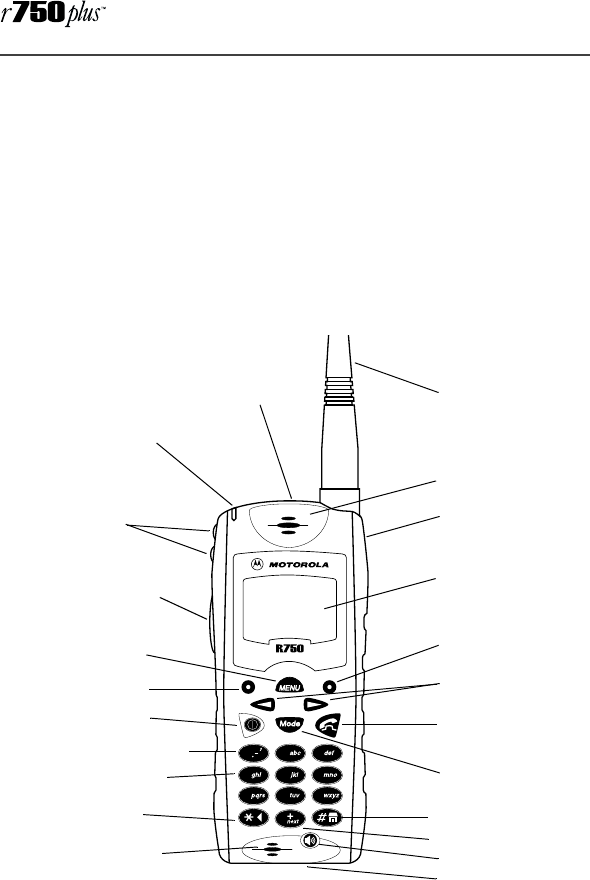
2
www.mot.com/iDEN
TTY Access
TTY access is available on your phone. See the Wireless Data Services
User’s Guide for complete instructions.
Large-Print Manuals
A large-print version of the phone’s User’s Guide is available. For
more information on Motorola products for people with disabilities,
contact Motorola Customer Care at 1-800-453-0920 or TTY 1-877-
483-2840.
Features of your r750plus Phone
* These features are available in the Net Mode browser.
** Emergency Call Key is orange; VibraCall® Alert key is black.
NOTES: Remove the plastic film lens protector from the display before
you use your phone for the first time.
Some keys have multiple uses. For more information, see the
Net Mode User’s Guide.
Press any key or button to turn on the keypad backlight.
12
3
5
4
789
6
0
Antenna
Earpiece
Rubber
Over-Mold
Grip
Alphanumeric
Display
Option Key
Scroll Keys
Send/End Key
Mode Key
* Home Key
* Next Key
Speaker Key
** Emergency Call Button (AFU only)
or
VibraCall® Alert On/Off Button
Status Light
Volume
Control/
List Buttons
Push-To-Talk
(PTT) Button
MENU Key
Option Key
On/Off Key
* Punctuation Key
Alphanumeric
Keypad
* Back Key
Microphone
Accessory Connector
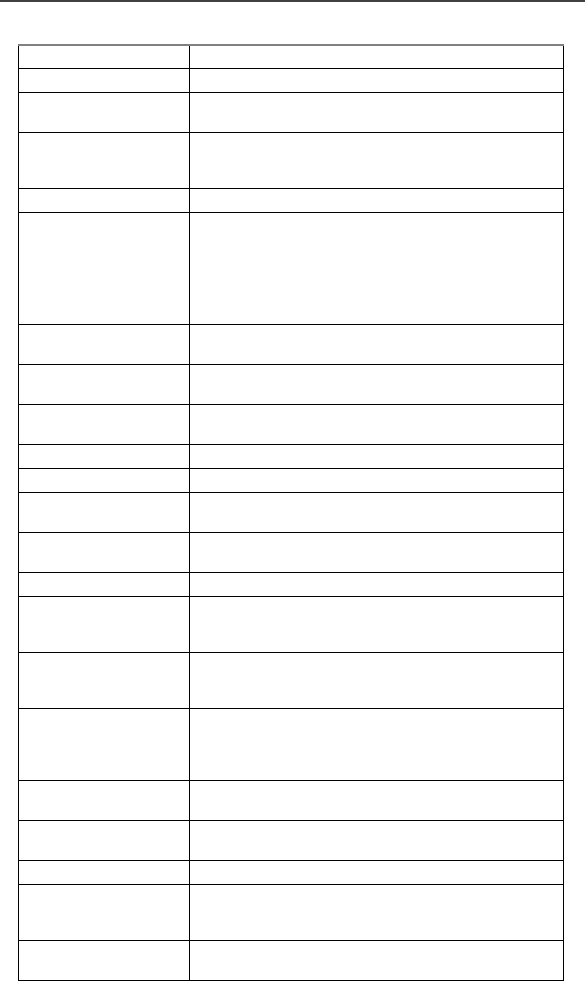
Welcome
3
Antenna Install for optimal signal.
Earpiece Hold to your ear to hear the other party.
Volume Control/
List Buttons
Press to adjust volume levels in Phone, Private,
and Group modes.
Push-To-Talk
(PTT) Button
Transmit a Private or Group Call, or a Call Alert.
Press and hold the PTT button to talk; release it
to listen.
Mode Key Press to change modes.
Emergency Call
Button
or
VibraCall® Alert
Button
Emergency Call Button: Activates Emergency
Group Call feature (see “Emergency Group
Call” on page 39).
VibraCall Alert Button: Turns on/off the
VibraCall Alert feature (see “VibraCall® Alert”
on page 15).
On/Off Key Press and hold to turn your r750plus phone on
or off.
Status Light Shows the phone’s status. See Table 2 on
page 5 for more information.
Punctuation Key Add punctuation in the Net Mode browser
(within T9™ Text Input).
Back Key Return to the previous browser screen.
Microphone Use to speak during calls.
Rubber Over-
Mold Grip
Hold the phone more securely and comfortably
with the rubberized grip.
Alphanumeric
Display
View up to four lines (12 characters per line) or
six lines (16 characters per line) on the display.
MENU Key Press to scroll through menu options.
Scroll Keys Press the left key to scroll backward or the right
key to scroll forward through menu options
and lists.
Option Keys Press the right or left option key to select the
menu option that appears in the display
directly above the key.
SEND/END Key Press to answer an incoming Phone call. After
entering a phone number, press to begin an
outgoing Phone call or to redial the entered
phone number. Press to end Phone calls.
Alphanumeric
Keypad
Enter telephone numbers, Private Call IDs, and
alphanumeric characters.
Next Word Key Press to display the next word choice in the
browser (within T9 Text Input).
Home Key Press to return to the browser Home menu.
Speaker Key Press to hear incoming calls through the
earpiece or the speaker during private and
group conversations.
Accessory
Connector
Connect battery charging, audio, and data
accessories.
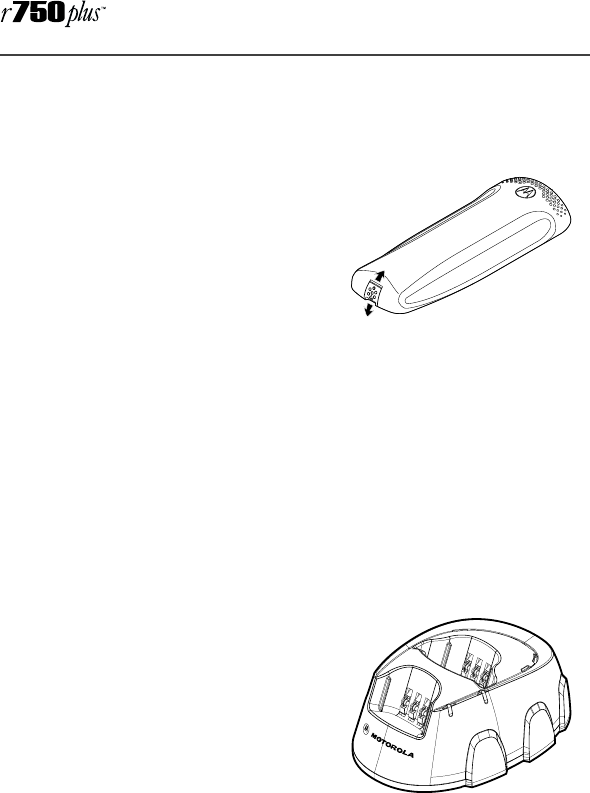
4
www.mot.com/iDEN
Attaching and Charging the Battery
Attaching the Battery
1. Insert the battery bottom-end first
into the battery guide holes on the
housing of the phone.
2. Push the battery forward into the
housing of the phone until it
securely locks.
Detaching the Battery
1. Press down on the battery release
button.
2. Pull on the battery and remove it.
Charging the Battery
You should charge your r750plus phone
battery overnight before initial use.
This allows your battery to achieve its maximum capacity and life.
Place the battery in the charger as
illustrated. You can also place the
r750plus phone in the charger with the
battery attached.
NOTE: For more information on charg-
ing the battery, see “Batteries”
on page 58.
Battery and Charging Status
A low battery is indicated by a short, chirp-like sound through the
speaker. The battery strength indicator icon shows the remaining
charge in your battery. Three bars indicates full charge. As the charge
is reduced through use, the bars progressively reduce from three to
two bars, then one bar, then disappear. The indicator flashes when
you have less than five minutes of talk time (see Table 1 ).
New Art to come
For Position ONLY
New Art to come
For Position ONLY
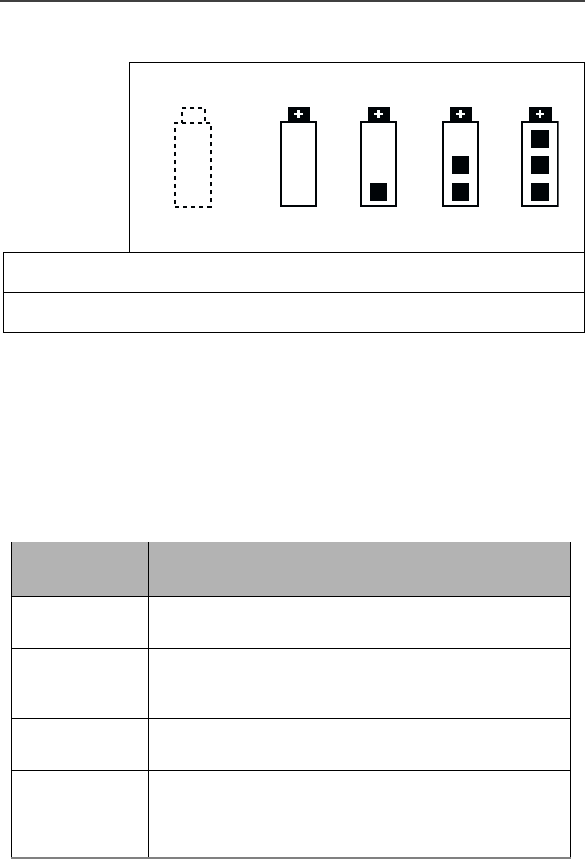
Welcome
5
Table 1: Battery Charging Status
Turning On Your r750plus Phone
Press and hold the On/Off button f until a set of icons appears on
your display. Next, a welcome message displays while the r750plus
phone connects to your carrier’s network.
The Status Light (LED) indicator on the r750plus phone shows the
service state. See Table 2 .
Table 2: LED Indicator
Turning Off your r750plus Phone
Press and hold the On/Off button f until you see the message
“Powering Off”.
Icon
Flashes
Charging Low Battery 0-
30%
31-
60%
61-
90%
91-
100%
Discharging Low Battery 0-
10%
11-
40%
41-
70%
71-
100%
Status Light
Indicator
r750plus phone status
Flashing
Red Registering—your r750plus phone is signing on
to your carrier’s network. Please wait.
Solid Red No service—your r750plus phone cannot sign
on because it is outside your carrier’s service
area.
Flashing
Green In service—your r750plus phone is ready to use.
You can now place and receive calls.
Solid Green In use—your r750plus phone is currently being
used.
To make sure that you ended the last call,
press e.
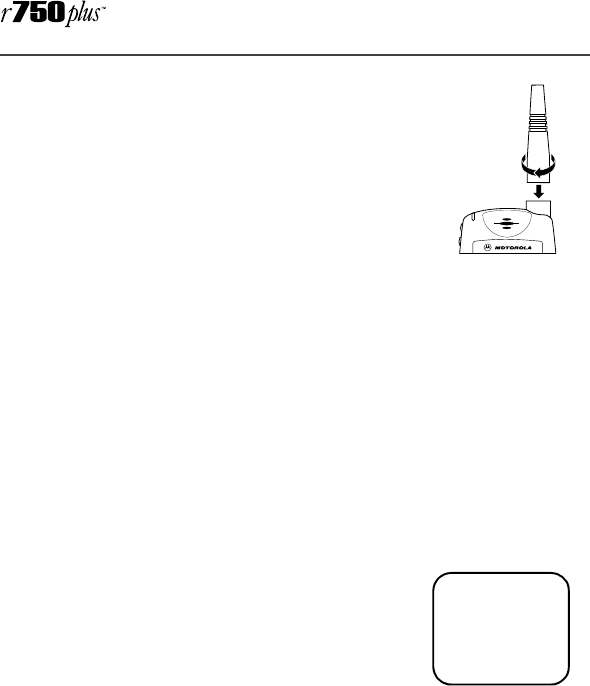
6
www.mot.com/iDEN
Installing Your Antenna
Turn your r750plus phone off before installing or
removing the antenna.
Insert the bottom of the antenna into the screw-in
base on the top of the r750plus phone. Turn
clockwise by hand until snug. Do not force.
Keypad Lock
The r750plus phone includes a Keypad Lock feature that enables you
to quickly lock the phone’s keypad to avoid inadvertently pressing
keys or placing calls. Once Keypad Lock is activated, you can only
perform the following tasks (unless you receive an incoming call,
page, etc.):
•Turn your phone On/Off
•Unlock the keypad
Activating Keypad Lock
Before locking your phone’s keypad, you may want to read this
entire section to learn how to respond to incoming calls, pages, etc.
From the Phone Ready screen, simultaneously
press * and #. The message Keypad Locked
displays on your phone.
NOTE: Whenever a key is pressed, while in Keypad
Lock mode, the “Keypad Locked” message
displays as a reminder.
Receiving Incoming Calls
When you receive an incoming phone call, keypad lock will be
temporarily disabled. You may perform the following:
Press e to answer the call. Or,
•Press o under “End” to send the call to voice mail and
reactivate keypad lock.
Receiving New Mail Messages
When you receive a new mail message (see “Using Mail Services” on
page 46 for more information), the keypad lock will be temporarily
disabled. You may perform the following:
adjb
Keypad
Locked

Welcome
7
•Press o under “Later” to return to Phone Ready and
reactivate the lock. Or,
•Press o under “Now”. Press o under “Read”. Press o
under “Save” or “Erase”. Once you have finished, press
o under “Exit” to return to Phone Ready and reactive
the lock.
NOTE: If you have disabled the Message Mail Notification feature, only
the c icon will display. You will not receive the read Now/
Later options.
Receiving Voice Mail
When you receive a new voice mail (see “Voice Mail” on page 47)
keypad lock will be temporarily disabled. You may perform the
following:
•When New Voice Mail Waiting displays, press o under
“Exit” to return to Phone Ready and reactivate the lock.
Or,
•Press o under “Dial” to access Voice Mail service. Once
you have finished, press # to exit Voice Mail, return to
Phone Ready and reactivate the lock.
NOTE: If you have disabled the Message Mail Notification, g icon
will display, however, “New Voice Mail Waiting” will not appear.
Receiving Private (Two-Way Radio) Calls
When you receive an incoming private (two-way radio) call (see
“Receiving a Private Call” on page 30) the phone will automatically
activate the applicable mode (i.e., Group, Private, etc.). Once the call
is terminated and the Display Timer has expired, the phone will
return to Phone Ready and reactivate the lock.
Deactivating Keypad Lock
From the Phone Ready screen, simultaneously
press * and #. The message Keypad Unlocked
displays on your phone.
Display Icons
Display icons appear on the screen to inform you of existing
conditions. See the following list.
adjb
Keypad
Unlocked
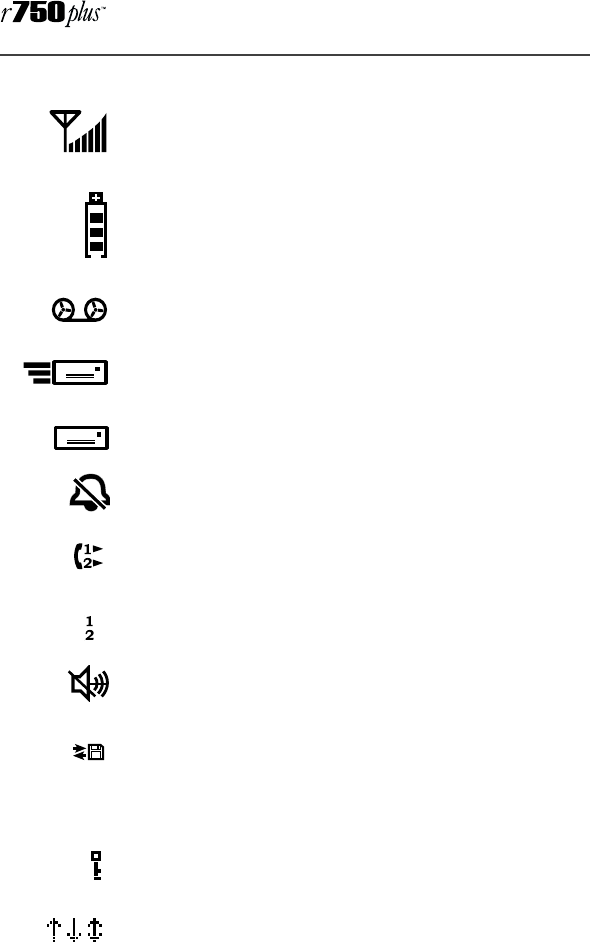
8
www.mot.com/iDEN
The following icons may appear along the top of the display.
Signal Strength Indicator
Shows the signal strength. Six bars indicate the
strongest signal. Calls and messages may not be sent
or received in no-signal areas.
Battery Strength Indicator
Shows the remaining charge in your battery. Three
bars show full charge. The indicator flashes when
you have less than five minutes of talk time
remaining.
Voice Mail
Indicates that unplayed messages are waiting in your
voice mail box.
New Message Mail
Indicates that you have new text messages in your
mail box.
Unread Message Mail
Indicates that you have unread Message Mail.
Vibrate All
Indicates that the Vibrate All option is turned on. You
will not hear a ring tone.
Call Forward
Indicates that incoming phone calls are being
forwarded.
Active Line Indication
Displays the active phone line (1 or 2).
Private/Group Speaker
Indicates that the Private/Group speaker is off. You
will hear calls through the earpiece.
Packet Data
Indicates packet data registration. The blinking
arrows indicate send and receive activity. For more
information, see the Wireless Data User’s Guide.
Some of the following icons may appear in the browser.
Secure Packet Data Connection
Indicates that your packet data information is
encrypted during transmission.
More Information
Indicates that there is more text to read above,
below, or above and below the current screen.

Welcome
9
About Modes and Menus
Modes and menus are the navigational tools, providing access to the
various features of your r750plus phone. Pressing the Mode key m
takes you through the mode choices. Pressing the Menu key n
takes you through the menu options within each mode.
There are four modes:
•Phone—for cellular phone calls. See Page 12.
•Private—for one-to-one radio calls. See Page 30.
•Group—for radio calls with all individuals in a designated
talkgroup. See Page 34.
•Net—for browser use. See the Net Mode User’s Guide.
To change modes:
Press m until you see the desired mode.
To select menu options:
Press n until you see the desired menu option, then press o under
the desired menu option to select it.
Setting the Time and Date
If your carrier provides this option, you can set your phone to
display the current time and date. Unless the phone is turned off, it
continues to display the current time during a loss of service.
You have a choice of a 12- or a 24-hour clock format. See Table 3.
NOTE: When this feature is activated, your phone automatically dis-
plays local time.
Table 3: Time Display Options
12-Hour Display 24-Hour Display
12:00a 00:00
6:25a 06:25
12:00p 12:00
6:25p 18:25
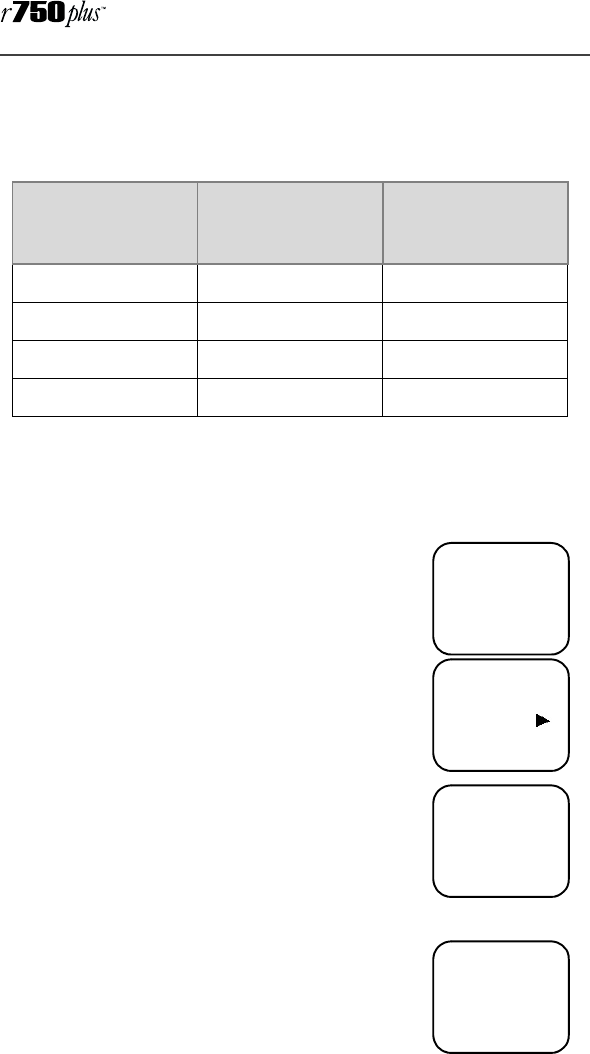
10
www.mot.com/iDEN
You have a choice of either a MM/DD (month/day) or a DD/MM
(day/month) date format. See Table 4:.
If your carrier activates the time and date, they are displayed on the
third line in all modes (Phone, Private, Group, Net). The time of day
is also shown during an active Phone call. The time and date are not
displayed in Group mode when you select an Area option.
To set the time and date format:
1. Press *, #, 7, 1.
2. Select “Ok”. The Time/Date screen displays.
The default (preset) time and date format that
displays depends on your carrier. You can accept
the default format or select an alternate format.
3. Press r until you see the
Time Format screen.
4. Do one of the following:
• To use the 12-hour format, go to the
next step.
• To use the 24-hour format, select
“24hr”. (See Table 3 on page 9.)
5. Press r until you see the
Date Format screen.
6. Do one of the following:
7. To use the MM/DD format, select “Exit”.
Table 4: Date Display Options
Date
Month/Day
Format
(MM/DD)
Day/Month
Format
(DD/MM)
January 2nd 01/02 02/01
January 31st 01/31 31/01
October 9th 10/09 09/10
December 31st 12/31 31/12
adjb
71=Time/
Date
Exit Ok
adjb
71=Time/
Display:On
Exit Off
adjb
Time Format
12 Hour
Exit 24hr
adjb
Date Format:
MM/DD
Exit MM/DD
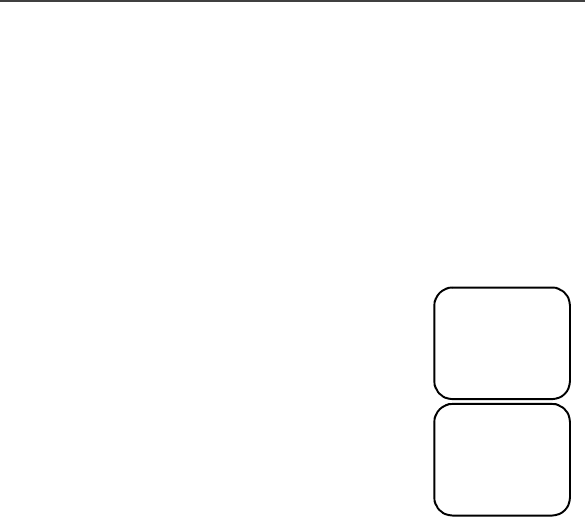
Welcome
11
8. Or to use the DD/MM format, select “DD/MM”, then “Exit”. (See
Table 4 on page 10.)
9. Select “Exit” again to leave the Time/Date Programming option.
The Ready screen for each mode (Phone, Group, Private, and
Net) now displays the selected time and date formats.
Changing the Display Language
You can customize your r750plus phone to display one of four
languages: English, French, Spanish, or Portuguese.
To change the displayed language:
1. Press *, #, 7, 0.
2. Select “Ok”.
Press l or r to scroll through the language
options.
Selecting “Exit” at any time retains the current lan-
guage selection.
3. When the desired language appears on your
display, select “Ok”. The displayed text imme-
diately changes to the selected language.
4. Select “Exit”.
The language that you select will be the displayed language.
Selectable Backlight Timer
Your phone’s backlight is what illuminates the display when you, for
example, first receive or make calls. Through your Programming
Menu (*,#,16), you can customize the amount of time that your
backlight remains illuminated: 0, 10, 20, or 30 seconds. By choosing
zero (0) seconds, all keypad backlighting, and the Status Light,
remains off (is disabled). This means, when choosing 0 seconds, the
r750plus phone enters completely dark mode. See “Setting Programming
Menus” on page 51 for more information.
adjb
70=Language
English
Exit Ok
adjb
Language
Français
Cancl Ok
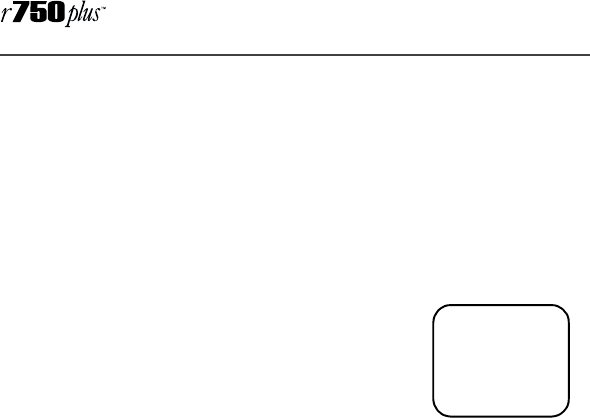
12
www.mot.com/iDEN
Making Phone Calls
In addition to making and receiving phone calls in Phone mode, you
can forward calls, use call waiting, put calls on hold, and create and
use stored lists. Phone Ready is the main screen.
NOTE: See “Additional Phone Services” on page 19 for more informa-
tion.
You can place a call by entering the phone number on the keypad.
1. From the “Phone Ready” screen, using the
keypad, enter the desired number.
If you make a mistake, press l once to move
back one digit, or select “Cancl” to start over.
2. Press e to place the call.
3. To end the call, press e .
Using Other Dialing Methods
To use other dialing methods such as Scroll, Speed Dial, or Name
Search, names and numbers must be programmed into your phone. See
“Creating, Editing, and Using Stored Lists” on Page 24.
Scroll
1. From the Phone Ready screen, press l or r to scroll backward
or forward through the stored list of numbers and names.
2. Press e to place the call.
3. To end the call, press e.
Speed Dial
1. From the Phone Ready screen, press n until you see the “Spd#”
option on the last line of your display.
2. Select “Spd#”.
3. Enter the assigned speed-dial number (1-100). You will see the
stored name and phone number associated with the speed dial
number.
4. Press e to place the call.
5. To end the call, press e.
adjb
Phone Ready
Line1
Exit Ok
10:42a 11/06

Making Phone Calls
13
Name Search
1. From the Phone Ready screen, select “Name”.
2. Using the keypad, enter the first letter of the desired name, for
example, to search for the name Bob:
3. Enter “B” by pressing 2 twice.
4. Press r to scroll through all the names starting with “B” until
you see “Bob”.
5. Press e to place the call.
6. To end the call, press e.
Emergency Dial
You can dial the emergency phone number even if the keypad is
locked. If you are on an active call, you must end it before using the
emergency number.
1. From any mode (Phone, Private, Group, or Net), press and hold
9 for two seconds until the phone displays “EMERGENCY”.
The phone then automatically dials the emergency number.
2. To end the call, press e. The emergency phone number will not be
saved as the last number dialed.
NOTE: For more information on the Emergency Dial feature, contact
your carrier.
Automatic Redial
If you receive a “System Busy, Try Later” message, press e to have
your phone automatically redial the number. You will hear a ring-
back tone when the call is successful.
Last Number Redial
To redial the last number that you called, press e.
Turbo Dial® Key
Turbo Dial key enables you to quickly place a phone call by simply
pressing and holding the numeric key on the keypad that
corresponds to the stored entry in your Phone list directory. There
are eight Turbo Dial positions, 1 through 8.
NOTE: If you are on a Phone call, place the call on hold before using
Turbo Dial key.
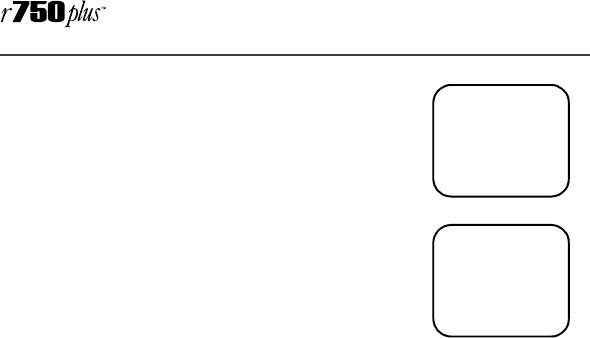
14
www.mot.com/iDEN
From the Phone Ready screen:
1. Select one of the first eight entries in the
Phone list using key numbers 1 through 8. For
example, press 1 for speed dial #1. Keypad
numbers 0 and 9 are not available for Turbo Dial-
ing.
2. Press and hold the desired key for two seconds
to activate the Turbo Dial key. The phone
begins to dial the number and “Phone Ready”
changes to “Phone-In Use”.
Plus Dialing
This feature enables you to place an International call from any
country -- without entering the local international access code.
1. Press and hold 0 for two seconds. A “0” appears, then changes
to a “+” that precedes the appropriate international access code
needed to place the call.
2. Enter the international telephone number.
3. Press e.
Hands-Free Speakerphone
The r750plus phone provides the convenience of a speakerphone for
holding impromptu meetings or listening to your voice mail
messages.
During speakerphone operation, you may either speak or listen, but
you cannot do both at the same time.
To use the speakerphone:
1. Select “Spkr.” The “Spkr” option flashes while the speakerphone
is on.
2. Place the phone 15-30 inches (38-76 cm) away from you. In a
noisy environment, you may want to move the r750plus phone
closer to you for better transmission.
NOTE: If there is background noise in your area, you may have diffi-
culty hearing a caller’s voice or messages. To resolve this prob-
lem:
(1) Press n until you see the “Mute” menu option.
(2) To listen, press o under “Mute”. The display changes from
“Phone-In Use” to “Phone-Mute”, indicating that the micro-
phone is muted.
adjb
Phone Ready
1
Cancl
adjb
Phone-In Use
Office
12:45p 10/18
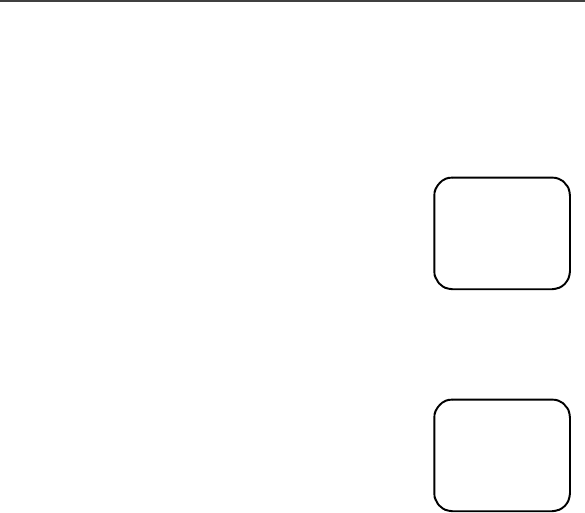
Making Phone Calls
15
(3) To speak, pressounder “Mute” again. The display changes
from “Phone-Mute” to “Phone-In Use”, indicating that the
microphone is on.
While the microphone is muted, you can hear incoming audio,
but a caller cannot hear any speech coming from your r750plus
phone.
Receiving a Phone Call
Press one of the following keys: e, or *, or #.
Or press any numeric key (0 through 9). To
activate the speakerphone option, select “Spkr.”
Ending a Phone Call
Press e.
What Is My Phone Number?
Press *,#,1 to display your own phone
number.
VibraCall® Alert
VibraCall Alert is a vibration alert system that
notifies you of incoming Messages, Phone, Private, Group, and Data
calls. You can set a vibration alert for all services or for individual
services.
When you set vibration alerts, they are set only for the current line.
If you have a second phone line, you must select that line and repeat
the procedure for selecting all services or selecting individual services
to vibrate.
The alert choices are:
•Vibe All—produces a vibration alert for all incoming calls and
messages.
•Phone Vibrate—produces a vibration alert for incoming phone
and circuit-data calls.
•Phone Vibrate/Ring—produces a vibration alert followed by a
ring tone for phone and circuit-data calls.
•Mail Vibe—produces a vibration alert for mail messages and net
alerts.
•Group/Prvt Vibe—produces a vibration alert for incoming group
and private calls.
NOTE: If VibraCall Alert is set for incoming calls and messages, the
power-up sequence includes a brief vibrate cycle.
adjb
Incoming
End
Phone Call
Spkr
adjb
1=Own Ph#
9545553434
Exit Edit
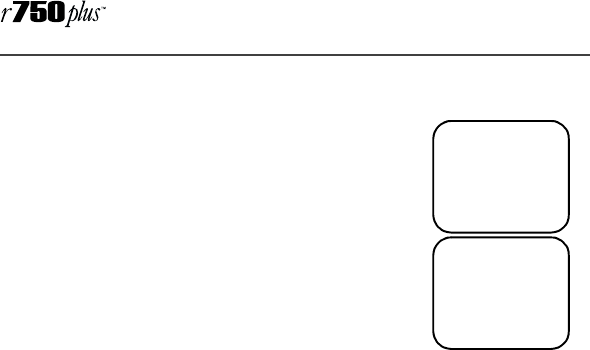
16
www.mot.com/iDEN
Selecting VibraCall Alert for All Incoming Calls and Messages
Advanced Feature Units (orange button on top of
housing): To set a vibration alert for all incoming
calls and messages:
1. Press*,#,9.
2. Select “All”. You will receive a brief vibration
alert.
After you set the alert, the display returns to the
previous mode and q (the Vibrate All icon)
appears at the top of your display.
All Other (Non-Advanced Feature) Units (black button on top of housing):
Perform the same steps as described above, or press the black button
on top of the r750plus phone.
adjb
9=Vibrate
Alert:Off
Exit All
aqjpb
Phone Ready
Line1 Vibe
Name Mail
10:54a 12/09
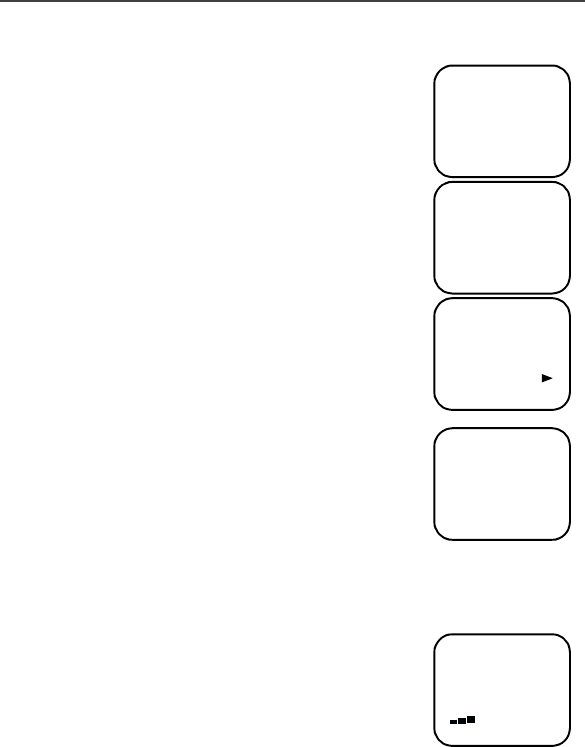
Making Phone Calls
17
Selecting VibraCall Alert for Individual Services
To set a vibration alert for specific phone or mail
services:
1. Press *,#,9.
2. Press n until you see the
“Selct” menu option.
3. Select “Selct”. The first choice is Phone
Vibrate.
4. To view the Vibe/Ring vibration alert choices,
press n on the keypad.
5. To view other choices, press r.
• To receive vibration alerts only for Mail,
select “Mail Vibe”, then select “On”.
• To receive vibration alerts for Group
and Private calls, select “Vibe”, then
select “On”.
6. Select “Exit” to return to the Vibrate Alert
menu.
7. Select “Exit” again to return to the previous
mode.
Setting the Ringer Volume
You can adjust the ringer volume for incoming calls. If you have a
second phone line, you must set each line separately. Be sure to
select the desired line before setting the volume.
1. Press *, #, 3, 0. The “30=Ringer Vol-
ume” screen displays.
The display shows your current ringer volume.
2. Press the Volume Control buttons on the side
of the phone to listen as you raise or lower the
volume. At the lowest setting, the screen dis-
plays “Volume Silent”.
3. When you reach the desired level, select “Exit”.
Selecting a Ring Style
Your phone has nine selectable ring styles. Phones with two phone
lines can use the same or different ring styles for each phone line.
Incoming circuit data calls have a unique, preset ring style which
you cannot change.
adjb
9=Vibrate
Alert:Off
Exit All
adjb
9=Vibrate
Alert:Off
Selct
adjb
Phone
Vibrate:
Exit Vibe
Vibrate Off
adjb
Group/Prvt
Vibe:Off
Exit On
adjb
30=Ringer
Volume
Exit
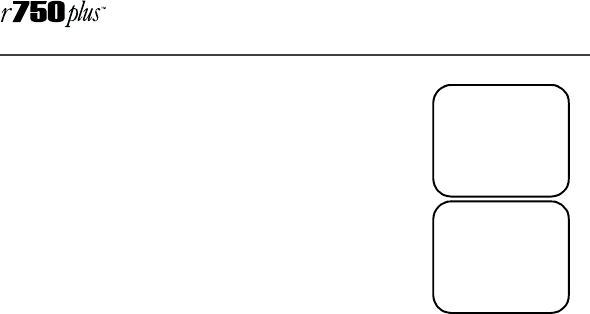
18
www.mot.com/iDEN
Setting a Ring Style
1. Press *, #, 3, 1.
1. The display shows your current ring style.
2. Select “Ok”.
3. Press l or r to scroll through the available
Ring Styles.
4. To listen to the selected ring style, press the
Volume buttons on the side of the phone.
5. Select “Ok” to select the Ring Style shown.
To leave the ring style unchanged, select “Cancl”
6. Select “Exit”.
Setting a Ring Style for the Alternate Line
1. From the Phone Ready screen, press n until you see “Line2”.
2. Select “Line2”.
3. Repeat the procedure for "Setting a Ring Style", above.
adjb
31=Set Ring
Style:1
Exit Ok
adjb
Ring
Style 4
Cancl Ok
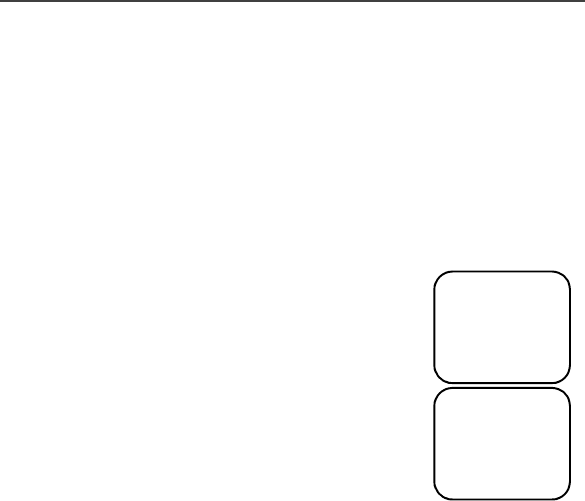
Additional Phone Services
19
Additional Phone Services
NOTE: Some features may be network dependent or subscription only,
and may not be available in all areas. Contact your service pro-
vider for more information.
Call Waiting
Using the Call Waiting feature, you can answer an incoming call
when you are on another call. Call Waiting is on unless you turn it
off for a particular call.
1. After the alert tone, your display shows the
incoming number and asks “Accept Call?”. To
accept the call, select “Yes ”. To decline the call,
select “No”.
2. Press n, then select “Hold” to place the sec-
ond call on hold and return to the first call.
Selecting “Hold” switches you between the two
calls.
3. To end the active call, press e.
Turning Off Call Waiting
You can turn off Call Waiting if you do not want to be interrupted
during a call.
1. Press n until you see “Wait”, then select “Wait”.
2. Select “Off”. Call Waiting will be disabled for one call—but will
automatically reset to “On” after that call.
Call Hold
When you are on a call, you can place the call on hold and make a
second call.
1. To place the active call on hold, press n, then select “Hold”.
You may then answer or place another call.
2. To remove the call from hold, press n, then select “Hold”
again.
adjb
5551212
Take Call
No Yes
On Line 1
adjb
Call 1-Hold
5551212
Hold Name
10:54a 12/09
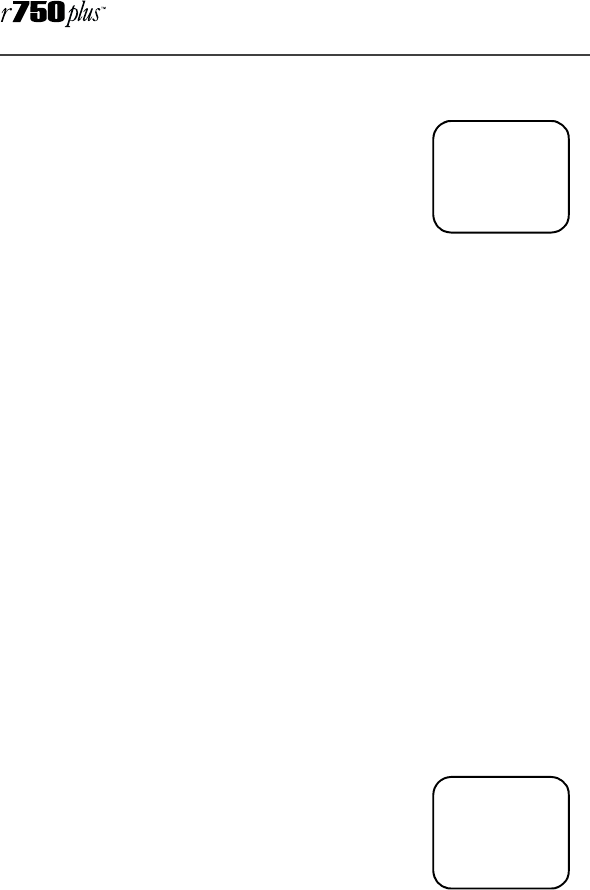
20
www.mot.com/iDEN
3-Way Calling
If your carrier provides 3-way calling, you can
combine two ongoing phone calls into one
conversation. This option is available only when
you initiate the second call.
After you place or receive a phone call:
1. Select “3way”. This action places the current call on hold.
2. Enter the phone number for the second call and press e.
3. When the second call is connected, select “3way” to join the
calls. Both phone numbers and “3way” appear on your screen.
4. To end the 3-way call, press e.
Alternate Phone Line
If your phone is activated with two phone lines, you can switch
between them. To change phone lines, your phone must be at the
Phone Ready screen. The following settings are independent for each
phone line. When you enable a setting, it applies only to the active
line.
• Ringer Volume
• Auto Answer
• One-minute Beep
• Automatic Display Timer
• Resettable Timer
• Total Call Timer
• Selectable Ring Styles
• Call Forwarding
Setting the Active Line
At the “Phone Ready” screen:
1. Press n until you see “Line2”. (If you are on
Line 2, you will see “Line1”.)
2. Do one of the following:
• Select “Line2” to activate Line 2 when
Line 1 is the active line.
• Or, select “Line1” to activate Line 1 when Line 2 is the
active line.
Outgoing calls will be made on the selected line.
adjb
Phone-In Use
5551212
Hold 3way
10:42a 11/06
adjb
Phone Ready
Line1
Line2
11:48a 08/21
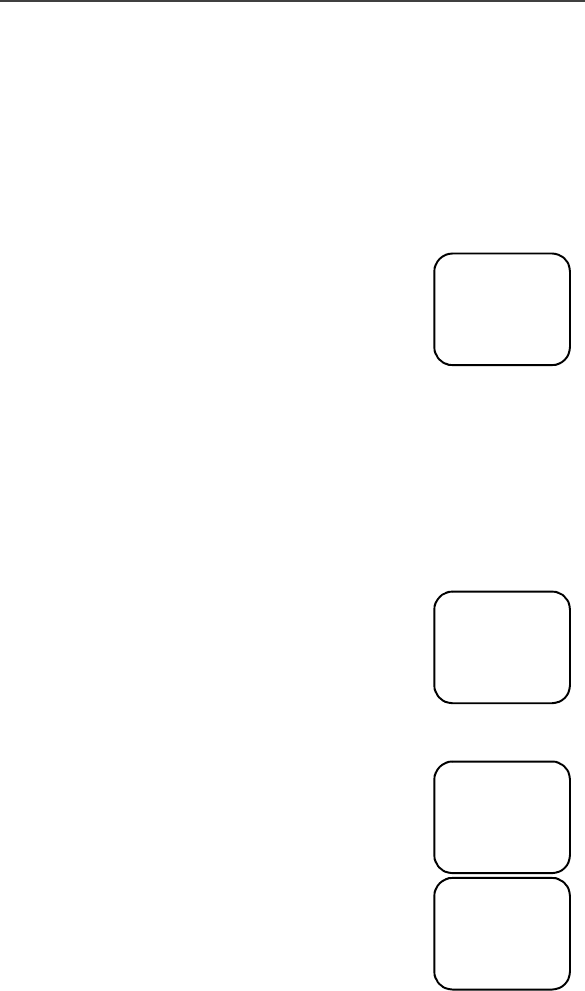
Additional Phone Services
21
Receiving a Call
You can receive calls on either line, regardless of the active line
setting.
•If you receive a call on the currently active line, that icon simply
flashes.
•If you receive a call on the line that is not currently active, the
active line icon remains lit and the alternate line icon flashes.
Receiving a Call on Your Alternate Line
1. Select “Yes ” to answer the call on the other
line. Your previous call will be placed on hold.
2. Do one of the following:
• To end the call, press e.
• Or, to place the current call on hold, or
to toggle between calls, press n, then
select “Hold”.
When the call ends, the phone remains active in the last active line
selected.
Receiving a Phone Call Using Speakerphone
Select “Spkr” to activate the speakerphone.
Missed Call Indicator
Your r750plus phone notifies you of received, but
unanswered, phone calls. If you subscribe to Caller
ID, the caller’s phone number is stored in your
Last 10 Calls Received list. Your screen displays a
flashing message, for example, “2 Rcvd Calls”,
with the number of missed calls.
Press any key to clear the flashing indicator.
To retrieve the missed calls:
1. From the Phone Ready screen, press n. The
menu options change to “Calls” and “Spd#”.
2. Select “Calls”. The Rcvd Calls screen opens
with the number, time, and date of the last
call that you received.
3. Scroll to continue viewing the list.
adjb
3055551212
Accept Call
No Yes
On Line 2?
adjb
Phone Ready
Line1
Name Mail
2 Rcvd Calls
adjb
Phone Ready
Line1
Calls Spd#
10:42a 11/06
adjb
Rcvd Calls
1=5552222
Cancl Store
10:42a 11/06
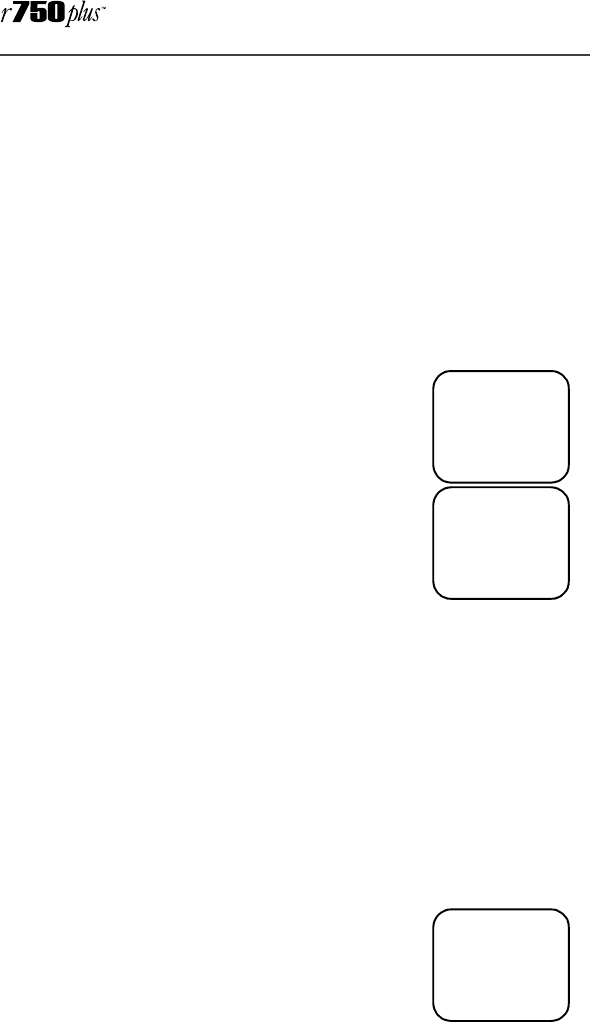
22
www.mot.com/iDEN
Call Forwarding
Call forwarding lets callers reach you wherever you are. You have
two options: forward all incoming calls (unconditional) or select
those circumstances (conditional) when you want your calls
forwarded.
Unconditional Call Forwarding
Unconditional call forwarding sends all incoming calls to the
designated number.
NOTE: When you set unconditional call forwarding, your phone does
not ring.
1. From the Phone Ready screen, press n until
you see “Forwd” on the last line of the dis-
play.
2. Select “Forwd”.
3. To select the number where you want your
calls forwarded, do one of the following:
• Enter a number.
• Or, press the scroll keys to select a
number from your stored list.
4. Select “On”.
5. After the “Please Wait” message displays, select “Exit”.
6. Notice that the Call Forward icon z appears on your display
when Unconditional Call Forwarding is set.
Conditional Call Forwarding
You may want to forward your calls when your r750plus phone is:
• Busy on another call or accessing the browser (Busy)
• Not answered (NoAns)
• Outside the service area (NoRch).
NOTE: You must turn off Unconditional Call Forwarding before you can
set Conditional Call Forwarding options.
1. From the Phone Ready screen, press n until
you see “Forwd” on the last line of your dis-
play, then select it.
adjb
Phone Ready
Line1
Forwd Spd#
9:06a 9/03
adjb
Forwd:Off
To:5551212
Exit On
adjb
Phone Ready
Line1
Forwd Spd#
9:06a 9/03
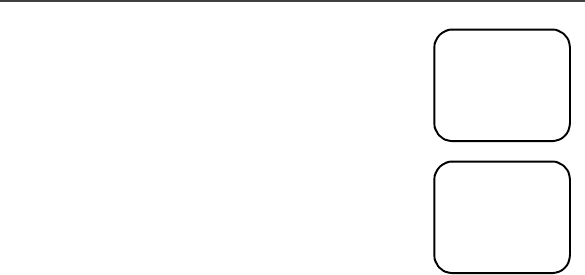
Additional Phone Services
23
2. Press n once again until you see “Busy” and
“NoAns” on the last line of your display.
3. To forward your calls when your phone is in
use, select “Busy”.
4. To forward your calls when you do not want
to answer them, select “NoAns”.
5. Press n again until you see “NoRch” and
“Rcl#”.
• To forward your calls when you cannot
be reached, select “NoRch”.
• To see the call forward number, select
“Rcl#”.
6. After you select the call forward option, either enter the number
where you want your calls to be forwarded, or press the scroll
buttons and select a number.
7. Select “On”.
8. Select “Exit”.
9. You can set more than one condition by repeating steps 2
through 6.
adjb
Forward:Off
To:
Busy NoAns
adjb
Forward:Off
To:
NoRch Rcl#

24
www.mot.com/iDEN
Creating, Editing, and Using
Stored Lists
A stored list is a directory of phone numbers and Private IDs and
their related names. Stored lists are convenient because you do not
have to remember names and numbers—you simply scroll through
your stored list.
Combined Phone Number and Private ID List
You can set a combined Phone and a Private ID with the associated
name, which eliminates the need to program the Private ID
separately. You can add up to 100 numbers to your Phone list, store
them with names, and assign them to speed-dial numbers.
Entering Numbers
To enter a number, press the corresponding key on the keypad.
Entering Names
To enter a letter, press the key the required number of times, which
is related to the letter’s position on the key. Table 5 describes how to
enter each letter on the 7 key.
Table 5: Entering Letters and Numbers on the
Keypad
To shift to lowercase letters, press and hold # after a letter is
entered.
To enter: Press 7
P once.
Q twice.
R three times.
S four times.
7 five times.
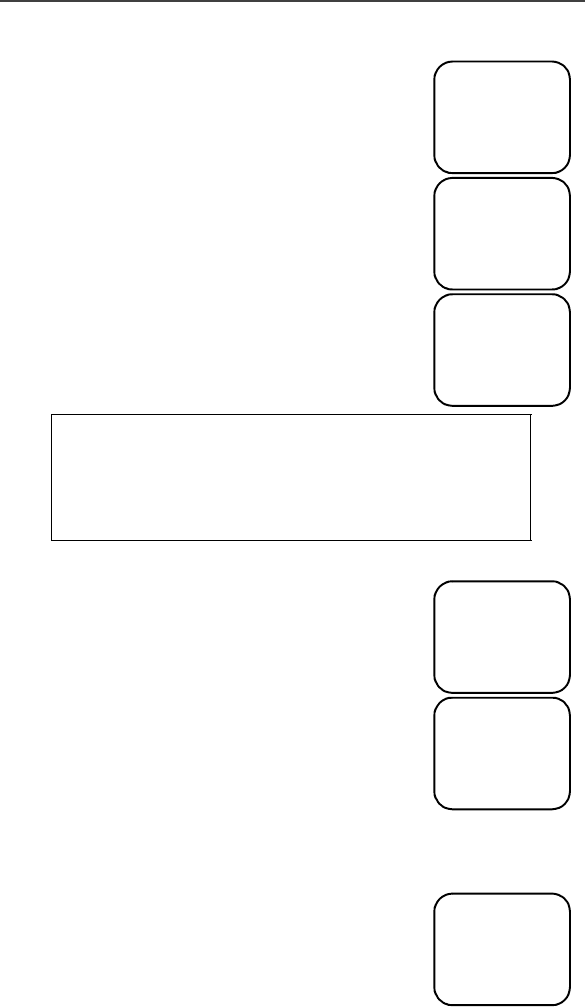
Creating, Editing, and Using Stored Lists
25
Storing Names and Numbers
1. Press *,#,2,0.
2. Select “Ok”.
The next screen briefly displays the remaining
number of phone numbers and private IDs that
you can store.
3. Enter the name that you wish to store.
Select “Store”.
See Figure 1 . for an example of entering a name.
Figure 1. Entering a Name
2. Enter the phone number that you want to
associate with this name and select “Store”.
To skip the Phone Number entry, select “Skip”. You
will go directly to the “Enter Prvt ID Number” screen.
The next screen displays the name that you
entered and a flashing speed-dial number where
the entry will be stored.
3. Do one of the following:
• To accept the speed-dial number shown,
select “Store”.
• To change the speed-dial number, enter
the desired speed-dial number. The speed-
dial number stops flashing.
4. At the next screen, enter the Private ID num-
ber associated with the name that you entered
then select “Store”.
To skip the Private ID number entry, select “Skip”.
Example
To store the name “TIM”:
1. Enter “T” by pressing 8 once.
2. Enter “I” by pressing 4 three times.
3. Enter “M” by pressing 6 once.
adjb
20=Phone/
Prvt List
Exit Ok
adjb
Available
98 Phone #
3 Prvt IDs
adjb
Enter Name
-
Exit Store
adjb
Enter Phone
Number
Skip Store
adjb
Tim
Spd#=3
Cancl Store
adjb
Enter PrvtID
Skip Store

26
www.mot.com/iDEN
Pause Digit Entry
When storing a number, you can program your phone so that it will
not only dial a number but also pause and enter another series of
numbers such as a personal identification number (PIN) or password.
This feature is particularly useful for automated services such as voice
mail and banking systems.
Here’s how it works. Let’s say you have a company voice mail
account that you frequently check while on travel. And, to access
that account you must do the following:
•Dial your work number;
•Press * while the voice mail greeting is being played; and
•Enter your PIN to access your messages.
You can program your r750plus phone to enter all of the above
information for you. All you have to do is separate each entry with a
pause. If you were to program your phone to input the above
information, the stored data would look like this:
17035551234P1234. In this example, the first eleven digits represent
the number that must be dialed to access your voice mail. The P
represents a 3 second pause. The last four digits represent your PIN.
You can use this feature not only to enter PINs and passwords but
also to have the phone automatically select menu options (i.e., press
1 to hear messages).
To create a three-second pause follow the steps below:
•Press and hold * for two seconds. The pause symbol (P)
will appear.
NOTE: You can enter up to 20 numbers/characters in a single entry,
stored or dialed. If you use a system that will not let you enter an
option until the automated message has played in its entirety,
you can program your phone to pause for more than 3 seconds.
For example, performing the above step twice will program two
pauses and cause your phone to wait 6 seconds before entering
the next set of numbers.
Editing and Erasing Phone List Entries
1. Press *, #, 2, 1.
2. Select “Ok”. The “Edit Entry?” screen displays.
3. Do one of the following:
a. To edit an entry, select “Ok”.
(1) At the “Edit Entry” screen, press r until the desired entry
appears, then select “OK.
(2) At the “Edit Number” screen, edit the phone number, if you
wish, then select “Store”.

Creating, Editing, and Using Stored Lists
27
(3) At the “Edit Name” screen, edit the name, if you wish, then
select “Store.
(4) At the “Edit Spd#” screen, edit the speed number, if you
wish, then select “Store”.
b. To erase an entry:
(1) At the “Edit Entry” screen, press l or r.
(2) At the “Erase Entry” screen, select “Ok”.
(3) Scroll to the desired entry, then select “Ok”. At the “Erase
Entry?” screen, select “Yes”.
4. Select “Exit” to close the Phone List Edit screen.
Editing and Erasing Private ID List Entries
1. Press *, #, 2, 2.
2. Select “Ok”. The “Edit Entry?” screen displays.
3. Do one of the following:
a. To edit an entry, select “Ok”.
(1) At the “Edit Entry” screen, press r until the desired entry
appears, then select “OK.
(2) At the “Edit ID” screen, edit the number, if you wish, then
select “Store”.
(3) At the “Edit Name” screen, edit the name, if you wish, then
select “Store”.
b. To erase an entry at the “Edit Entry” screen, press l or r
once, then select “Ok”. Press r to scroll to the desired entry,
then select “Ok”. At the “Erase Entry?” screen, select “Yes”.
4. Select “Exit” to close the Private ID List Edit screen.
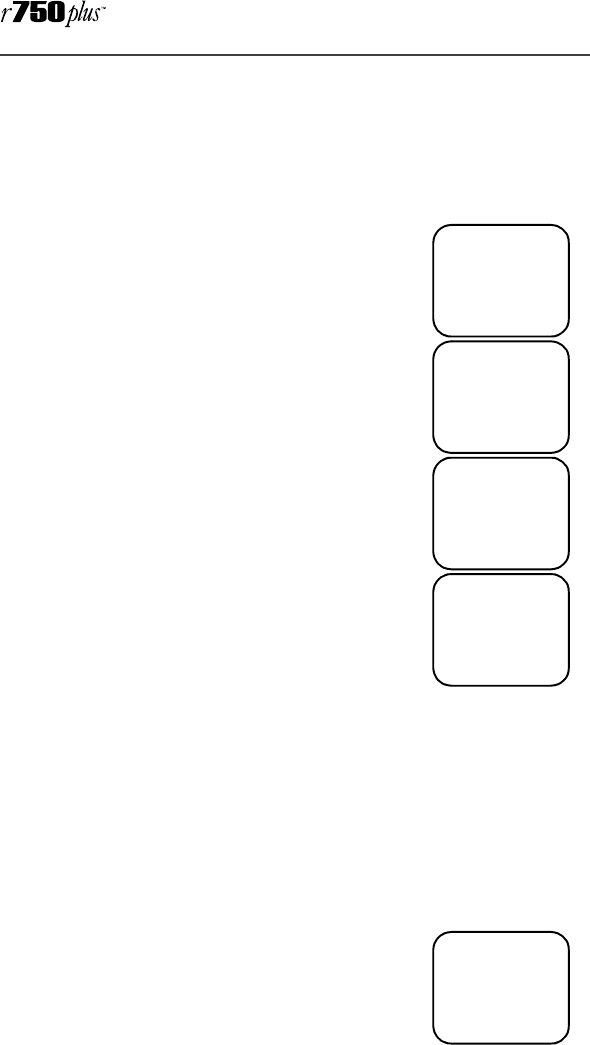
28
www.mot.com/iDEN
Last 10 Calls Received and Sent Lists
If you subscribe to your carrier’s Caller ID service, you can view, dial,
and store the list of the last ten phone numbers received and the last
ten phone numbers dialed.
The most recent call sent or received appears first in your call list.
From the Phone Ready screen:
1. Press n. The menu options change to “Calls”
and “Spd#”.
2. Select “Calls”. The Rcvd Calls screen opens.
If the “Store” option appears, the number currently
displayed is not in your Phone list. To add the num-
ber to your list, select “Store”.
If you want to see the Sent list but the “Store” option
is on your display, press n until you see the “Sent”
menu option.
3. Do one of the following:
• To view the Calls Received list, use the
Scroll key to view each entry.
If the “Store” option is on your display, press n
until you see the “Rcvd” menu option.
• Or, to view the Calls Sent list, select
“Sent”. Use the Scroll key to view each
entry.
4. To view the Calls Received list again, select
“Rcvd”.
5. To close the Calls list, select “Cancl”.
Quickstore of Phone Numbers
If you subscribe to your carrier’s Caller ID service, you can use
Quickstore to store the last number that you dialed or quickly store a
number from the Last 10 Calls Received and Sent Lists without
having to enter the programming menu.
NOTE: As you scroll through the Last 10 Calls Received or Sent List, only
the name displays. If the name is not available, the phone num-
ber displays.
To use Phone Number Quickstore, from either the
Phone Ready screen or from the Last 10 Calls
Received or Sent List:
1. Do one of the following:
• To go to the last call that you dialed,
press r.
adjb
Phone Ready
Line1
Calls Spd#
12:55p 10/18
adjb
Rcvd Calls
1=5554444
Cancl Store
12:55p 10/18
adjb
Rcvd Calls
2=MAILBOX
Cancl Sent
12:56 10/18
adjb
Sent Calls
1=JOHN
Cancl Rcvd
12:56p 10/18
adjb
Phone Ready
Line1
Name Mail
12:43p 07/22

Creating, Editing, and Using Stored Lists
29
• To view the Received and Sent Calls list,
press n until you see “Calls”, then select it.
2. Select “Store”. The Enter Name screen dis-
plays.
3. Enter the name then select “Store”.
The combined name and number entry is stored in
the first available storage space.
The Stored message displays with the name that
you stored.
adjb
Phone Ready
0=5554455
Cancl Store
adjb
Enter Name
-
Cancl Store
adjb
JOHN
5551212
Stored
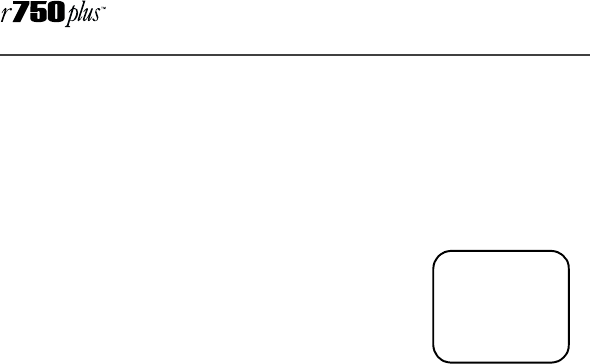
30
www.mot.com/iDEN
Making Private Calls
A Private call is a one-to-one conversation between two people. In
Private mode, each phone is identified by a name or a number called
a Private ID.
To make a Private Call:
1. Press m until you see “Prvt Ready” on your
display.
2. Use the keypad to enter the Private ID of the
person that you want to reach.
3. To speak, press and hold the PTT button, wait
for the chirp, then speak into the micro-
phone.
4. To listen, release the PTT button.
To use Scroll or Name Search, you must have a Private ID list.
Scroll
1. Press m until you see “Prvt Ready” on your display.
2. Press l or r to scroll through the stored Private ID list.
3. Press and hold the PTT button, wait for the chirp, then speak
into the microphone.
Name Search
1. Press m until you see “Prvt Ready” on your display.
2. Select “Name”.
3. Press the key with the first letter of the name you are searching
for.
4. Press l or r to scroll through other stored names associated
with the letter you entered.
5. Press and hold the PTT button, wait for the chirp, then speak
into the microphone.
Receiving a Private Call
When you receive an incoming Private call, you hear a brief chirp-
like tone. Your r750plus phone automatically switches to Private
mode, and the Private ID or the name of the caller displays.
1. Your phone must be idle, that is, not busy in an active call or on
the browser.
2. Wait for the caller to finish speaking.
3. Press and hold the PTT button. Begin speaking after you hear the
chirp.
adjb
Prvt Ready
JOHN SMITH
Alert Name
12:43p 07/22

Making Private Calls
31
Private/Group Mode Speaker
You can hear Private calls through either the earpiece or the speaker.
Press the Speaker button k on your r750plus phone to turn the
Private/Group Mode Speaker on or off.
•With the Speaker on, you will hear incoming calls through the
speaker.
•With the Speaker off, you will hear incoming calls through the
earpiece.
Call Alert
Call Alert enables you to page an individual by sending an audible
tone. A Call Alert allows the individual to respond when it is
convenient. The alert plays intermittently until the individual clears
it.
Sending a Call Alert
1. Press m to go to the “Prvt Ready” screen.
2. Select “Alert”.
3. Enter the Private ID, or press l or r to scroll
to the desired name. You may also select the
name by pressing n and using Name Search.
4. Press the PTT button.
Receiving a Call Alert
When you receive a Call Alert, you will hear an alert tone and see a
message on your display.
•To answer the Call Alert, press the PTT button.
•To clear the Call Alert without answering it, select “Clear”.
•To silence the Call Alert without clearing it, press any key other
than the PTT button.
NOTE: Until the Call Alert is cleared or returned, the alert plays inter-
mittently and you will not be able to receive any additional
Phone, Private, Group, or Net calls.
Call Alert Queuing
If your carrier provides Call Alert Queuing, you can save up to eight
Call Alerts in a queue for later use.
After you respond to the Call Alert, it is removed from the queue.
adjb
Prvt Ready
JOHN
Alert Name
12:43p 07/22
adjb
Alert 0
JOHN
Exit Queue
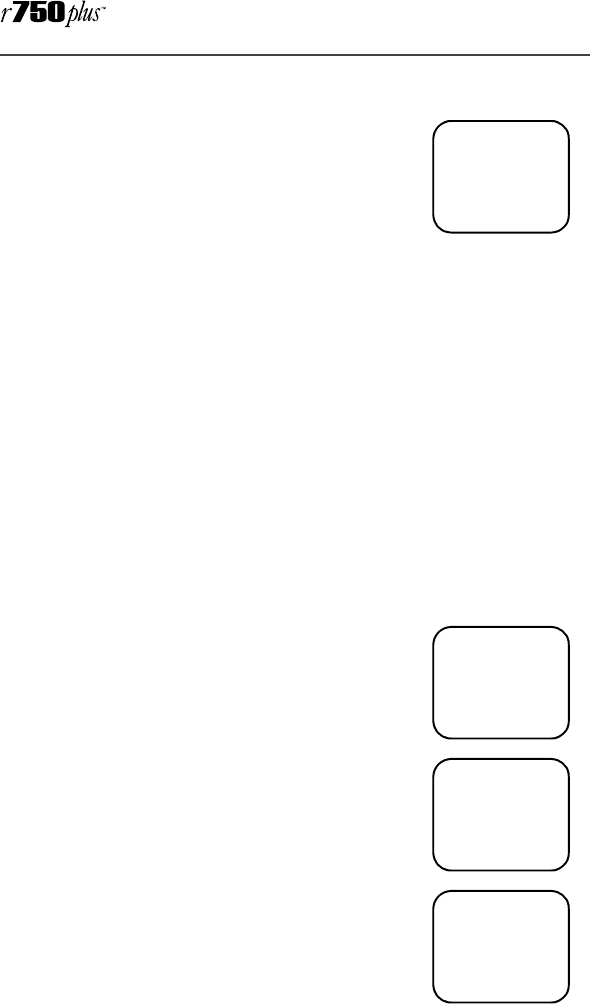
32
www.mot.com/iDEN
Clearing or Queueing a Call Alert
When you receive a Call Alert, do one of the
following:
•To clear a Call Alert, select “Clear”.
•To place the Call Alert into the queue, select
“Queue”. Pressing m also queues the Call
Alert.
If you receive multiple Call Alerts, the last received Call Alert
displays and the remaining Call Alerts are stacked at the beginning
of the queue.
Responding to a Queued Call Alert
You can respond to the Call Alerts in any order. To select a Call Alert
for response:
1. Select “Queue”.
2. Press l or r to scroll to the desired Call Alert.
3. Press the PTT button to respond to the Call Alert.
Quickstore of Private IDs
Quickstore allows you to quickly store a received or sent Private ID,
without having to enter the programming menu.
The ID is added as the last number received or sent in Private mode.
From the Private Ready screen, with the Private ID
displayed:
1. Select “Store”.
If an ID is greater than 12 characters in length,
the ID wraps to the third line.
2. Enter the name associated
with the Private ID.
3. Select “Store”. The Stored message displays.
If the list is full with the maximum 100 entries,
you will get the message, “Prvt List Full”. You
cannot add names until you remove some names
from the list.
adjb
Alert 3
JOHN SMITH
Clear Queue
adjb
Prvt Ready
56781
Alert Store
12:43p 07/22
adjb
Enter Name
-
Cancl Store
adjb
JOHN
Stored

Making Private Calls
33
4. Next, the display returns to the Private Ready
mode.
Storing Your Private ID
To store your Private ID in your r750plus phone:
1. Press *,#,2. The screen displays the message, “2=Own Pvt
ID”.
2. Select “Ok”.
3. Enter the Private ID provided by your carrier.
4. Select “Store”.
To view your Private ID at any time after you store it:
1. Press *,#,2. The screen displays the message, “2=Own Pvt
ID”. The next line displays your Private ID. This is the number
supplied by your carrier that you store in your phone.
2. Select “Exit”.
adjb
Prvt Ready
JOHN
Alert Name
12:43p 07/22

34
www.mot.com/iDEN
Making Group Calls
A Group Call* allows you to communicate instantly with members of
a selected Talkgroup–a pre-defined set of people who share a
communication need.
Talkgroups appear on your display as numbers or programmed
names, such as Talkgrp10 or Sales Team.
To make a Group Call:
1. Press m until “Group Ready” displays. Your
most recently used talkgroup displays, for
example, “Talkgrp 10”.
2. To place a call, do one of the following:
• To speak to this talkgroup, press and
hold the PTT button. Wait for the chirp,
then speak into the microphone.
• To speak to another talkgroup, press l or r until you see
the desired talkgroup name. Press and hold the PTT
button. Wait for the chirp, then speak into the
microphone.
3. To listen, release the PTT button.
Receiving a Group Call
When you receive an incoming Group call, you will hear a brief
chirp-like tone. Your r750plus phone automatically switches to
Group mode, and the Talkgroup name displays.
1. Your phone must be idle, that is, not busy in an active call or on
the browser.
2. Wait for the caller to finish speaking, then press and hold the
PTT button. Begin speaking after you hear the chirp.
3. To listen, release the PTT button.
You can receive group calls only in the Talkgroups that you have
predefined. For more information, see “Adding or Storing a Talkgroup” on
Page 34.
Adding and Storing a Talkgroup
To add and store a talkgroup name to your r750plus phone:
1. Press *,#,2,3.
2. Select “Ok”.
3. At “Add New Entry?”, select “Ok”.
*Non-Advanced Feature Units only.
adjb
Group Ready
1:Tg1
S Off Sts

Making Group Calls
35
4. At “Enter ID”, enter the desired talkgroup number and select
“Store”.
5. At “Enter Name”, enter a name for the talkgroup and select
“Store”.
Area Selection
In Group mode, you can call only those talkgroup members in a
specific location. This is useful when you know where the
individuals are located within the service area.
1. Press m until you see “Group Ready” on your display.
2. Press n, then select “Area”.
3. Press l or r to scroll through the targeted areas specified by
your local carrier.
4. Select “Ok” to select the targeted area.
Private/Group Mode Speaker
You can hear Group calls through either the earpiece or the speaker.
Press the Speaker button k on the r750plus phone to turn the
Private/Group Mode Speaker on or off.
With the Speaker on, you will hear incoming calls through the
speaker. This is useful to monitor talkgroup activity in Group mode.
With the Speaker off, you will hear incoming calls through the
earpiece.

36
www.mot.com/iDEN
Advanced Features
Some r750plus phones are provided with an advanced feature set as
described in this section. Please contact your service provider for
more information.
Multi-Simultaneous Talk Group Scan
Multi-Simultaneous Talkgroup Scan (Scan) allows users within a fleet
to monitor more than one talkgroup. A Talkgroup Mode, within the
range of 1-255, is comprised of up to four talkgroups (one Primary
Talkgroup and up to three Secondary Talkgroups). Calls can only be
initiated on the user’s Primary Talkgroup; however, a user can
respond to an active call on either a Primary or Secondary Talkgroup.
Both Primary and Secondary Talkgroups, as well as the Talkgroup
Mode, can be named (aliased). The Scan feature is set to “ON”, but
the user has the capability of disabling Scan through an option key.
The unit will store the last Scan setting, and power on with that
setting.
Entering Group Mode
1. Press the f key to power on your unit. Press m to enter Group
Mode.
Two different Talkgroup Modes are displayed below. The Primary
Talkgroup is indicated to the right of the Talkgroup Mode. The
display on the left shows a non-aliased Primary Talkgroup, and the
display on the right shows an aliased Primary Talkgroup.
Group Ready
102:Tg 15
S Off Sts
Group Ready
3:Electricia
S Off Sts
Primary Talkgroup
Not Aliased
Primary Talkgroup
Aliased
ab
Group Ready
3:Electricia
S Off Sts
ab
Group Ready
102:Tg 15
S Off Sts
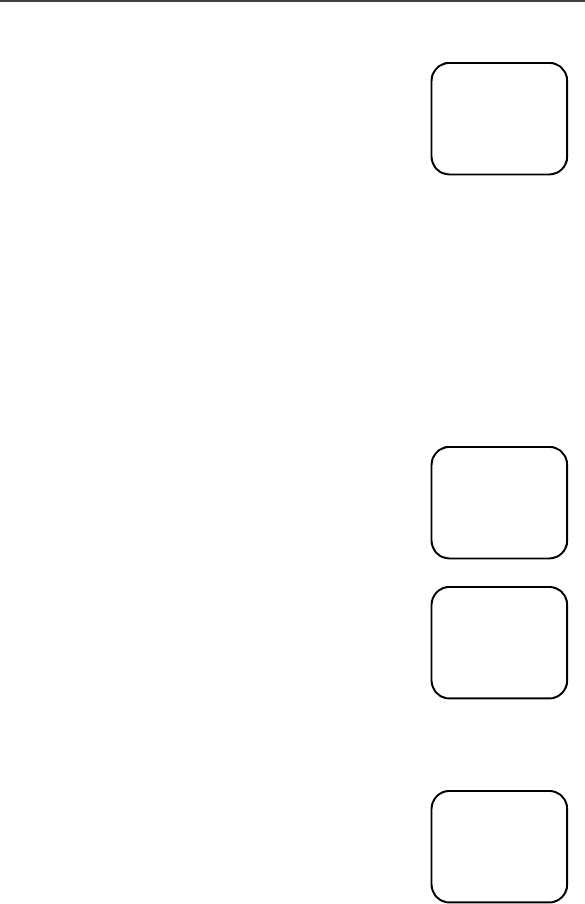
Advanced Features
37
Initiating a Group Call
1. Press and hold the PTT button to initiate a
group call on your Primary Talkgroup.
The example to the right illustrates the display if
Fred pressed the PTT button to initiate a call on
the Electricians talkgroup. This is Fred’s Primary
Talkgroup for Mode 3.
All subscriber units that have affiliated with
your Primary Talkgroup as either a Primary or Secondary Talkgroup
in any Talkgroup Mode will receive your group call if they are not
already engaged in an active call.
The following screens will be displayed on the receiver subscriber
units indicating they have joined the call. The second line of the
display will indicate the Mode number followed by Primary or
Secondary Talkgroup, which may be aliased. The third line of the
display indicates the PTT-ID of the unit initiating the group call,
which can also be aliased.
Example: Jason joins the Electricians talkgroup.
He has also selected Electricians as his Primary
Talkgroup for Talkgroup 3, but he has no alias
for his talkgroup, so the Talkgroup number (TG
ID) is displayed. Fred’s PTT-ID is displayed on
the third line.
Example: Julie joins the call and the unit
updates the alias to indicate active Secondary
Talkgroup (Mode 1, Secondary Talkgroup 3).
Fred’s PTT-ID is displayed on the third line.
Responding to a Secondary Talkgroup
1. To respond to a call on a Secondary Talkgroup, press the PTT
button.
Example: Julie responds to Fred by pressing the
PTT button.
ab
Group Ready
3:Electricia
S Off Sts
Fred’s Display
ab
Group Ready
3:Tg 3
ID:Fred
S Off Sts
Jason’s Display
ab
Group Ready
1:Electricia
ID:Fred
S Off Sts
Julie’s Display
ab
Group Ready
1:Electricia
S Off Sts
Julie’s Display
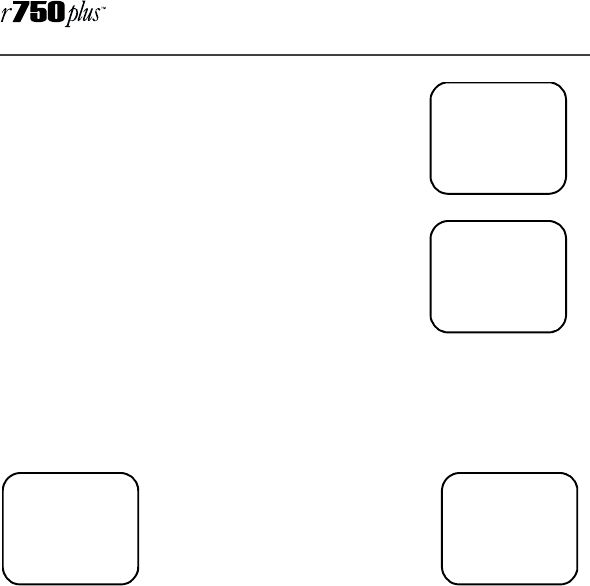
38
www.mot.com/iDEN
Fred has released his PTT button, then begins to
receive Julie’s response.
Jason receives Julies’s response.
After the Secondary Talkgroup call is completed,
all receiving subscriber units’ displays will revert
to their Primary Talkgroup of the selected
Talkgroup Mode.
Turning Scan On and Off
The capability to turn scan on and off is available as an option key.
1. Press the “Scan” option key.
Press the “S Off” soft option key to disable scan.
When Scan is disabled, you will not have access to your Secondary
Talkgroups
Aliasing Talkgroup Mode
The r750plus phone allows you to set up Alias Talkgroup Modes and
primary and secondary talkgroups.
1. Press *, #, 2, 5.
2. Select “Ok”.
3. At “Add New Entry” select “Ok”.
NOTE: Press l or r to Edit or Erase a Talkgroup Mode Alias.
4. At “Enter Name” enter the desired talkgroup mode alias and
select “Store”.
NOTE: The Aliased Modes are displayed only while scrolling through
the Talkgroup Mode or during Direct Entry. In an idle or trans-
mission state, the Mode ID number is displayed. This ensures
that the Mode ID number and Primary Talkgroup are displayed
simultaneously on screen.
ab
Group Ready
3:Electricia
ID:Julie
S Off Sts
Fred’s Display
ab
Group Ready
3:Tg 3
ID:Julie
S Off Sts
Jason’s Display
Group Ready
102:Tg 15
S Off Sts
Group Ready
3:Electricia
S Off Sts
Scan Enabled Scan Disabled
ab
Group Ready
18-Engineers
Scan Sts
ab
Group Ready
18:Engineers
S Off Sts
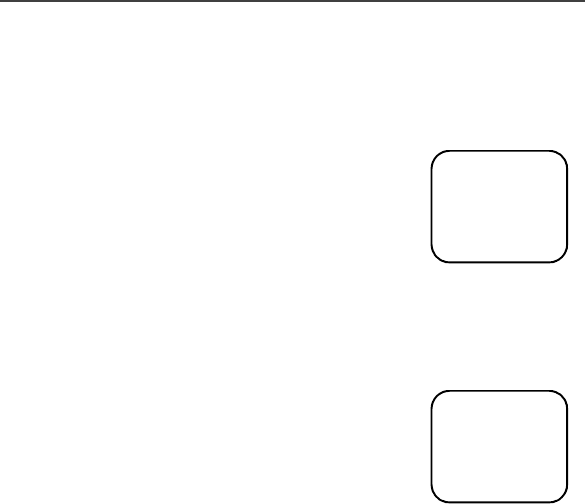
Advanced Features
39
Talkgroup Mode Selection by Direct Entry
You may select a different Talkgroup Mode at any time.
1. Press the 1 key. To erase a digit, press l. To clear all digits,
press and hold l. To return to your previously selected Talk-
group Mode, press the “Cancl” option key.
2. Press the 8 key.
3. Press the PTT button or the “Ok” option
key. “Mode 18” will flash until affiliation is
complete. If you selected the Talkgroup
Mode by pressing the PTT button, you will
initiate a call on your Primary Talkgroup.
Talkgroup Mode Selection by Memory Scroll
The Memory Scroll feature allows you to use the l or r keys to
scroll through memory for Talkgroup Modes.
1. Press r. Press an hold this key to Auto
Scroll through your lists more quickly.
2. Press the PTT button or the “Ok” option
key.
NOTE:To transmit, press the PTT button; to listen
only, press “Ok”.
Emergency Group Call
NOTE: If your r750plus phone has an orange button on top of the hous-
ing, the Emergency Call feature is present.
Emergency Group Call is a carrier-dependent feature. Please contact
your carrier for service availability.
Placing an Emergency Group Call
An Emergency Group Call allows a user to have priority access to his
talkgroup members and provide them visual and audible indications
of an emergency condition. The Emergency call can be placed from
any mode (private, group, phone, Net).
1. Press and hold the Emergency Button. The portable will emit an
emergency start tone to indicate that you have successfully
requested an emergency call.
ab
Group Ready
18_
Cancl Ok
ab
Group Ready
Mode 18
Cancl Ok
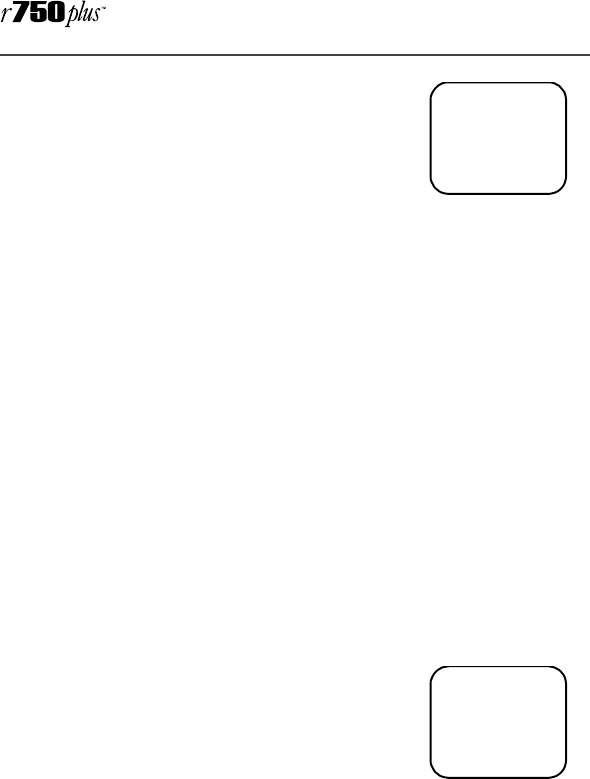
40
www.mot.com/iDEN
2. Press the PTT button to talk. The currently
selected Talkgroup Mode will be selected
unless your organization pre-programmed
an emergency Talkgroup Mode. If this is the
case, the pre-programming emergency Talk-
group Mode will flash in the display. The
Talkgroup Mode appears in the second line of the display as
shown.
3. To end an emergency call, press and hold the Emergency Button
for 3 seconds. The portable will return to the last selected talk-
group mode. The initiator cannot exit the emergency call with-
out first cancelling the emergency call.
Cancelling an Emergency Group Call
Press the Emergency Button until the unit generates an Emergency
Call Cancel tone. This tone indicates the cancellation has occurred.
The display will return to the non-emergency state.
An emergency call will be cancelled if no talkgroup activity occurs
for 30 seconds. The dispatcher, or any other person provisioned to
cancel an emergency call, can also cancel the emergency call.
Receiving an Emergency Group Call
When an emergency call is initiated, other members of the talkgroup
will be notified of an emergency condition.
The receiving unit will hear an Emergency
Receive Tone, and the receiver’s display will
change to indicate the condition.
The first line of the display will indicate the ID
or alias of the person initiating the emergency
call. The second line will show you the
Talkgroup Mode and Active Talkgroup name or number. The third
line shows you the ID or alias of the person who is currently
speaking. The third line will remain blank when the receiving unit
initiates a transmission.
Receiver Operations During an Emergency Call
Other members of the Emergency Group Call can leave the
emergency call and change modes (phone, group, private, Net) while
involved in the call.
ab
EMERGENCY
1: SE Plant
ID:John
ab
EMER:58
1:SE Plant
ID:Cheryl
S Off Sts
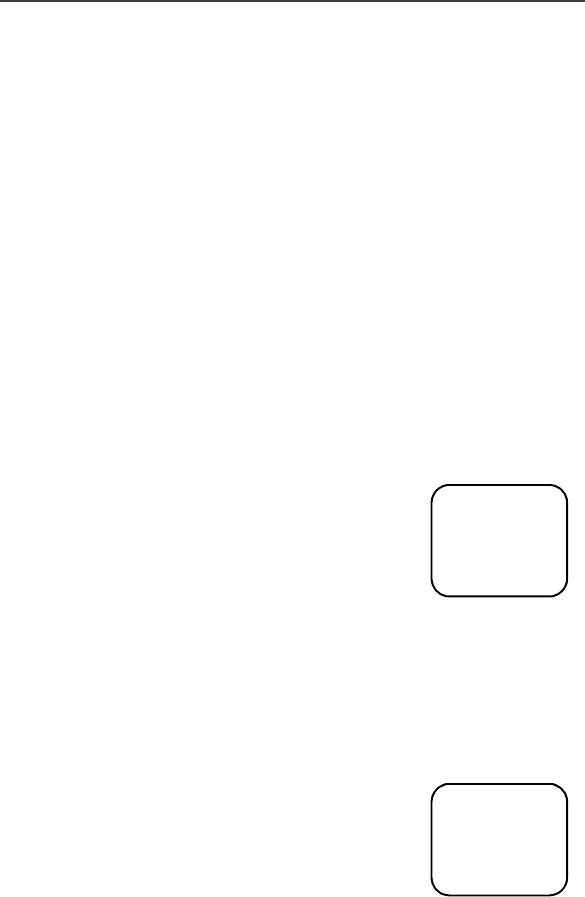
Advanced Features
41
While listening to the emergency call, the receiving unit will not
receive phone calls, Call Alerts, Message Mails, Status Messages,
Private Calls or other group calls for the duration of the emergency
call.
Status Message
Status Message lets you send a pre-defined message to the dispatcher
or to another user’s ID. Up to ten pre-defined alphanumeric Status
Messages are available such as “At Lunch” or “En Route”.
You can also send any numeric Status Message from 1-255. A Status
Message can be sent by selecting both the Status Message and target
ID (alias) of the person who is to receive the Status Message. You can
reduce talk time by sending Status Messages. You can also leave a
Status Message for receivers while they are away from their portables.
Entering the Status Message Function
1. Press the Status Option Key to get to the Status Message func-
tion. You must be in Group or Private Mode to access this func-
tion.
The second line of the display shows the Status Mes-
sage (alpha or numeric) of the last successfully
sent status.
2. Press Option “Exit” to return to either the
group or Private mode. Press Option “Targt”
to go to the Target ID selection screen.
Selecting a Status Message with Direct Entry
Direct Entry allows you to use the keypad to select the message you
want to send. Enter any number from 1-255 to select a Status
Message. The number can correspond to one of ten pre-programmed
alphanumeric status messages or any other numeric Status Message
within the range of 1-255.
1. Press 2.
2. Press “Ok”. Pressing the PTT button at this
time will send the message to the last unit
to which you sent a successful message.
3. Press “Targt” to select a target for this mes-
sage.
ab
Sts Message
En Route
Exit Targt
ab
Sts Message
2
= At Lunch
Cancl Ok
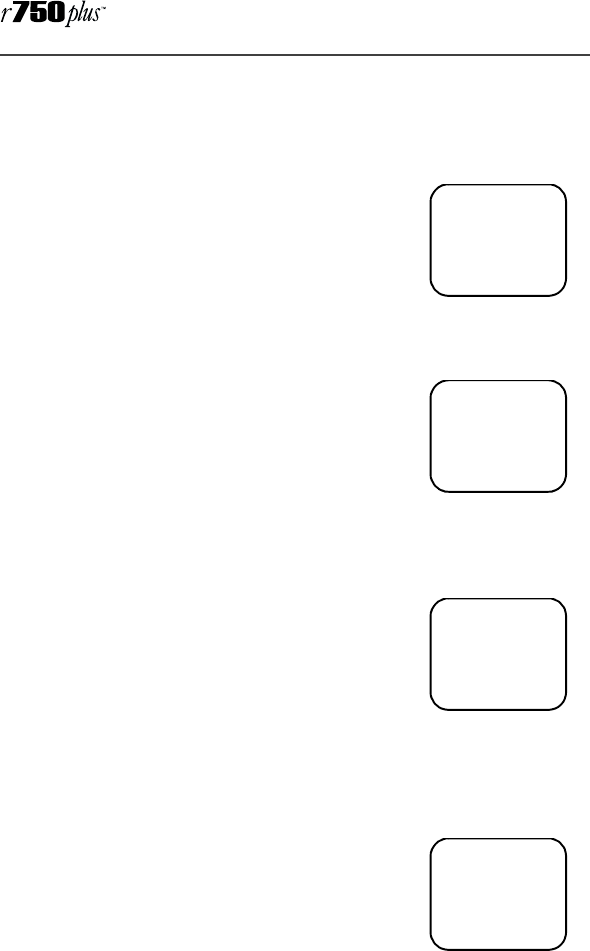
42
www.mot.com/iDEN
Selecting a Status Message Using Memory Scroll
You can select Status Messages by using the l or r keys to scroll
through the ten named (aliased) Status Messages which you have
programmed.
1. Press r until you find the message you
want. In this case we scrolled to the Status
Message “At Lunch”.
2. Press “Ok”.
3. Press “Targt” to select a target for this mes-
sage.
Selecting a Target by Direct Entry
1. Enter the numeric ID of the person to
whom you are sending the message.
2. Press “Ok”.
3. Press the PTT button to send the message to
the selected ID.
Selecting a Target by Memory Scroll
You can select a target by scrolling though the portable IDs or aliases
by using the l or r keys.
1. Press the r key until you find the person to
whom you want to send the message.
2. Press “Ok”.
3. Press the PTT button. The display shows the
message that has been sent.
Selecting a Target by Alpha Search
You can select a portable ID by selecting the first letter of the name
(alias). If no name is stored under a letter, the unit will automatically
search forward, alphabetically, until the next name is found.
1. Press the “Name” key.
2. Press a numeric key. i.e.: Press 7 three
times to view the names (aliases) that begin
with the letter R.
3. Use either the l or r keys to scroll to the
name (alias) who is to receive the Status
Message.
4. Press the PTT button. The display shows the message that has
been sent.
ab
Sts Message
At Lunch
Cancl Ok
ab
Sts Target
5
= Rochelle
Cancl Ok
ab
Sts Target
Julie
Cancl Ok
ab
Alpha:Sts
R=Randy
Cancl Ok
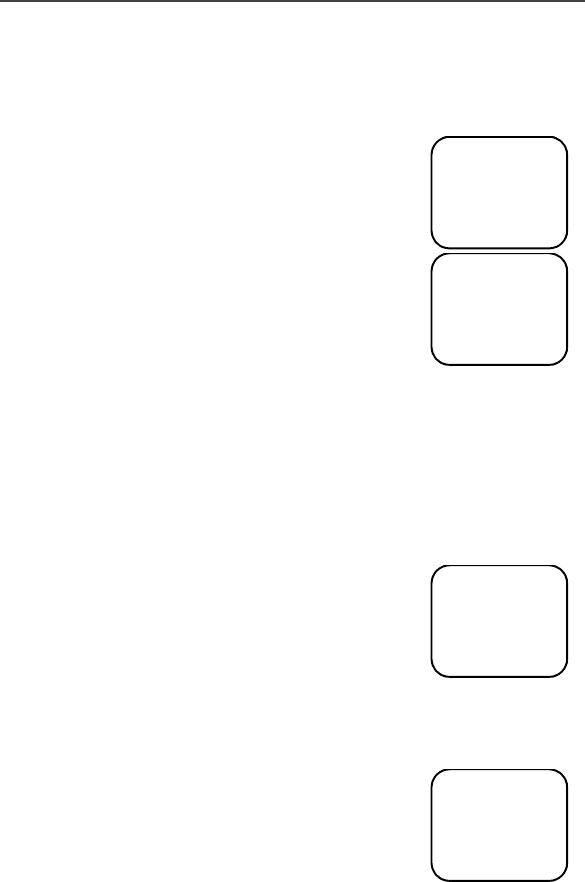
Advanced Features
43
Sending a Status Message
After selecting both a Status Message and a desired target ID, press
the PTT button to send the message. Two high pitched tones will be
heard during transmission.
If successful, two high pitched tones will be
heard to indicate the message was successfully
delivered to the target portable.
If unsuccessful, an alert tone will be heard to
indicate that the targeted unit is busy, out-of-
range, or turned-off.
In either case, the portable will return to the
status screen after 3 seconds.
Exiting the Status Message Function
Press the m key to exit the Status Message screen. Pressing the “Exit”
option key from the Status Message screen will also allow you to exit
the status message function.
Receiving a Status Message
The portable will receive a message along with
alert tones. To silence the recurring alert tones
only, press any key except m or the “Clear”
option key.
All calls remain blocked until this message is
cleared.
ID List Programming
Feature menu #25 allows you to program ten
status messages, each up to 12 characters long.
Isolated Site Operation
Isolated Site Operation (ISO) allows group call
communications to continue within a single cell
site when connectivity to the network is lost by allowing the cell to
operate in a local, one cell only mode. ISO is limited to dispatch
talkgroup calls only. In all modes the display will update to include
“-Isoft” on the first line. Talkgroup communications will be limited
ab
Sts-Sent
Successful
ab
User Not
Available
ab
Sts-Kelly
At Lunch
Clear
ab
26=Sts Mesg
List Program
Exit Ok
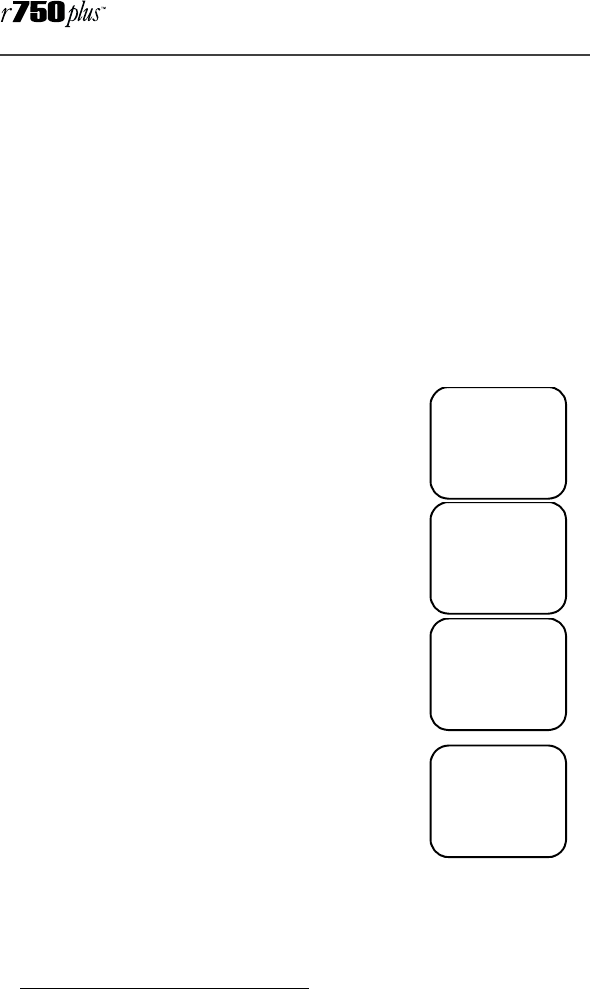
44
www.mot.com/iDEN
to only those units that are connected to the ISO cell, and only on
the talkgroup or Talkgroup Mode (depending on Scan setting) that
the subscriber unit last used before the cell entered the ISO state.
Entering ISO
The portable will enter the ISO state when its cell becomes isolated
from the network, assuming the portable has no available neighbor
cells. It will display one of the following screens*: (The LED indicator
is off in ISO unless the unit is transmitting. While transmitting, the
LED will be green.)
NOTE:If the portable is powered on in an ISO cell, it will enter the ISO
state if there are no available neighbor cells.
Phone Mode
Group Call Mode
Private Call Mode
Net Mode
*Depending on your carrier, the top line (Phone-Isoft, Group-
Isoft, Prvt-Isoft, or Net-Isoft) may vary.
ab
Phone-Isoft
Name Mail
ab
Group-Isoft
3:Electricia
S Off Sts
ab
Prvt-Isoft
Julie
Alert Name
ab
Net-Isoft
Julie
Alert Name
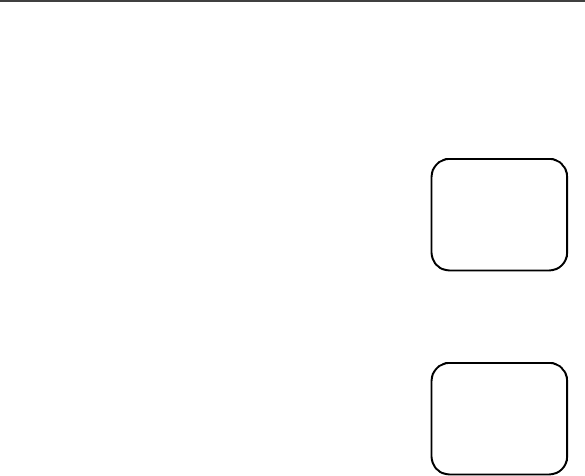
Advanced Features
45
Initiating a Group Call
If the portable has Scan enabled when the site enters ISO, the
portable will be able to initiate a call on its Primary Talkgroup and
can respond to calls started on either the Primary or any Secondary
Talkgroup.
The portable will not be able to select a new
Talkgroup Mode while in ISO condition.
If the portable has Scan disabled when the site
enters ISO, the portable will be able to initiate
and respond to calls on the Primary Talkgroup
only.
Exiting ISO
When the cell returns to normal operation, the
unit will revert back to standard operation. The
green LED indicator will resume blinking.
If the unit goes out of range of the ISO cell and
has no available neighbor cells, the unit will go
out of service.
Other Operations
Since the ISO operation is limited to group calls only, any attempts
to communicate in other modes (phone, private, alert, status) will
result in a “Service Not Available” message. However, all other
functions (memory scroll, direct entry, feature menu programming,
etc.) are still operable.
ab
Group-Isoft
3:Electricia
S Off Sts
ab
Group Ready
3:Electricia
S Off Sts
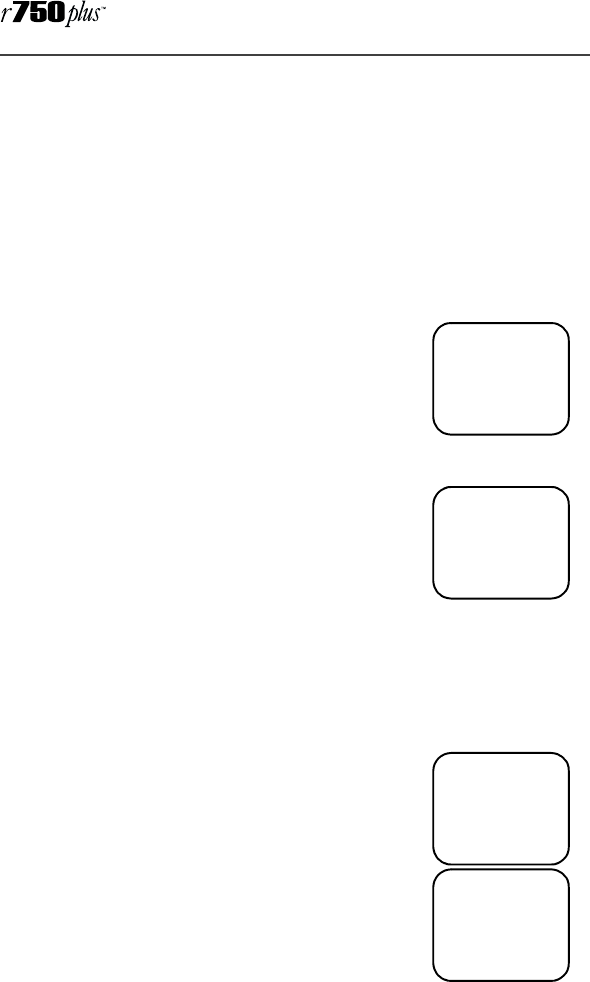
46
www.mot.com/iDEN
Using Mail Services
NOTE: Some features may be network dependent or subscription only,
and may not be available in all areas. Contact your service pro-
vider for more information.
Your r750plus phone provides the following mail services:
• Net Mail™
• Voice Mail
• Message Mail
When you receive a new message, the c icon
appears and flashes.
•To read your new mail immediately, select
“Now”.
•To read your new mail later, select “Later”.
An asterisk * next to a mail service indicates new
mail.
To use message services, select “Mail” from any
Ready screen. The inbox screen opens with your
message services listed.
To select a message service, scroll to highlight the
service or press the corresponding number. For
example, to access your Message Mail, press 2.
Net Mail
Net Mail alerts you when you receive alerts from the Browser, for
example, notification of an e-mail or fax.
From any mode:
1. Select “Mail”.
2. Select “Net Mail”, then select “Ok”.
The Alerts inbox opens and displays the type of
Net Mail alerts.
The Inbox screen opens.
3. Scroll to the type of alert that you wish to
view, then select “Ok”.
a d cb
New Mail
Read?
Later Now
a d cb
1>Voice Mail
*2>Mesg Mail
Exit Ok
3>Net Mail
adjb
1>Voice Mail
2>Mesg Mail
Exit Ok
3>Net Mail
adjb
Inbox
1 Email
Ok Del
2 Fax
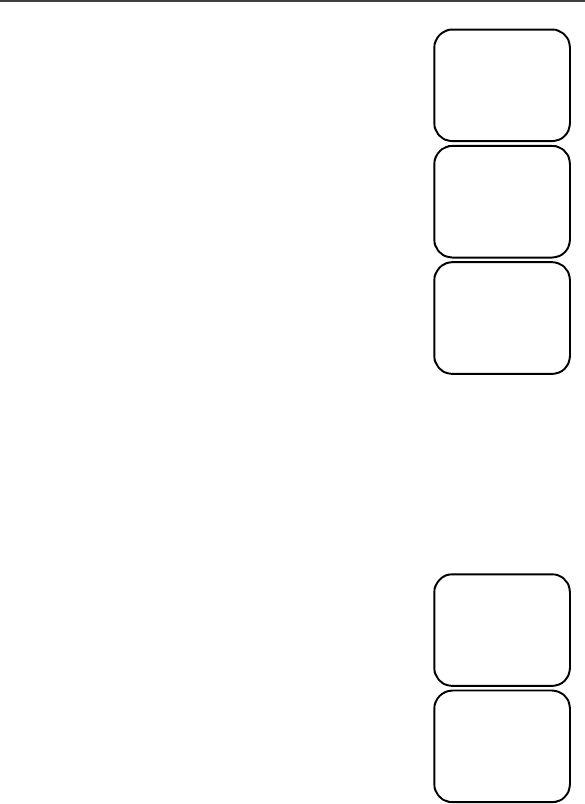
Using Mail Services
47
4. To read the message, select “View”.
5. After you read the message, do one of the fol-
lowing:
• Select “Menu” to view a list of actions
that you can take for this message, such
as reply, delete, save, and so forth.
• Or, select “Next” to read the next
message.
Voice Mail
When your r750plus phone receives a Voice Mail message:
•The g icon appears on your display.
•The Voice Mail alert tone sounds (if Mail Notification is turned
on).
•The message, “New Voice Mail Waiting” appears on your display.
•An exclamation point (!) on the display indicates that you have
at least one urgent message.
From any mode:
1. Select “Mail”.
2. Select “Voice Mail”.
The Voice Mail inbox opens and displays the
number of your new and total Voice Mail
messages.
To retrieve your voice mail immediately:
1. Select “Dial”. This action automatically places
a call to your voice mailbox. The most recent message is
retrieved first.
2. To close your voice mailbox, select “Exit”.
Alert Receipt During Phone Call
Through your programming menu (*,#, 15) you can delay Voice Mail
and Message Mail Alerts so that you are not interrupted by the alert
tone while on a call. You can choose the following:
adjb
Inbox:1unread
1*Lunch
View Menu
2 MEETING
adjb
LUNCH
----
Next Menu
With client at
12:00
adjb
1>Reply
2>Delete
Ok More
3>Save
4>GoTo Message
agjb
1>Voice Mail
2>Mesg Mail
Exit Ok
3>Net Mail
agjb
Voice Mail
1 New
Exit Dial
1 Total
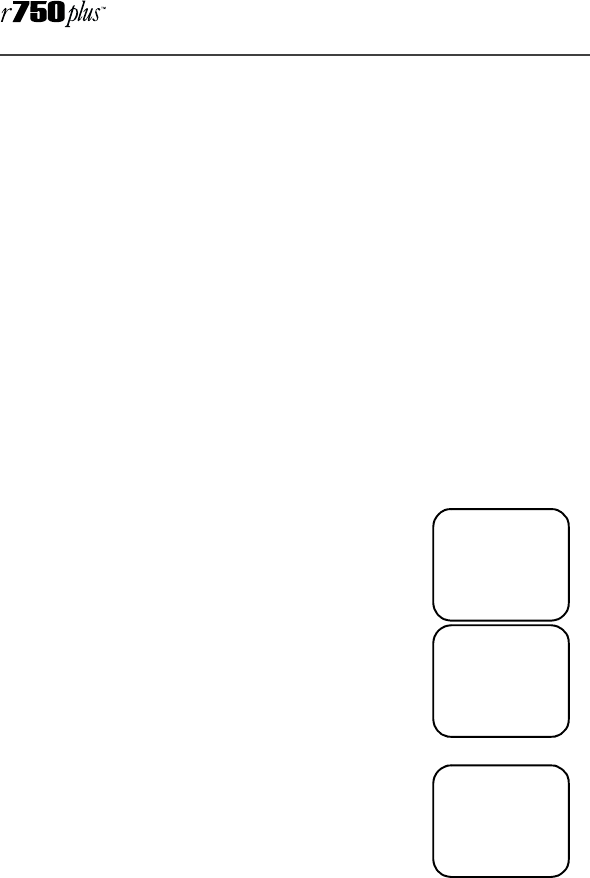
48
www.mot.com/iDEN
•Receive All Alerts
•Delay All Alerts
•Receive Message Mail Alerts only
See “Setting Programming Menus” on page 51 for more information.
Message Mail
Message Mail can be either a numeric page or a text message of up to
140 characters. Your phone can receive and store 16 mail messages at
any time.
1. To postpone reading your mail and to clear the display, select
“Later”. The icon stops flashing but remains on your display to
remind you that you have unread messages.
To read your mail now:
2. Select “Now”. The screen will briefly display the number of new
and saved messages in your mailbox.
3. A list of all your messages will display. Highlight the message
that you wish to read and select “Read”.
To read you mail later:
4. From any mode, select “Mail”. The Mailbox
opens.
5. Select “Mesg Mail”.
Your message mailbox opens and briefly dis-
plays the number of new and saved messages
currently in your mailbox.
Next, a list of all messages will display. Select the
message that you wish to read and select “Read”.
Saving and Erasing Mail
Your message shows the time and date that the sender entered it in
the network
adjb
1>Voice Mail
2>Mesg Mail
Exit Ok
3>Net Mail
adjb
Message Mail
2 New
0 Saved
adjb
*>FR: Smith
*2>FR: Jones
Exit Read

Using Mail Services
49
After you read a text or numeric message, you can
either Save or Erase the message. Press o under
the desired option.
Auto Call Back
You can respond to numeric pages and text messages containing a
call-back number. To automatically dial a number contained within
a Message Mail, press e.
Mail Memory Full
If all 16 message registers are full, your phone displays the message
“Mail Waiting, Memory Full”. You cannot receive new Message Mail
until you empty register space by erasing saved or unread messages.
adjb
1>Call
5551212
Erase Save
11:15a 04/02

50
www.mot.com/iDEN
Using Your Phone as a Modem
NOTE: Some features may be network dependent or subscription only,
and may not be available in all areas. Contact your service pro-
vider for more information.
You can use your r750plus phone as a modem for data transfer from
your laptop, handheld device, or desktop computer. This is
particularly useful when there is no wired phone line (wall jack)
available.
You simply attach a data cable (available separately) to your phone
and your computer. From that point, your phone is your modem.
This allows you to send or receive time-critical information such as e-
mail, a field service report, or files. In addition, you can also send or
receive faxes.
This type of wireless connection uses one of two types of data
connection: circuit-switched data and packet data.
• Circuit-switched data is typically used for sending and
receiving faxes and for transferring large files.
• Packet data is used for small file transfers such as e-mail.
To use these services, you must install the iDEN Wireless Data
Services software (available separately). For more information on
setting up your computer and your r750plus phone for Packet and
Circuit Data calls, see the Wireless Data Services User’s Guide and
contact your carrier.
TTY Users
You can use your phone and computer in TTY mode. Your
computer screen and keyboard replace the standard TTY
device. For more information, please see the Wireless Data
Services User’s Guide.
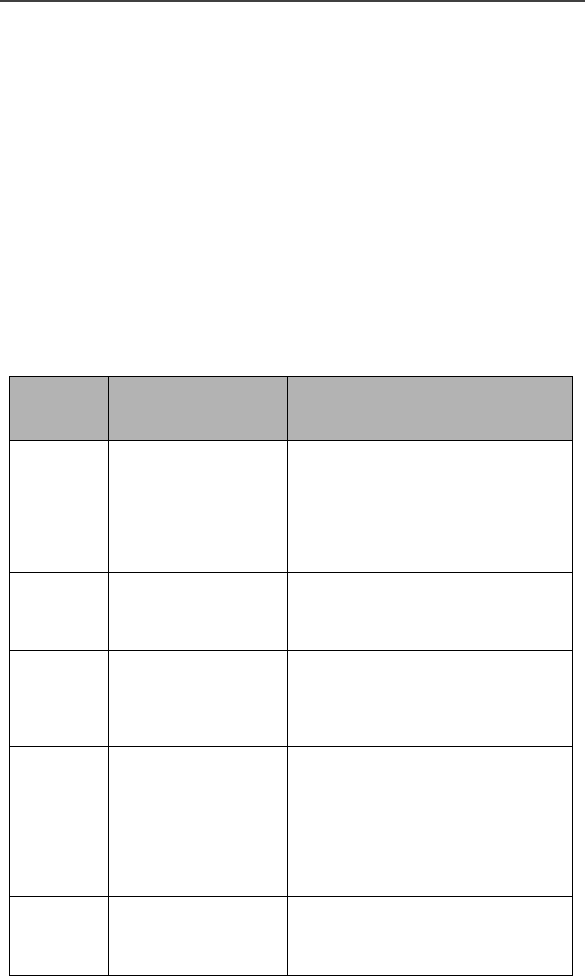
Setting Programming Menus
51
Setting Programming Menus
You can customize the settings on your phone using the
Programming Menu.
1. Press n until you see “Prgm” on the display.
2. Select “Prgm”.
3. Select “Ok”.
4. Press l or r to scroll to the desired Programming Menu Option
or enter the number of the Option.
NOTE: You can press *, #, and then the corresponding keypad
number to get to the desired programming menu.
Table 6: Programming Menu Options
Keypad
Number Menu Option Function
1 Own Ph # Automatically store the
telephone number of your
phone after you receive the
first incoming call (Line1). You
can also enter the number and
view it.
2 Own Pvt ID Display the private number of
your phone. You must first
store this number.
3 Mail Display:Off Turn on and off the New Mail
message that is displayed with
incoming Voice, Message, or
Net Mail.
4 Manual Lock:Off Lock your phone to prevent
unauthorized use. You must
enter a pass code to unlock it.
Even with the manual lock on,
you can reach emergency help
by pressing and holding the
9 key.
5 Auto Lock:Off Automatically lock your phone
each time it is powered off to
prevent unauthorized use.
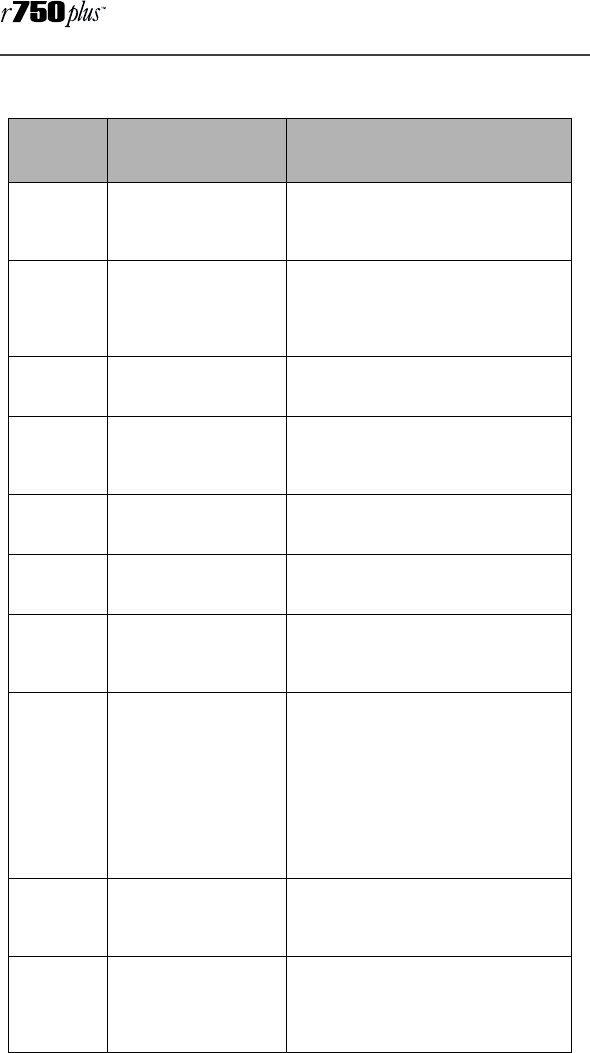
52
www.mot.com/iDEN
6 Auto Answer:Off Turn on or off automatic
answering of incoming phone
calls after 1-4 rings.
9 Vibrate Alert:Off Receive a non-audible alert for
incoming phone and circuit
data calls and messages. See
“VibraCall® Alert” on page 15.
10 Last Call Timer Display the duration of the
most recent phone call.
11 Display Timer:Off Turn on or off automatic
display of the Last Call Timer at
the end of each phone call.
12 Reset Timer Display cumulative airtime of
all phone calls since last reset.
13 Total Timer Display cumulative airtime of
all phone calls.
14 1 Minute
Beep:Off
Automatically signal each
minute of elapsed phone
airtime with an audible beep.
15 Alert Receipt Delay Voice Mail and Message
Mail Alerts so that users are not
interrupted by the alert tone
while on a call. Users can
choose to: Delay All Alerts;
Receive All Alerts; Receive
Message Mail Alerts only. See
“Alert Receipt During Phone
Call” on page 47.
16 Backlight Timer Specify the duration of the
Backlight Timer (0, 10, 20, or
30 seconds).
20 Phone/Prvt List Add phone and private
numbers in one procedure.
See “Combined Phone Number
and Private ID List” on page 24.
Table 6: Programming Menu Options (Continued)
Keypad
Number Menu Option Function
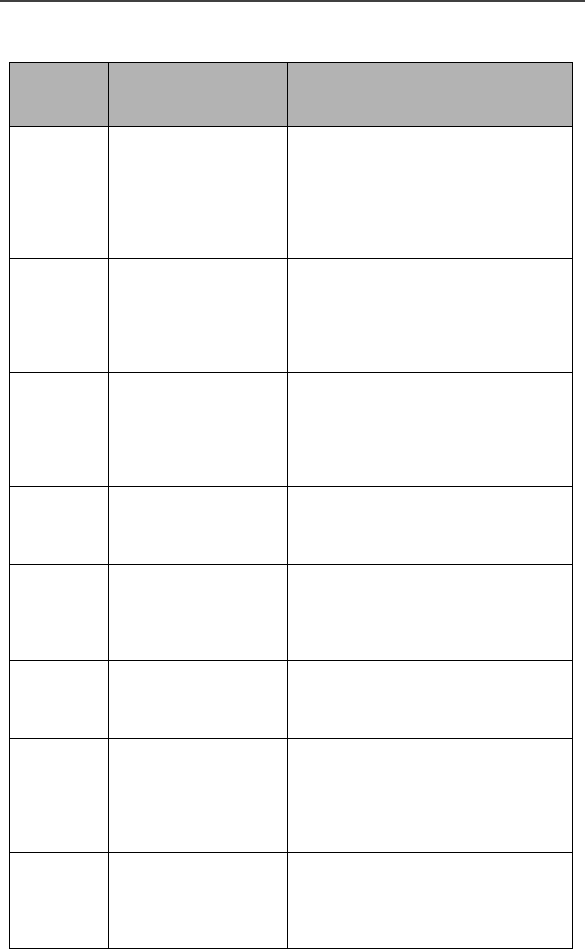
Setting Programming Menus
53
21 Phone List Edit Edit and erase up to 100
frequently called phone
numbers and associated
names. See “Editing and
Erasing Phone List Entries” on
page 26.
22 Prvt ID List Edit Edit and erase up to 100
Private numbers and
associated names. See “Editing
and Erasing Private ID List
Entries” on page 27.
23 Talkgrp List
Program
Add/Edit/Erase numbers and
associated names for up to 10
pre-programmed talkgroups.
See “Adding and Storing a
Talkgroup” on page 34
24 Area List Program Add/Edit/Erase numbers and
associated names for up to 50
targeted areas.
25 Talkgroup Mode
List Program
Add/Edit/Erase numbers and
associated names for up to 10
pre-programmed talkgroup
modes.
26 Status Message
List
Programming
Add/Edit/Erase numbers and
associated names for up to 10
alphanumeric Status Messages.
30 Ringer Volume Set the ringer volume using
the volume control keys, or
lower the volume to silence the
ringer. See “Setting the Ringer
Vo l u m e ” on page 17.
31 Set Ring Style Select a distinct ring style for
incoming phone calls. See
“Selecting a Ring Style” on page
17.
Table 6: Programming Menu Options (Continued)
Keypad
Number Menu Option Function
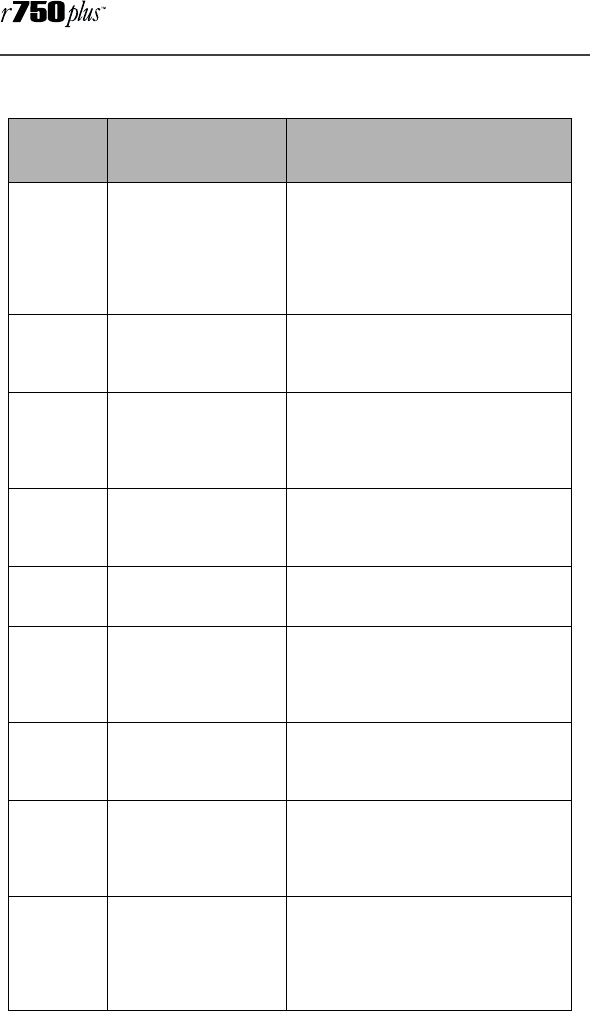
54
www.mot.com/iDEN
32 Mail Volume Set the volume of incoming
Message Mail, Voice Mail, and
Net alert tones using the
volume control keys, or lower
the volume to silence the mail
alert tones.
33 Earpiece Volume Set the default earpiece
volume using the volume
control keys.
34 Keypad Volume Set the volume of the keypad
tones using the volume control
keys, or to silence the keypad
tones.
35 Speaker Volume Temporarily adjust the Group/
Private Speaker volume for
noisy environments.
36 Spkr Vol Set Tone Turn the speaker volume set
tones on or off.
38 Silent Group Silence all incoming Group call
alerts and voice activity. When
set, your screen displays the
message, Group-Silent.
40 Change Passcode Change your secret four-digit
pass code from the initial
setting 0000.
60 Set Baud Rate Set the modem baud rate
between the phone and the
PC. See the Wireless Data
Services User’s Guide.
61 Data Ring
Volume
Set the default data ringer
volume using the volume
control buttons. See the
Wireless Data Services User’s
Guide.
Table 6: Programming Menu Options (Continued)
Keypad
Number Menu Option Function
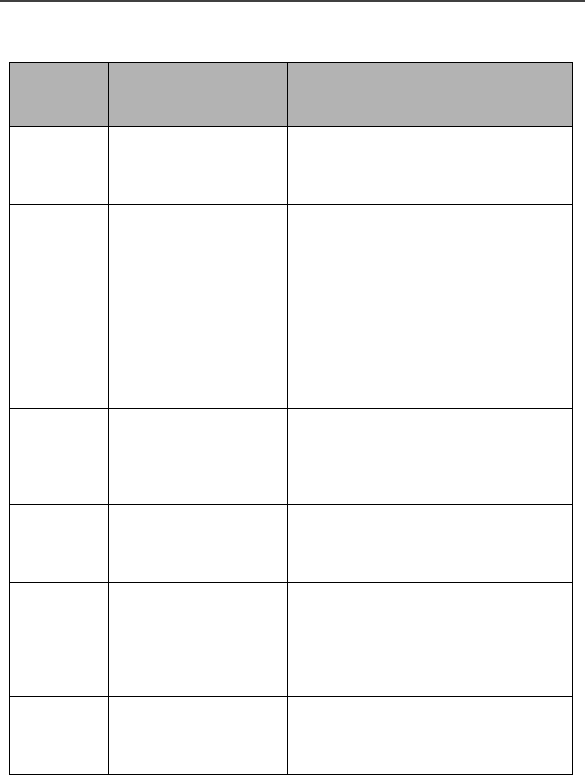
Setting Programming Menus
55
NOTE: Important! Do not perform the following shaded menu options
unless you are instructed to do so by your carrier. You could
damage your phone.
62 Pgm Data # View your circuit data (fax)
number. See the Wireless Data
Services User’s Guide.
63 IP Address Use the scroll keys to view the
Internet Protocol (IP) Address-
1 for your browser, as
programmed in your phone.
If your phone is cabled to a
computer, view IP Address-2,
the stored IP address of your
computer.
See the Wireless Data Services
User’s Guide.
64 Reset KBytes Tx/
Rx
View the number of Kilobytes
sent and received for packet
data. See the Wireless Data
Services User’s Guide.
65 Lines per Screen
(Browser and Mail
menu)
View the display in 4 lines, 12
characters or 6 lines, 16
characters.
70 Language Select one of four languages
for your display text. The
default is English. See
“Changing the Display
Language” on page 11.
71 Time/Date Select the format for the time
and date display. See “Setting
the Time and Date” on page 9.
Table 6: Programming Menu Options (Continued)
Keypad
Number Menu Option Function
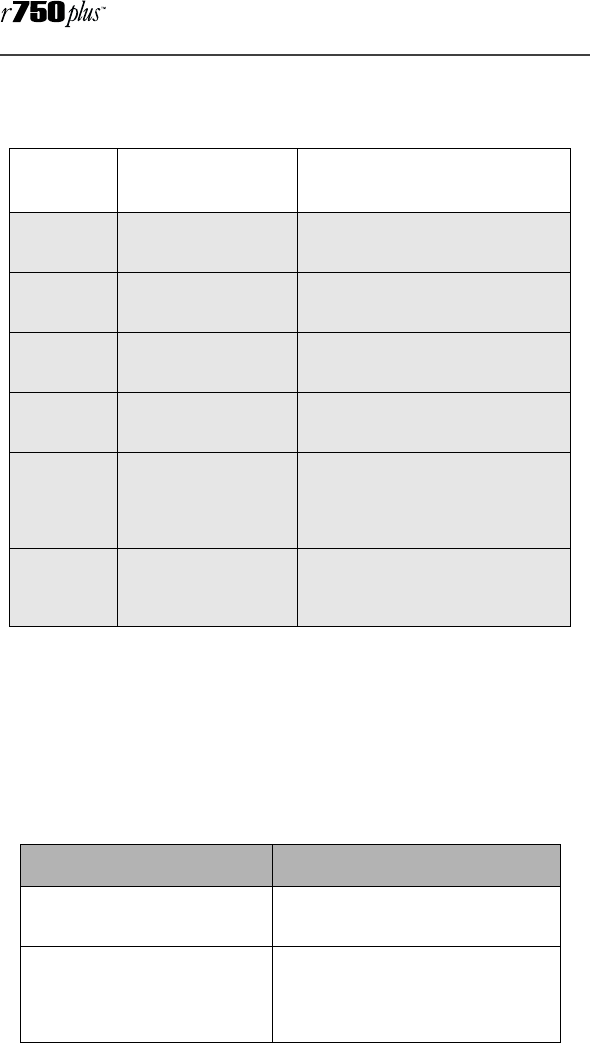
56
www.mot.com/iDEN
About Error Codes
You may receive operational status messages under certain
conditions. Before contacting your carrier, note the message,
numeric code, and the conditions under which it appeared. Table 8
lists and describes the operational status messages.
Table 7: Other Programming Menu Options
Option
Number
Menu Option Function
41 Feature Reset Returns all feature settings to
their original defaults.
42 Master Clear Performs Feature Reset and
erases all stored lists.
43 Master Reset Resets the phone’s
identification number.
44 Change Service
Key
Changes or resets the fraud
prevention service key.
50 NAM Selects alternate Numeric
Assignment Module (NAM).
See local carrier for
information.
51 Network ID Edits the pre-programmed
Network number list and
selects roaming options.
Table 8: Error Codes
Status Messages Message Description
Number Not in Service The number that you entered is
not valid.
User Not Available The party that you called is
either busy, out-of-range, or
turned off. Please try again
later.
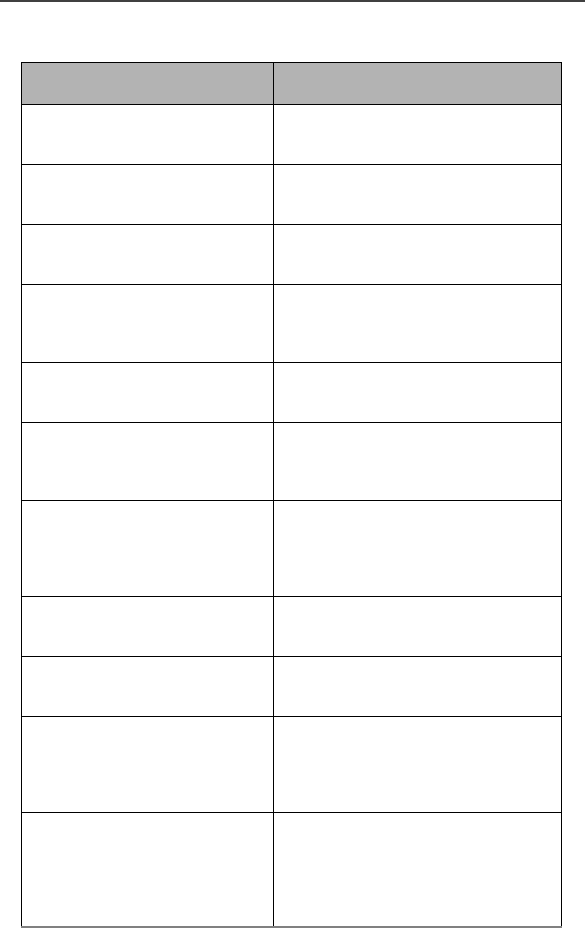
Setting Programming Menus
57
User Not Authorized The party that you called has
not purchased this service.
Please Try Later This service is temporarily not
available. Please try again later.
User Busy in Private The party that you called is
busy in a Private call.
Service Restricted This service was restricted by
your carrier or it was not
purchased.
Service Not Available This feature is not available on
the current network.
System Busy Try Later The system is experiencing
heavy traffic. Please try again
later.
Service Conflict This service cannot be enabled
because an incompatible
service has already been turned
on.
Please Try Again An error occurred. Note the
error code and try again.
User Busy in Data The party that you called is
busy in a data call.
Self Check Error A fault was detected with your
phone. If this error recurs, note
the error code and contact
your carrier.
Self Check Fail An operational fault was
detected with your phone.
Note the numeric code, turn
your phone off, and contact
your carrier immediately.
Table 8: Error Codes (Continued)
Status Messages Message Description
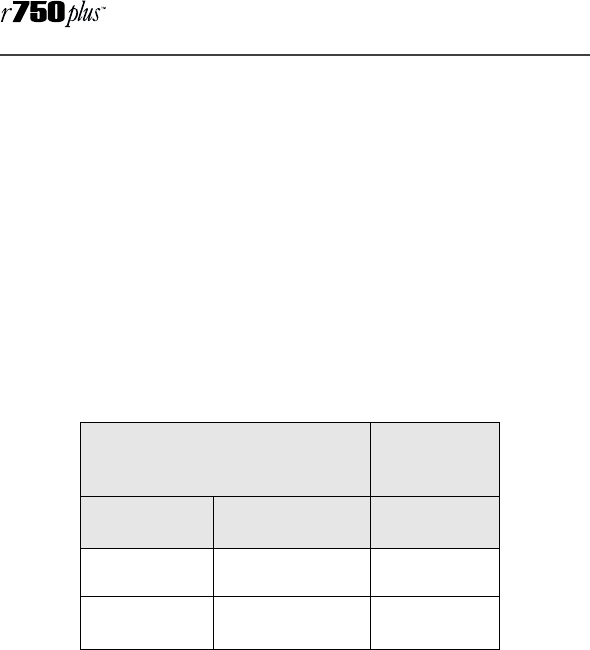
58
www.mot.com/iDEN
Optional Accessories
Batteries
NOTE: For best results, charge the batteries within the temperature
range of 10° C to 40° C (50° F to 104° F).
NOTE: Prolonged charging is not recommended. See Table 9 for battery
charging guidelines.
Charging the Battery
To get the maximum use from the battery, charge it overnight before
you use it for the first time. See Table 9 for battery charging times.
Table 9: Battery Charging Times
Battery Operating Instructions
•Extreme temperatures will degrade battery performance. Do not
store your battery where temperatures exceed 60°C (140°F) or
fall below -20°C (4°F).
•The battery capacity will be degraded if stored for long periods
while fully charged. If long term storage is required, store at half
capacity.
•For optimal battery life, use a Motorola iDEN approved NiMH
Charger with your Motorola iDEN NiMH battery. Other chargers
may not fully charge your NiMH or may yield a reduced number
of charge cycles.
Motorola Battery Charging
Time to
90%:
Kit Number Description
Chemistry
Rapid
Charger
NTN9037A 1500mAh
NiMH
100
minutes
NTN9038A Intrinsically
Safe*
* For users who work in hazardous environ-
ments, Intrinsically Safe Battery, NTN9038A,
is offered. Please contact your carrier for
availability and the specific environments
approved for this battery.
100
minutes
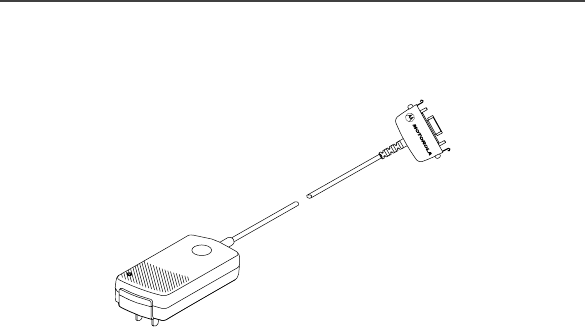
Optional Accessories
59
Rapid Travel Charger
Using the NTN9035A Rapid Travel Charger, you can charge a battery
from an electrical outlet.
Figure 2. Using the Travel Charger
Using the Rapid Travel Charger (110V/220V/240V)
1. While holding the r750plus phone with its front facing you,
insert the accessory connector (with the Motorola logo facing
you) into the slot on the bottom of the r750plus phone until you
hear a click.
2. Flip open the prongs, and plug the Rapid Travel Charger trans-
former into an AC wall outlet. The power light (green LED) on
the accessory power supply will come on.
Rapid Travel Charger Operating Specifications
Input voltage range: 110V/220V/240V.
Operating temperature range: 0°C to +50°C.
Rapid Travel Charger
Accessory Connector
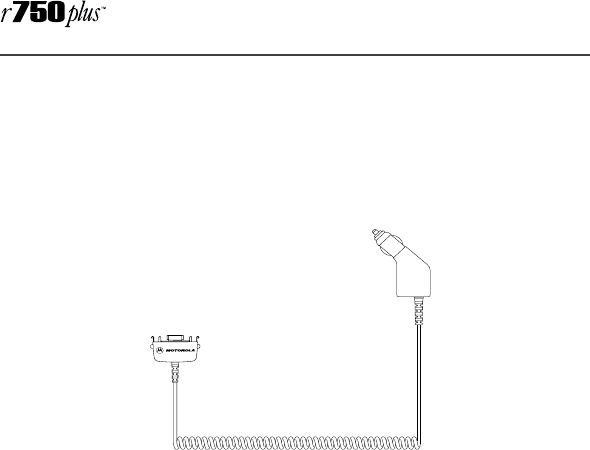
60
www.mot.com/iDEN
Vehicular Battery Charger
The NTN9034A Vehicular Battery Charger enables in-vehicle
communications by charging the NiMH battery and providing power
to your r750plus phone.
The power light (green LED) will light when the Vehicular Battery
Charger is receiving power.
Figure 3. Using the Vehicular Battery Charger
Using the Vehicular Battery Charger
1. Attach the Vehicular Battery Charger’s accessory connector to
the bottom of the r750plus phone. While holding the r750plus
phone with its front toward you, insert the accessory connector
(with the Motorola logo facing you) into the slot on the bottom
of the r750plus phone until you hear a click.
2. Remove the vehicle’s cigarette lighter plug from the cigarette
lighter receptacle.
3. Plug the Vehicular Battery Charger into the cigarette lighter
receptacle. The power light (green LED) will turn on.
4. The r750plus phone may be turned off, turned on, or in use.
Removing the Vehicular Battery Charger
1. Unplug the Vehicular Battery Charger from the vehicle’s ciga-
rette lighter receptacle.
2. Press the buttons on the accessory connector and pull the acces-
sory connector from the bottom of the r750plus phone.
Operating Specifications
Operating voltage range: 10.8 - 33.0 Vdc.
Operating temperature range: -30°C to +60°C
Accessory Connector
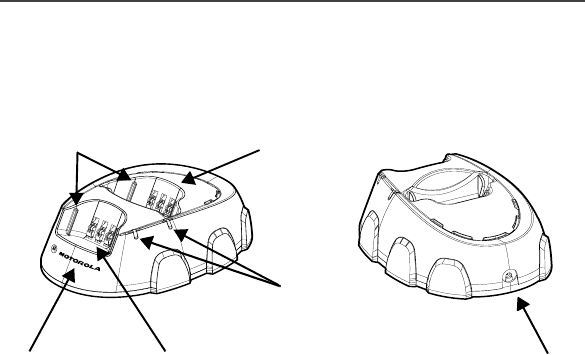
Optional Accessories
61
Desktop Dual-Pocket Charger
The NTN9036A Desktop Dual-Pocket Charger charges Motorola
authorized batteries, as listed on Page 58, for the r750plus phone.
Figure 4. Desktop Dual-Pocket Charger
Charging a battery
1. Plug the power supply DC jack into the receptacle in the back of
the Desktop Dual-Pocket Charger.
2. Plug the transformer end of the power-supply cord into any
standard AC wall outlet.
3. Insert an r750plus phone with an attached battery, into the
charger’s front pocket. To do this, align the slots on the sides of
the battery with the rails on the sides of the charger pocket.
Make sure the metal contacts on the back of the battery are in
contact with the charger contacts.
4. If the r750plus phone is properly seated in the front pocket, the
charger’s front pocket LED indicator will light.
5. The charger has the capability of displaying the battery’s charge
status. The indicator will show the following: solid red=1- 30%;
solid yellow=31 - 60%; flashing green=61 - 90%; solid green=91 -
100%.
Data Operation
1. Insert the flat end of the iDEN Data Cable (FLN9581A) into the
phone’s bottom Accessory connector.
2. Connect the opposite end of the data cable to the PC.
NOTE: Charging times may vary when performing data operations.
(DC jack)
Rear pocket – Battery only
Front pocket – phone with Battery
Pin charge contacts
LED indicators
Power supply cord receptacle
Alignment rails
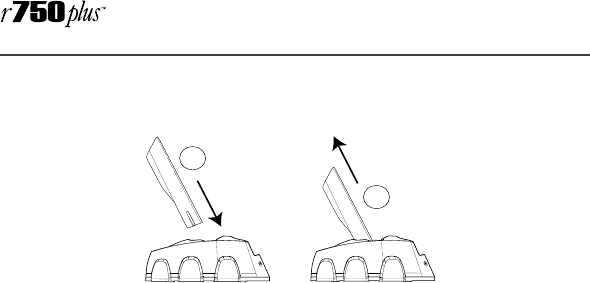
62
www.mot.com/iDEN
Inserting and removing a battery from the rear pocket
Figure 5. Adding and Removing a Battery from the Rear Pocket
1. Insert the battery with the Motorola label facing forward. To do
this, align the sides of the battery with the charger rails.
2. Make sure the metal contacts on the back of the battery are in
contact with the charging contacts.
3. To remove the battery, pull it up and out of the Charger.
NOTE: If a battery is in the rear pocket, and the phone with a battery is
inserted into the front pocket, the battery in the front pocket
will charge to full capacity before the battery in the rear pocket
is charged. The LED for the rear pocket flashes yellow, indicating
that its battery is waiting to be charged.
NOTE: To remove the battery from the rear pocket, hold the base of
the charger and pull the battery straight up.
Desktop Charger Status
The Charger displays the battery’s charge status. The indicator will
show one of the following:
solid red =1-30%; solid yellow =31-60%; flashing green =61-90%;
solid green =91-100%.
Desktop Charger Troubleshooting
If the battery is not charging and you see:
A flashing yellow indicator -
• The flashing yellow LED is used to indicate that the
Charger’s pocket is in a wait state.
• If a battery is in the rear pocket, the rear pocket’s LED
continues to flash yellow until the battery in the front
pocket is more than 90% charged (front pocket’s LED is
solid green). This is normal operation.
• To protect your battery’s life expectancy, the Charger does
not rapid charge a battery when its temperature is below
5oC (41oF) or above 45oC (113oF).
1
2
I
nsert
R
emove

Optional Accessories
63
No LED indication -
• Check that the r750plus phone with battery, or a battery
alone, is inserted correctly.
• Make sure that the power supply is plugged into an
appropriate AC outlet and that the connector is properly
seated.
• Rear pocket only: Remove the battery from the Charger. Use
an ordinary pencil eraser to clean the three metal contacts
on the battery and then place the battery in the Charger.
• If the LED indicator remains turned OFF, the battery may
be defective and should be replaced.
Flashing red LED indicator -
• Remove the battery from the Charger. Use an ordinary
pencil eraser to clean the three metal contacts on the
battery and then place the battery in the Charger.
• If the LED indicator remains turned OFF, the battery may
be defective and should be replaced.
Both LEDs flash red -
• This indicates that the incorrect power supply is plugged
in.
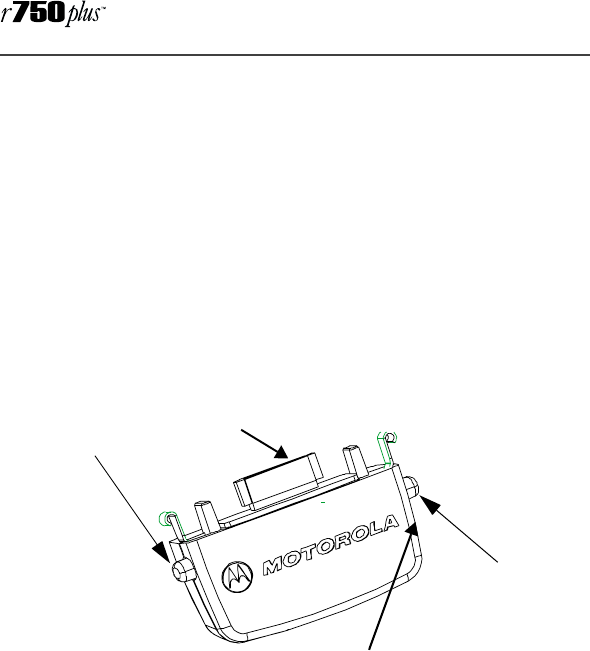
64
www.mot.com/iDEN
Audio Adapter
The FLN2854A Audio Adapter connects an earpiece microphone or
headset to your r750plus phone for privacy and hands-free operation.
The Audio Adapter fits onto the bottom of the r750plus phone and
provides a standard 2.5mm jack connection for an earpiece
microphone or headset.
The following audio accessories are compatible with the audio
adapter:
•Earpiece with Microphone (NTN8367)
•Headset with Boom Microphone (NTN8513)
•Lightweight Headset with Microphone (NTN8496)
•Over-the-Ear Style Headset (NTN8497)
Figure 6. Using the Audio Adapter
Using the Audio Adapter
1. Hold the phone and the Audio Adapter facing you so that you
see the Motorola logo on the adapter.
2. Insert the Audio Adapter’s connector into the r750plus phone
Bottom Accessory Connector. You will hear the connector snap
into place.
NOTE: When the audio adapter and earpiece or headset are connected,
all audio, including tones, will be routed to the audio accessory’s
earpiece.
Attaching/Detaching the Earpiece Microphone or Headset
1. Insert the 2.5mm plug of the earpiece microphone or headset
cord into the jack of the Audio Adapter.
Au
di
o A
d
apter
Connector
2.5mm jack
Button
Release
Button
Release

Optional Accessories
65
2. Pull on the plug, not on the cord, to remove the earpiece
microphone.
Removing the Audio Adapter
1. Simultaneously press the release buttons located on either side of
the Audio Adapter and pull the Audio Adapter from the r750plus
phone.
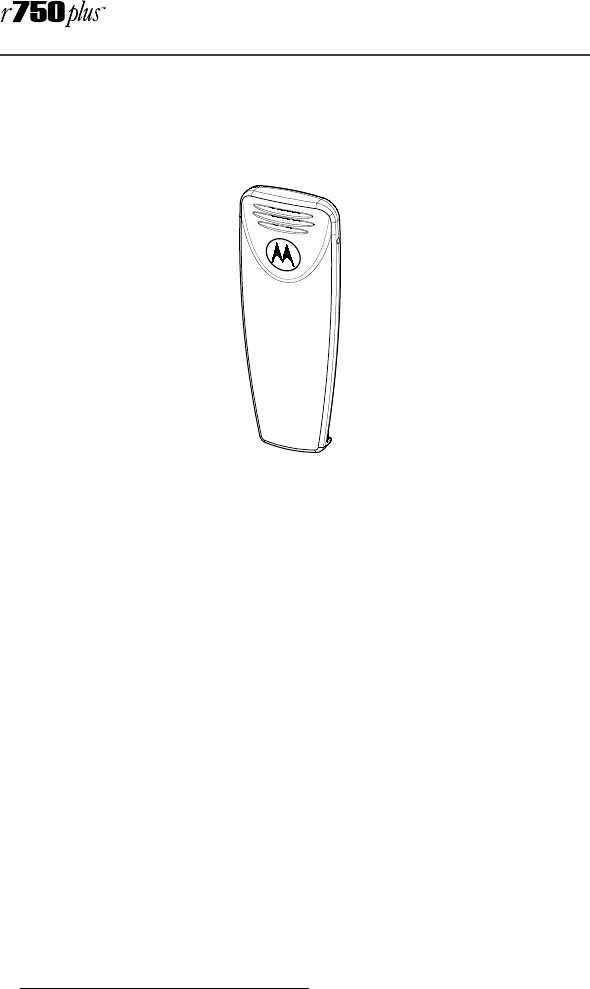
66
www.mot.com/iDEN
Battery Belt Clip
The NTN1535A Battery Belt Clip provides a convenient means by
which to carry your r750plus phone with you.
Figure 7. Battery Belt Clip
Using the Battery Belt Clip
1. Slide the belt clip into the back of the battery (push until the clip
locks into place).
2. Clip the r750plus phone to your belt.
3. To remove the clip from the battery, push the holder tab out-
ward and slide the clip out of the battery.
NOTE: A small flathead screwdriver is recommended to push the holder
tab outward when removing the clip.
Leather Carry Case*
•The FLN9580A Leather Carry Case protects your r750plus phone
while on the go
•Includes a leather belt clip for easy attachment to a belt or purse
•Accommodates most r750plus phone accessories including travel
chargers, audio accessories, vehicle accessories, and data
accessories.
*Remove the belt clip from the phone before inserting it into the
leather case.
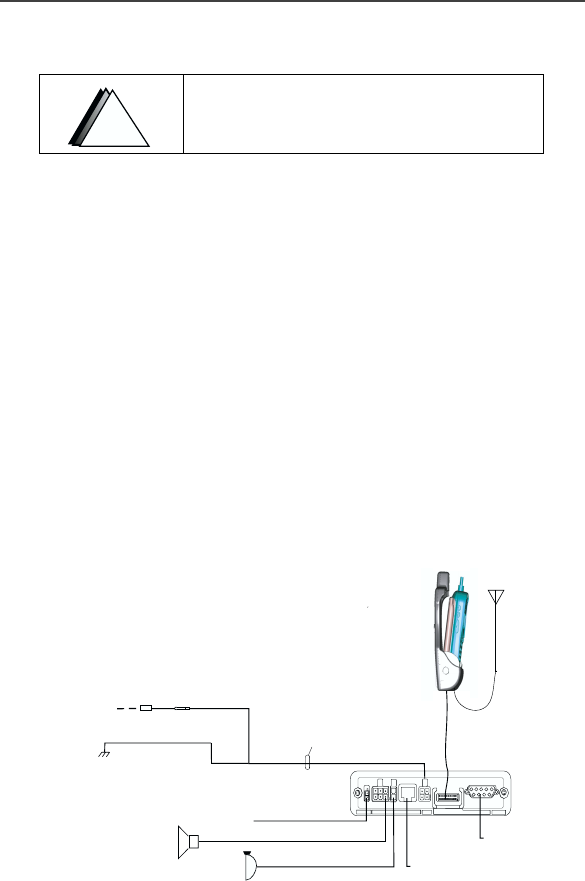
Optional Accessories
67
Hard-Install Car Kit
NOTE: The FLN2570A Hard-Install Car Kit enables in-vehicle communi-
cations by providing extended RF coverage, the ability to con-
nect to 12-Vdc or 24-Vdc power sources, data interface, and the
ability to rapid-charge the battery.
The FLN2570A includes:
•Visor Microphone
•Remote PTT
•External 4-watt Speaker
•Phone Coupler
•Junction Box.
An external Push-To-Talk (PTT) button is also included. When the
phone is turned off, the Hard-Install Car Kit charges the Standard
battery in 75 minutes to 90% capacity. Charging time will be longer
if the phone is operational during charge time.
Figure 8. Using the Hard-Install Car Kit
The Hard-Install Car Kit is also a charger.
Therefore, DO NOT operate this kit and the
Vehicular Battery Charger at the same time.
Caution
DATA CABLE
(OPTIONAL)
FROM REMOTE-MOUNT PTT
EXTERNAL
SPEAKER
HANDS-FREE
VISOR
MICROPHONE
POWER
CABLE
VEHICLE
ANTENNA
PALM MIC
(Optional)
TO IGNITION
6-AMP
BLADE-TYPE
FUSE
BULLET-TYPE
CONNECTOR
Red
VEHICLE
CHASSIS
Black
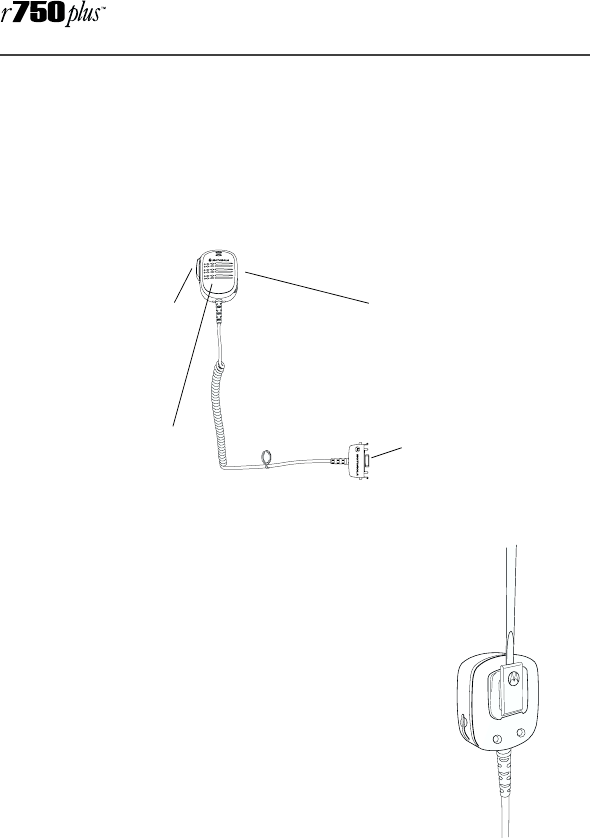
68
www.mot.com/iDEN
Remote Speaker/Microphone
The FLN2800A Remote Speaker/Microphone (RSM) provides a
convenient means of communicating by having a speaker, a
microphone, and a Push-to-Talk (PTT) button in a single, hand-held
or clip-on accessory. The RSM also includes a 3.5 mm audio jack
(located on the opposite side of the PTT) to accept secondary receiver
audio accessories.
Attaching and Removing the Swivel Clip
To attach the swivel clip to the remote speaker/
microphone:
1. Position the clip with the release tab point-
ing upward and align the metal plate edges
of the swivel clip with the plastic slots on
the RSM’s rear housing.
2. While holding the clip open, slide the
metal plate in and push down firmly until
the parts snap together.
To remove the swivel clip from the remote
speaker/microphone:
1. Carefully push the flat blade of a #2 slotted
screwdriver (or similar instrument) between
the RSM’s housing and the swivel clip’s
metal release tab, as shown in the figure.
2. While performing step 1, push the swivel clip toward the top of
the RSM.
3. As the release tab disengages, remove the screwdriver and pull
the swivel clip completely away from the unit.
Connecting the Remote Speaker/Microphone to the Portable
To attach the accessory connector, position the portable so that it
faces you.
Speaker /
Microphone
PTT Button 3.5mm Audio Jack
Accessory
Connector
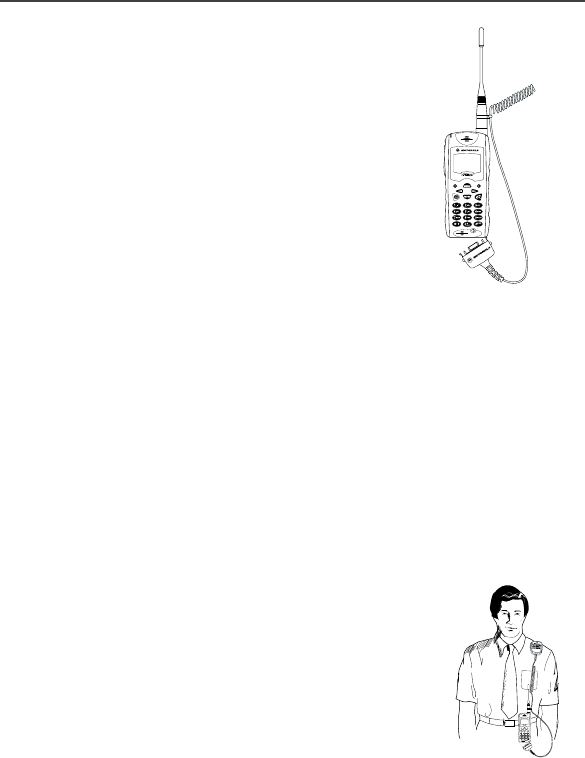
Optional Accessories
69
1. Position the accessory connector so that
its coiled cord extends from the bottom
of the portable and its latch is on your
left.
2. Insert the RSM’s accessory connector into
the bottom of the portable (push both
tabs on the accessory connector when
inserting into the portable).
3. Push the accessory connector firmly
against the portable to make sure it is
held in place.
4. Attach the smaller end of the cable-
restraint clip on the straight portion of
the coiled cord.
5. Attach the larger end of the cable-restraint clip to the base of the
antenna.
6. Adjust the cord length in the smaller end of the cable restraint
clip until it is comfortable.
Operation
Please read the safety information contained in the user’s guide
supplied with the portable before operating this equipment.
The remote speaker/microphone (RSM) only operates when the
portable is in the voice-dispatch mode (group or private call).
Wearing the RSM
For optimum performance from your RSM, wear
the radio and RSM so that the accessory cord will
not cross over or touch the antenna. Also, try to
wear the radio and accessory combination fairly
close to each other to avoid strain on the
accessory connector.
Receiving:
When the RSM is connected to the radio’s bottom accessory
connector, the radio’s speaker is muted, and the audio is only heard
from the RSM speaker. Similarly, when a secondary receiver audio
accessory is plugged into the 3.5 mm audio jack, audio to the RSM is
rerouted to the secondary accessory.
Transmitting:
Connecting the remote speaker/microphone to the radio does not
disable the radio’s microphone and PTT button.
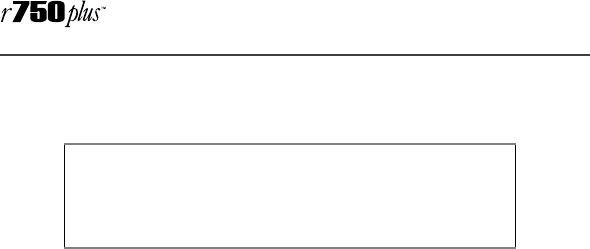
70
www.mot.com/iDEN
Safety and General Information
RF Operational Characteristics
Your radio product contains a radio frequency transmitter to convey
the information you wish to send as well as occasional automatic
signals used to sustain connection to the wireless network, and a
receiver which enables you to receive communication and
connection information from the network.
Exposure To Radio Frequency Energy
Your Motorola Radio Product is designed to comply with the
following national and international standards and guidelines
regarding exposure of human beings to radio frequency
electromagnetic energy:
•United States Federal Communications Commission, Code of
Federal Regulations; 47 CFR part 2 sub-part J
•American National Standards Institute (ANSI) / Institute of
Electrical and Electronics Engineers (IEEE). C95. 1-1992
•Institute of Electrical and Electronics Engineers (IEEE). C95. 1-
1999 Edition
•National Council on Radiation Protection and Measurements
(NCRP) of the United States, Report 86, 1986
•International Commission on Non-Ionizing Radiation
Protection (ICNIRP) 1998
•National Radiological Protection Board of the United Kingdom,
1995
•Ministry of Health (Canada). Safety Code 6. Limits of Human
Exposure to Radiofrequency Electromagnetic Fields in the
Frequency Range from 3 kHz to 300 GHz, 1999.
•Australian Communications Authority Radiocommunications
(Electromagnetic Radiation - Human Exposure) Standard 1999
(applicable to wireless phones only)
To assure optimal radio product performance and make sure human
exposure to radio frequency electromagnetic energy is within the
guidelines set forth in the above standards, always adhere to the
following procedures:
IMPORTANT INFORMATION ON SAFE AND
EFFICIENT OPERATION.
READ THIS INFORMATION BEFORE USING YOUR
INTEGRATED MULTI-SERVICE PORTABLE RADIO.

Safety and General Information
71
Portable Radio Product Operation and EME Exposure
Antenna Care
Use only the supplied or an approved antenna. Unauthorized
replacement antennas, modifications, or attachments could damage
the phone and may violate FCC regulations.
DO NOT hold the antenna when the radio product is “IN USE”.
Holding the antenna affects call quality and may cause the radio
product to operate at a higher power level than needed.
Phone Operation
When placing or receiving a phone call, or using the group and
private call functions with a Group/Private Speaker OFF (muted
speaker icon visible in the display), hold your radio product as you
would a wireline telephone. Speak directly into the microphone.
Two-way radio operation
When using your radio product as a traditional
two-way radio while making group or private calls
with the Group/Private Speaker ON (no speaker
icon visible in the display), hold the radio product
in a vertical position with the microphone one
to two inches (2.5 to 5 cm) away from the lips.
Body-worn operation
To maintain compliance with FCC RF exposure guidelines, if you
wear a radio product on your body when transmitting, always place
the radio product in a Motorola supplied or approved clip, holster,
case harness, or body harness. Use of non-Motorola-approved
accessories may exceed FCC RF exposure guidelines. If you do not
use a body-worn accessory, ensure the antenna is at least one
inch (2.5cm) from your body when transmitting.
Data operation
When using any data feature of the radio product, with or without
an accessory cable, position the antenna of the radio product at
least one inch (2.5 cm) from the body.

72
www.mot.com/iDEN
Approved Accessories
For a list of approved Motorola accessories call 1-800-453-0920, visit
our website at www.mot.com/iden, or look in the accessory section
of this manual.
Electro Magnetic Interference/Compatibility
NOTE: Nearly every electronic device is susceptible to
electromagnetic interference (EMI) if inadequately shielded,
designed or otherwise configured for electromagnetic compatibility.
Facilities
To avoid electromagnetic interference and/or compatibility conflicts,
turn off your radio product in any facility where posted notices
instruct you to do so. Hospitals or health care facilities may be using
equipment that is sensitive to external RF energy.
Aircraft
When instructed to do so, turn off your radio product when on
board an aircraft. Any use of a radio product must be in accordance
with applicable regulations per airline crew instructions.
Medical Devices
Pacemakers
The Health Industry Manufacturers Association recommends that a
minimum separation of 6 inches (15 cm) be maintained between a
handheld wireless radio product and a pacemaker. These
recommendations are consistent with the independent research by,
and recommendations of, Wireless Technology Research.
Persons with pacemakers should:
•ALWAYS keep the radio product more than 6 inches (15 cm)
from their pacemaker when the radio product is turned ON.
•Not carry the radio product in a breast pocket.
•Use the ear opposite the pacemaker to minimize the potential
for interference.
•Turn the radio product OFF immediately if you have any reason
to suspect that interference is taking place.

Safety and General Information
73
Hearing Aids
Some digital wireless radio products may interfere with some hearing
aids. In the event of such interference, you may want to consult your
hearing aid manufacturer to discuss alternatives.
Other Medical Devices
If you use any other personal medical device, consult the
manufacturer of your device to determine if it is adequately shielded
from external RF energy. Your physician may be able to assist you in
obtaining this information.
Use While Driving
Check the laws and regulations on the use of radio products in the
area where you drive. Always obey them.
When using the radio product while driving, please:
•Give full attention to driving and to the road.
•Use hands-free operation, if available.
•Pull off the road and park before making or answering a call if
driving conditions so require.
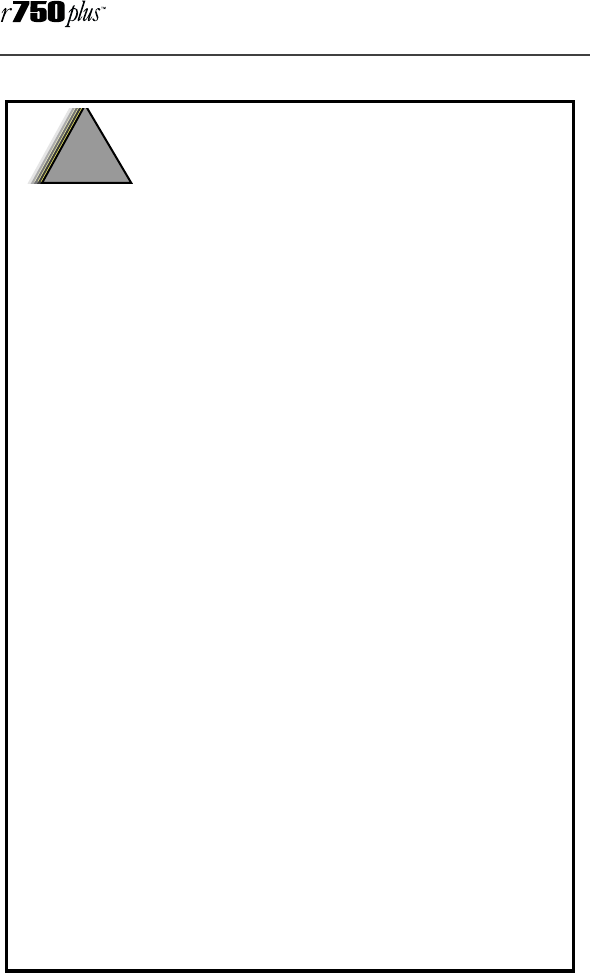
74
www.mot.com/iDEN
Operational Warnings
For Vehicles Equipped with an Air Bag
Do not place a portable radio product in the area over the air
bag or in the air bag deployment area. An air bag inflates with
great force. If a portable radio is placed in the air bag
deployment area and the air bag inflates, the radio product may
be propelled with great force and cause serious injury to
occupants of the vehicle.
Potentially Explosive Atmospheres
Turn off your radio product, prior to entering any area with a
potentially explosive atmosphere, unless it is a radio product
type especially qualified for use in such areas (for example,
Factory Mutual Approved). Do not remove, install, or charge
batteries in such areas. Sparks in a potentially explosive
atmosphere can cause an explosion or fire resulting in bodily
injury or even death.
NOTE: The areas with potentially explosive atmospheres referred
to above include fueling areas such as below decks on
boats, fuel or chemical transfer or storage facilities, areas
where the air contains chemicals or particles, such as grain,
dust or metal powders, and any other area where you
would normally be advised to turn off your vehicle engine.
Areas with potentially explosive atmospheres are often but
not always posted.
Blasting Caps and Areas
To avoid possible interference with blasting operations, turn off
your radio product when you are near electrical blasting caps, in
a blasting area, or in areas posted: “Turn off two-way radio”.
Obey all signs and instructions.
!
WARNING
!
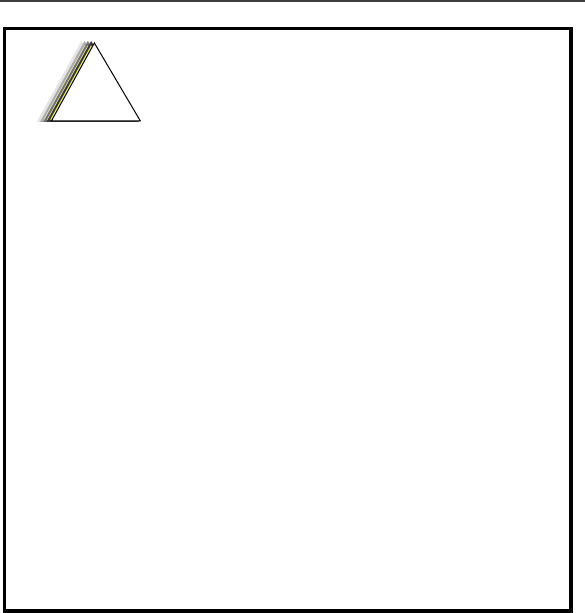
Safety and General Information
75
Cleaning and Drying Considerations
Using a leather carry case may help protect the surfaces and help
prevent liquids (e.g., rain) from entering into the interior of the radio
product. This product is not water proof, and exposing the unit to
liquids may result in permanent damage to the unit.
If your radio product interior gets wet, then do not try to accelerate
drying with the use of an oven or a dryer as this will damage the
radio product and void the warranty. Instead, do the following:
1. Immediately power off the radio product.
2. Remove Battery from radio product.
3. Shake excess liquid from phone.
4. Place phone and battery in an area that is at room temperature
and has good air flow.
5. Let phone and battery dry for 72 hours before reconnecting the
battery and/or powering on the phone.
Operational Cautions
Antennas
Do not use any portable radio product that has a damaged
antenna. If a damaged antenna comes into contact with your
skin, a minor burn can result.
Batteries
All batteries can cause property damage and/or bodily injury,
such as burns if a conductive material such as jewelry, keys, or
beaded chains touches exposed terminals. The conductive
material may complete an electrical circuit (short circuit) and
become quite hot. Exercise care in handling any charged battery,
particularly when placing it inside a pocket, purse, or other
container with metal objects.
When the battery is detached from the phone, your batteries are
packed with a protective battery cover. Please use this cover for
storing your batteries when not in use.
!
C a u t i o n

76
www.mot.com/iDEN
If the phone does not work after following the steps listed above,
contact your dealer for servicing information.
Clean the external surfaces of the radio product with a damp cloth,
using a mild solution of dishwashing detergent and water. Some
household cleaners may contain chemicals that could seriously
damage the radio product. Avoid the use of any petroleum-based
solvent cleaners. Also, avoid applying liquids directly on the radio
product.

Intrinsically Safe Radio Information
77
Intrinsically Safe Radio
Information
FMRC Approved Equipment
Anyone intending to use a radio in a location where hazardous
concentrations of flammable material exist (hazardous atmosphere)
is advised to become familiar with the subject of intrinsic safety and
with the National Electric Code NFPA 70 (National Fire Protection
Association) Article 500 (hazardous [classified] locations).
An Approval Guide, issued by Factory Mutual Research Corporation
(FMRC), lists manufacturers and the products approved by FMRC for
use in such locations. FMRC has also issued a voluntary approval
standard for repair service (“Class Number 3605”).
FMRC Approval labels are attached to the radio to identify the unit
as being FM Approved for specified hazardous atmospheres. This
label specifies the hazardous Class/Division/Group along with the
part number of the battery that must be used. Depending on the
design of the portable unit, this FM label can be found on the back of
the radio housing or the bottom of the radio housing.Their Approval
mark is shown below.
FM
APPROVED
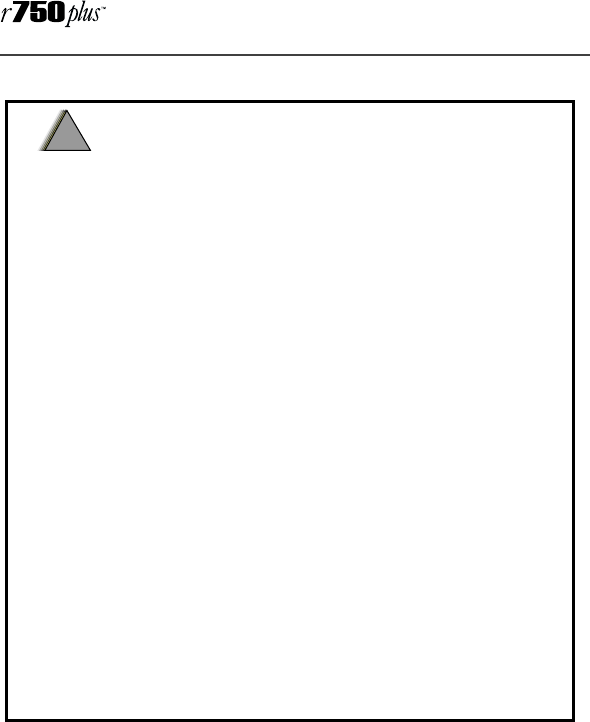
78
www.mot.com/iDEN
Radios must ship from the Motorola manufacturing facility with the
hazardous atmosphere capability and FM Approval labeling. Radios
will not be “upgraded” to this capability and labeled in the field.
A modification changes the unit’s hardware from its original design
configuration. Modifications can only be done by the original
product manufacturer at one of its FMRC audited manufacturing
facilities.
Do not operate radio communications equipment in a
hazardous atmosphere unless it is a type especially qualified
(e.g. FMRC Approved) for such use. An explosion or fire may
result.
Do not operate the FMRC Approved Product in a hazardous
atmosphere if it has been physically damaged (e.g. cracked
housing). An explosion or fire may result.
Do not replace or charge batteries in a hazardous atmosphere.
Contact sparking may occur while installing or removing
batteries and cause an explosion or fire.
Do not replace or change accessories in a hazardous
atmosphere. Contact sparking may occur while installing or
removing accessories and cause an explosion or fire.
Do not operate the FMRC Approved Product unit in a hazardous
location with the accessory contacts exposed. Keep the
connector cover in place when accessories are not used.
Turn radio off before removing or installing a battery or
accessory.
Do not disassemble the FMRC Approved Product unit in any
way that exposes the internal electrical circuits of the unit.
!
W A R N I N G
!
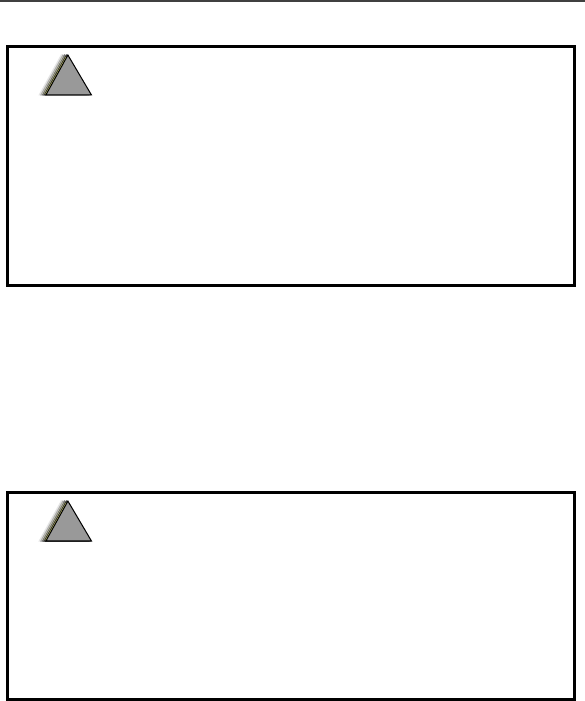
Intrinsically Safe Radio Information
79
Unauthorized or incorrect modification of an FMRC Approved
Product unit will negate the Approval rating of the product.
Repair of FMRC Approved Products
REPAIRS FOR MOTOROLA FMRC APPROVED PRODUCTS
ARE THE RESPONSIBILITY OF THE USER.
You may want to consider using a repair facility that operates under
3605 repair service approval.
FMRC’s Approval Standard Class Number 3605 is subject to change
at any time without notice to you, so you may want to obtain a
current copy of 3605 from FMRC. Per the December, 1994
publication of 3605, some key definitions and service requirements
are as follows:
Repair
A repair constitutes something done internally to the unit that
would bring it back to its original condition Approved by FMRC. A
repair should be done in an FMRC Approved facility.
Items not considered as repairs are those in which an action is
performed on a unit which does not require the outer casing of the
Failure to use an FMRC Approved Product unit with an FMRC
Approved battery or FMRC Approved accessories specifically
approved for that product may result in the dangerously unsafe
condition of an unapproved radio combination being used in a
hazardous location.
!
W A R N I N G
!
Incorrect repair or relabeling of any FMRC Approved Product
unit could adversely affect the Approval rating of the unit.
Use of a radio that is not intrinsically safe in a hazardous
atmosphere could result in serious injury or death.
!
W A R N I N G
!

80
www.mot.com/iDEN
unit to be opened in a manner which exposes the internal electrical
circuits of the unit. You do not have to be an FMRC Approved Repair
Facility to perform these actions.
Relabeling
The repair facility shall have a method by which the replacement of
FMRC Approval labels are controlled to ensure that any relabeling is
limited to units that were originally shipped from the Manufacturer
with an FM Approval label in place. FMRC Approval labels shall not
be stocked by the repair facility. An FMRC Approval label shall be
ordered from the original manufacturer as needed to repair a specific
unit. Replacement labels may be obtained and applied by the repair
facility providing satisfactory evidence that the unit being relabeled
was originally an FMRC Approved unit. Verification may include,
but is not limited to: a unit with a damaged Approval label, a unit
with a defective housing displaying an Approval label, or a customer
invoice indicating the serial number of the unit and purchase of an
FMRC Approved model.
Do Not Substitute Options or Accessories
The Motorola communications equipment certified by Factory
Mutual is tested as a system and consists of the FM Approved
portable, FM Approved battery, and FM Approved accessories or
options, or both. This Approved portable and battery combination
must be strictly observed. There must be no substitution of items,
even if the substitute has been previously Approved with a different
Motorola communications equipment unit. Approved
configurations are listed in the FM Approval guide published by
FMRC, or in the product FM Supplement. This FM Supplement is
shipped with FM Approved radio and battery combination from the
manufacturer. The Approval guide, or the Approval standard Class
Number 3605 document for repairs and service, can be ordered
directly through Factory Mutual Research Corporation located in
Norwood, Massachusetts.
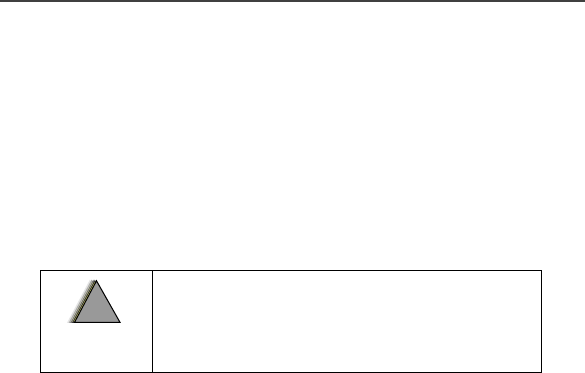
Accessory Safety Information
81
Accessory Safety Information
IMPORTANT: SAVE THESE ACCESSORY SAFETY INSTRUCTIONS
•Before using any battery or battery charger, read all the
instructions for and cautionary markings on (1) the battery, (2)
the battery charger, which may include a separate wall-mounted
power supply or transformer, and (3) the radio product using the
battery.
•Do not expose any battery charger to water, rain, or snow as
they are designed for indoor or in-vehicle use only.
•To reduce the risk of damage to the cord or plug, pull by the plug
rather than the cord when you disconnect the battery charger
from the power source outlet.
•Do not operate any battery charger with a damaged cord or plug
- replace them immediately.
•Battery chargers may become warm during operation, but not
hot. If it becomes hot to the touch, unplug it from the power
outlet immediately and discontinue its use.
•Use of a non-recommended attachment to a battery charger may
result in a risk of fire, electric shock, or injury to persons.
•Make sure the battery charger power cord is located so that it
will not be stepped on, tripped over, or subjected to damage or
stress.
•An extension cord should not be used with any battery charger
unless absolutely necessary. Use of an improper extension cord
could result in a risk of fire and electric shock. If an extension
cord must be used, make sure that:
❒The pins on the plug of the extension cord are the same num-
ber, size, and shape as those on the plug of the charger.
❒The extension cord is properly wired and in good electrical
condition.
❒The cord size is 18AWG for lengths up to 100 feet and 16AWG
for lengths up to 150 feet.
•Do not operate any battery charger if it has received a sharp
blow, has been dropped, or has been damaged in any way; take it
to a qualified service technician.
•Do not disassemble a battery charger; take it to a qualified
service technician when service or repair is required. Incorrect
reassembly may result in a risk of electric shock or fire.
To reduce the risk of injury, charge only the
rechargeable batteries listed in the Accessories
section of this manual. Other types of batteries may
burst, causing personal injury and damage.
!
W A R N I N G
!

82
www.mot.com/iDEN
•Maximum ambient temperature around the power supply or
transformer of any battery charger should not exceed 40°C
(104°F).
•The output power from the power supply or transformer must
not exceed the rating given on the Desktop Dual-Pocket
Charger.
•The disconnection from the line voltage is made by unplugging
the power supply from the AC receptacle.
•To reduce risk of electric shock, unplug any battery charger from
the outlet before attempting any maintenance or cleaning.
•For optimum charging performance, turn off the radio product
while charging it in any battery charger.
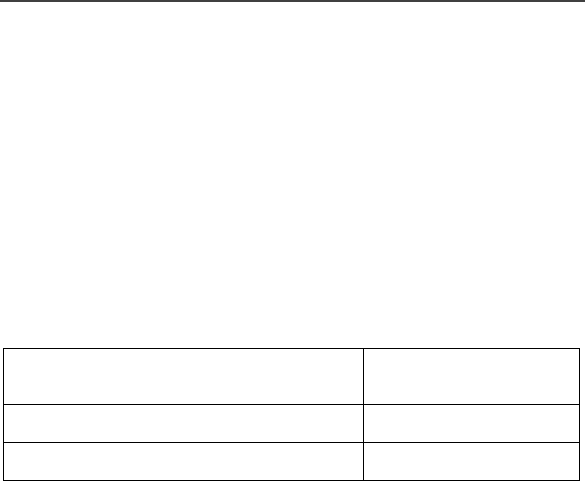
Warranty
83
Warranty
Limited Warranty Motorola Communication Products
NOTE: This Warranty applies within the fifty (50) united states and the
District of Columbia.
I. What This Warranty Covers and For How Long:
MOTOROLA, INC. (“MOTOROLA”) warrants the MOTOROLA
manufactured iDEN Communication Products listed below
(“Product”) against defects in material and workmanship under
normal use and service for a period of time from the date of purchase
as scheduled below:
Rechargeable Batteries will be replaced during the applicable
warranty period if:
a. the battery capacity falls below 80% of rated capacity, or
b. the battery develops leakage.
MOTOROLA, at its options, will at no charge either repair the
Product (with new or reconditioned parts), replace it (with a new or
reconditioned Product), or refund the purchase price of the Product
during the warranty period provided it is returned in accordance
with the terms of this warranty. Replaced parts or boards are
warranted for the balance of the original applicable warranty period.
All replaced parts of Product shall become the property of
MOTOROLA.
This express limited warranty is extended by MOTOROLA to the
original end user purchaser only and is not assignable or transferable
to any other party. This is the complete warranty for the Product
manufactured by MOTOROLA. MOTOROLA assumes no obligations
or liability for additions or modifications to this warranty unless
made in writing and signed by an officer of MOTOROLA. Unless
made in a separate agreement between MOTOROLA and the original
end user purchaser, MOTOROLA does not warrant the installation,
maintenance or service of the Product.
iDEN Subscriber Digital Mobile and
Portable Units
One (1) Year
Product Accessories One (1) Year
Batteries One (1) Year

84
www.mot.com/iDEN
MOTOROLA cannot be responsible in any way for any ancillary
equipment not furnished by MOTOROLA which is attached to or
used in connection with the Product, or for operation of the Product
with any ancillary equipment, and all such equipment if expressly
excluded from this warranty. Because each system which may use
the Product is unique, MOTOROLA disclaims liability for range,
coverage, or operation of the system as a whole under this warranty.
II. General Provisions:
This warranty sets forth the full extent of MOTOROLA’S
responsibilities regarding the Product, Repair, replacement or refund
of the purchase price, at MOTOROLA’S options, is the exclusive
remedy. THIS WARRANTY IS GIVEN IN LIEU OF ALL OTHER
EXPRESS WARRANTIES. IMPLIED WARRANTIES, INLCUDING
WITHOUT LIMITATION, IMPLIED WARRANTIES OF
MERCHANTABILITY AND FITNESS FOR A PARTICULAR PURPOSE,
ARE LIMITED TO THE DURATION OF THIS LIMITED WARRANTY.
IN NO EVENT SHALL MOTOROLA BE LIABLE FOR DAMAGES IN
EXCESS OF THE PURCHASE PRICE OF THE PRODUCT, FOR ANY
LOSS OF USE, LOSS OF TIME, INCONVENIENCE, COMMERCIAL
LOSS, LOST PROFITS OR SAVINGS OR OTHER INCIDENTAL,
SPECIAL OR CONSEQUENTIAL DAMAGES ARISING OUT OF THE
USE OR INABILITY TO USE SUCH PRODUCT, TO THE FULL EXTENT
SUCH MAY BE DISCLAIMED BY LAW.
III. State Law Rights:
SOME STATES DO NOT ALLOW THE EXCLUSION OR LIMITATION
OF INCIDENTAL OR CONSEQUENTIAL DAMAGES, OR LIMITATION
ON HOW LONG AN IMPLIED WARRANTY LASTS, SO THE ABOVE
LIMITATIONS OR EXCLUSIONS MAY NOT APPLY.
This warranty gives specific legal rights, and there may be other
rights which may vary from state to state.
IV. How to Get Warranty Service:
You must provide proof of purchase (bearing the date of purchase
and Product item serial number) in order to receive warranty service
and, also, deliver or send the Product item, transportation and
insurance prepaid, to an authorized warranty service location.
Warranty service will be provided by MOTOROLA through one of its
authorized warranty service locations. If you first contact the
company which sold you the Product (e.g., dealer or communication
service provider), it can facilitate your obtaining warranty service.

Warranty
85
You can also call MOTOROLA at 1-800-453-0920 for warranty service
location information.
V. What This Warranty Does Not Cover:
a. Defects or damage resulting from use of the Product in
other than its normal and customary manner.
b. Defects or damage from misuse, accident, water, or neglect.
c. Defects or damage from improper testing, operation, main-
tenance, installation, alteration, modification, or adjust-
ment.
d. Breakage or damage to antennas unless caused directly by
defects in material workmanship.
e. A Product subjected to unauthorized Product modifications,
disassemblies or repairs (including, without limitation, the
addition to the Product of non-MOTOROLA supplied equip-
ment) which adversely affect performance of the Product or
interfere with MOTOROLA’S normal warranty inspection
and testing of the Product to verify any warranty claim.
f. Product which has had the serial number removed or made
illegible.
g. Rechargeable batteries if:
(1). Any of the seals on the battery enclosure of cells are broken
or shoe evidence of tampering.
(2) The damage or defect is caused by charging or using the
battery in equipment or service other than the Product for
which it is specified.
h. Freight costs to the repair depot.
i. A Product which, due to illegal or unauthorized alteration
of the software/firmware in the Product, does not function
in accordance with MOTOROLA’S published specifications
or the FCC type acceptance labeling in effect for the Product
at the time the Product was initially distributed from
MOTOROLA.
j. Scratches or other cosmetic damage to Product surfaces that
does not affect the operation of the Product.
k. Normal and customary wear and tear.
VI. Patent and Software Provisions:

86
www.mot.com/iDEN
MOTOROLA will defend, at its own expense, any suit brought
against the end user purchaser to the extent that it is based on a
claim that the Product or parts infringe a United States patent, and
MOTOROLA will pay those costs and damages finally awarded
against the end user purchaser in any such suit which are
attributable to any such claim, but such defense and payments are
conditioned on the following:
a. that MOTOROLA will be notified promptly in writing by
such purchaser of any notice of such claim;
b. that MOTOROLA will have sole control of the defense of
such suit and all negotiations for its settlement or compro-
mise; and
c. Should the Product or parts become, or in MOTOROLA’S
opinion be likely to become, the subject of a claim of
infringement of a United States patent, that such purchaser
will permit MOTOROLA, at its option and expense, either to
procure for such purchaser the right to continue to using
the Product or parts or to replace or modify the same so that
it becomes non-infringing or to grant such purchaser a
credit for the Product or parts as depreciated and accept its
return. The depreciation will be an equal amount per year
over the lifetime of the Product or parts as established by
MOTOROLA.
MOTOROLA will have no liability with respect to any claim of
patent infringement which is based upon the combination of the
Product or parts furnished hereunder with software, apparatus or
devices not furnished by MOTOROLA, nor will MOTOROLA have
any liability for the use of ancillary equipment or software not
furnished by MOTOROLA which is attached to or used in
connection with the Product or any parts thereof.
Laws in the United States and other countries preserve for
MOTOROLA certain exclusive rights for copyrighted MOTOROLA
software, such as the exclusive rights to reproduce in copies and
distribute copies of such MOTOROLA software. MOTOROLA
software may be used in only the Product in which the software was
originally embodied and such software in such Product may not be
replaced, copied, distributed, modified in any way, or used to
product any derivative thereof. No other use including, without
limitation, alteration, modification, reproduction, distribution, or
reverse engineering of such MOTOROLA software or exercise or
rights in such MOTOROLA software is permitted. No license is
granted by implication, estoppel or otherwise under MOTOROLA
patent rights or copyrights.
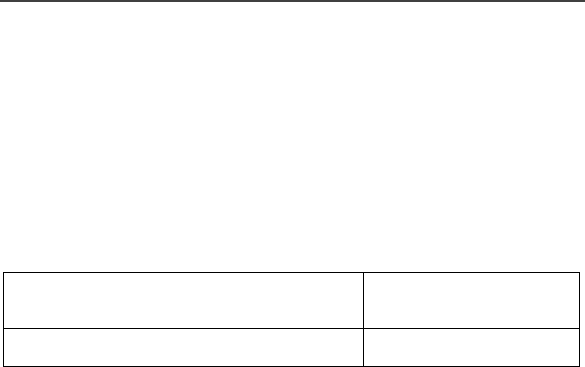
Warranty
87
Limited Warranty Motorola Communication Products
(International)
NOTE:This Warranty applies within Singapore and the Philippines.
I. What This Warranty Covers and For How Long:
MOTOROLA warrants the MOTOROLA manufactured iDEN
Communication Products listed below (“Product”) against defects in
material and workmanship under normal use and service for a period
of time from the date of purchase as scheduled below:
Rechargeable Batteries will be replaced during the applicable
warranty period if:
a. the battery capacity falls below 80% of rated capacity, or
b. the battery develops leakage.
MOTOROLA, at its options, will at no charge either repair the
Product (with new or reconditioned parts), replace it (with a new or
reconditioned Product), or refund the purchase price of the Product
during the warranty period provided it is returned in accordance
with the terms of this warranty. Replaced parts or boards are
warranted for the balance of the original applicable warranty period.
All replaced parts of Product shall become the property of
MOTOROLA.
This express limited warranty is extended by MOTOROLA to the
original end user purchaser only and is not assignable or transferable
to any other party. This is the complete warranty for the Product
manufactured by MOTOROLA. MOTOROLA assumes no obligations
or liability for additions or modifications to this warranty unless
made in writing and signed by an officer of MOTOROLA. Unless
made in a separate agreement between MOTOROLA and the original
end user purchaser, MOTOROLA does not warrant the installation,
maintenance or service of the Product.
MOTOROLA cannot be responsible in any way for any ancillary
equipment not furnished by MOTOROLA which is attached to or
used in connection with the Product, or for operation of the Product
with any ancillary equipment, and all such equipment if expressly
excluded from this warranty. Because each system which may use
iDEN Subscriber Digital Mobile and
Portable Units
One (1) Year
Product Accessories One (1) Year

88
www.mot.com/iDEN
the Product is unique, MOTOROLA disclaims liability for range,
coverage, or operation of the system as a whole under this warranty.
II. General Provisions:
This warranty sets forth the full extent of MOTOROLA’S
responsibilities regarding the Product, Repair, replacement or refund
of the purchase price, at MOTOROLA’S options, is the exclusive
remedy. THIS WARRANTY IS GIVEN IN LIEU OF ALL OTHER
EXPRESS WARRANTIES. IMPLIED WARRANTIES, INLCUDING
WITHOUT LIMITATION, IMPLIED WARRANTIES OF
MERCHANTABILITY AND FITNESS FOR A PARTICULAR PURPOSE,
ARE LIMITED TO THE DURATION OF THIS LIMITED WARRANTY
TO THE FULL EXTENT SUCH MAY BE DISCLAIMED BY LAW. IN
NO EVENT SHALL MOTOROLA BE LIABLE FOR DAMAGES IN
EXCESS OF THE PURCHASE PRICE OF THE PRODUCT, FOR ANY
LOSS OF USE, LOSS OF TIME, INCONVENIENCE, COMMERCIAL
LOSS, LOST PROFITS OR SAVINGS OR OTHER INCIDENTAL,
SPECIAL OR CONSEQUENTIAL DAMAGES ARISING OUT OF THE
USE OR INABILITY TO USE SUCH PRODUCT, TO THE FULL EXTENT
SUCH MAY BE DISCLAIMED BY LAW.
III. How to Get Warranty Service:
You must provide proof of purchase (bearing the date of purchase
and Product item serial number) in order to receive warranty service
and, also, deliver or send the Product item, transportation and
insurance prepaid, to an authorized warranty service location.
Warranty service will be provided by MOTOROLA through one of its
authorized warranty service locations. If you first contact the
company which sold you the Product (e.g., dealer or communication
service provider), it can facilitate your obtaining warranty service.
IV. What This Warranty Does Not Cover:
a. Defects or damage resulting from use of the Product in other
than its normal and customary manner.
b. Defects or damage from misuse, accident, water, or neglect.
c. Defects or damage from improper testing, operation,
maintenance, installation, alteration, modification, or
adjustment.
d. Breakage or damage to antennas unless caused directly by
defects in material workmanship.

Warranty
89
e. A Product subjected to unauthorized Product modifications,
disassemblies or repairs (including, without limitation, the
audition to the Product of non-MOTOROLA supplied
equipment)
f. Product which has had the serial number removed or made
illegible.
g. Rechargeable batteries if:
1.Any of the seals on the battery enclosure of cells are broken or
shoe evidence of tampering.
2.the damage or defect is caused by charging or using the
battery in equipment or service other than the Product for which
it is specified.
h. Freight costs to the repair depot.
i. A Product which, due to illegal or unauthorized alteration of
the software/firmware in the Product, does not function in
accordance with MOTOROLA’S published specifications or
the local type acceptance labeling in effect for the Product at
the time the Product was initially distributed from
MOTOROLA.
j. Scratches or other cosmetic damage to Product surfaces that
does not effect the operation of the Product.
k. Normal and customary wear and tear.
l. Exclusion for defects or damage arising from use of the
products in connection with non-MOTOROLA equipment.
V. Patent and Software Provisions:
MOTOROLA will defend, at its own expense, any suit brought
against the end user purchaser to the extent that it is based on a
claim that the Product or parts infringe a United States patent, and
MOTOROLA will pay those costs and damages finally awarded
against the end user purchaser in any such suit which are
attributable to any such claim, but such defense and payments are
conditioned on the following:
a. that MOTOROLA will be notified promptly in writing by such
purchaser of any notice of such claim;
b. that MOTOROLA will have sole control of the defense of such
suit and all negotiations for its settlement or compromise; and
c. Should the Product or parts become, or in MOTOROLA’S

90
www.mot.com/iDEN
opinion be likely to become, the subject of a claim of
infringement of a patent, that such purchaser will permit
MOTOROLA, at its option and expense, either to procure for
such purchaser the right to continue to using the Product or
parts or to replace or modify the same so that it becomes non-
infringing or to grant such purchaser a credit for the Product or
parts as depreciated and accept its return. The depreciation
will be an equal amount per year over the lifetime of the
Product or parts as established by MOTOROLA.
MOTOROLA will have no liability with respect to any claim of
patent infringement which is based upon the combination of the
Product or parts furnished hereunder with software, apparatus or
devices not furnished by MOTOROLA, nor will MOTOROLA have
any liability for the use of ancillary equipment or software not
furnished by MOTOROLA which is attached to or used in
connection with the Product or any parts thereof. In no event shall
MOTOROLA be liable for any incidental, special or consequential
damages arising from any claim of patent infringement or alleged
infringement.
Laws in the United States and other countries preserve for
MOTOROLA certain exclusive rights for copyrighted MOTOROLA
software, such as the exclusive rights to reproduce in copies and
distribute copies of such MOTOROLA software. MOTOROLA
software may be used in only the Product in which the software was
originally embodied and such software in such Product may not be
replaced, copied, distributed, modified in any way, or used to
product any derivative thereof. No other use including, without
limitation, alteration, modification, reproduction, distribution, or
reverse engineering of such MOTOROLA software or exercise or
rights in such MOTOROLA software is permitted. No license is
granted by implication, estoppel or otherwise under MOTOROLA
patent rights or copyrights.

Patent & Trademark Information
91
Patent & Trademark Information
This product is protected under one or more of the following
patents:
4291475, 4365221, 4369516, 4374370, 4378603, 4390963, 4398265,
4400584, 4400585, 4434461, 4455534, 4486624, 4491972, 4523155,
4546329, 4574243, 4581602, 4581749, 4585957, 4593155, 4594657,
4602218, 4605987, 4616314, 4617520, 4628529, 4629829, 4633141,
4636593, 4636741, 4648125, 4649543, 4654655, 4680787, 4704588,
4711361, 4715063, 4717884, 4730195, 4731813, 4736277, 4737976,
4741018, 4742562, 4761621, 4764737, 4775998, 4791527, 4794489,
4797929, 4797947, 4798975, 4802236, 4803726, 4809356, 4811377,
4811404, 4817157, 4827507, 4829543, 4831647, 4843621, 4845772,
4851966, 4852090, 4860336, 4860341, 4868576, 4870686, 4872196,
4873683, 4876552, 4876656, 4876740, 4879533, 4885553, 4887050,
4890199, 4896124, 4896361, 4897873, 4903326, 4903327, 4904549,
4904992, 4905288, 4905301, 4912602, 4916262, 4918431, 4918732,
4922178, 4941203, 4942570, 4945570, 4956854, 4959851, 4963812,
4964121, 4970475, 4972355, 4972432, 4972455, 4975808, 4977589,
4977616, 4979207, 4984219, 4984290, 4989230, 4992753, 4996529,
5008925, 5010309, 5010570, 5014294, 5014346, 5017856, 5018188,
5020076, 5020091, 5020092, 5020093, 5023580, 5023866, 5023911,
5025387, 5027388, 5028083, 5028859, 5029233, 5036532, 5038253,
5040127, 5042071, 5045824, 5053924, 5055800, 5055802, 5055803,
5057762, 5058136, 5059885, 5060264, 5063340, 5065408, 5067139,
5070310, 5077757, 5077790, 5081674, 5083304, 5087004, 5093632,
5095503, 5107487, 5109400, 5111162, 5113400, 5113436, 5117073,
5117441, 5117449, 5117450, 5121047, 5121288, 5121412, 5122480,
5122722, 5124889, 5127040, 5127042, 5127100, 5128834, 5133010,
5134717, 5140286, 5140635, 5142551, 5142696, 5144533, 5146620,
5148471, 5148473, 5150075, 5150359, 5150384, 5151643, 5152006,
5152007, 5153590, 5157693, 5160898, 5162144, 5163159, 5164652,
5166596, 5166642, 5168522, 5170173, 5170485, 5170492, 5175729,
5175759, 5175874, 5182749, 5185566, 5185790, 5187640, 5187809,
5192924, 5193223, 5195106, 5195108, 5198887, 5200655, 5201069,
5203009, 5203012, 5203013, 5203021, 5204977, 5205751, 5210793,
5211581, 5212815, 5212826, 5214675, 5214774, 5216389, 5220290,
5220936, 5222078, 5222104, 5222251, 5230007, 5230093, 5233506,
5233633, 5235492, 5237257, 5237570, 5239127, 5241545, 5241548,
5241592, 5241688, 5242767, 5243355, 5247544, 5247565, 5249302,
5251331, 5255292, 5257414, 5259005, 5260170, 5260988, 5261119,
5262710, 5263052, 5263055, 5265271, 5267230, 5276588, 5276707,
5276913, 5276915, 5278832, 5278994, 5280630, 5280637, 5280644,
5285443, 5287013, 5287553, 5287555, 5287556, 5289505, 5297142,

92
www.mot.com/iDEN
5299232, 5301365, 5308716, 5321705, 5321737, 5321847, 5323421,
5325405, 5325429, 5327578, 5327642, 5331123, 5333153, 5336984,
5338909, 5343213, 5349588, 5351245, 5359696, 5361400, 5363071,
5365549, 5366826, 5367538, 5367558, 5371791, 5373101, 5375143,
5375258, 5379324, 5381114, 5384825, 5392000, 5392023, 5392331,
5396654, 5401927, 5402447, 5402448, 5404580, 5404582, 5406146,
5406562, 5408693, 5410275, 5410741, 5414711, 5420759, 5424689,
5428362, 5428820, 5428836, 5430416, 5432017, 5434947, 5436802,
5438684, 5442680, 5444764, 5446763, 5446766, 5448763, 5448770,
5448771, 5453997, 5457744, 5459640, 5459774, 5461643, 5463351,
5463406, 5463628, 5463646, 5463674, 5463688, 5463694, 5465409,
5465412, 5469177, 5471671, 5475752, 5477192, 5485506, 5485513,
5486843, 5487184, 5488649, 5490177, 5491739, 5493198, 5493700,
5493714, 5495206, 5495208, 5497126, 5497382, 5497383, 5499273,
5499394, 5499397, 5502437, 5504494, 5504812, 5506490, 5508709,
5509048, 5510693, 5511235, 5513078, 5513996, 5519303, 5519346,
5519506, 5519777, 5524276, 5526398, 5528666, 5530399, 5530922,
5533119, 5535258, 5535434, 5539360, 5542016, 5542103, 5542106,
5542116, 5544250, 5546275, 5546380, 5551078, 5551627, 5553137,
5553376, 5554996, 5555550, 5557743, 5559471, 5559522, 5559806,
5561436, 5561437, 5561852, 5565881, 5566224, 5568548, 5570453,
5572223, 5572224, 5574976, 5577267, 5577268, 5583520, 5584054,
5586146, 5588041, 5589796, 5590177, 5594778, 5594951, 5598129,
5598431, 5600341, 5604050, 5604468, 5604787, 5606332, 5606560,
5606730, 5613229, 5613863, 5615233, 5615259, 5615260, 5621763,
5621766, 5625316, 5625683, 5628001, 5628057, 5628089, 5629979,
5630159, 5630210, 5630213, 5630215, 5631538, 5633484, 5633786,
5634202, 5640690, 5642368, 5646576, 5649306, 5649309, 5656914,
5656917, 5657418, 5659601, 5660945, 5661433, 5664973, 5666429,
5668871, 5670912, 5673001, 5673003, 5673287, 5674326, 5675591,
5675702, 5678201, 5678221, 5678227, 5680063, 5684384, 5691947,
5692046, 5692101, 5696497, 5696821, 5699070, 5699389, 5699408,
5701130, 5701244, 5701589, 5703470, 5703539, 5703909, 5706019,
5706313, 5708445, 5710862, 5710987, 5711001, 5715520, 5715524,
5717307, 5722052, 5724004, 5726983, 5729221, 5732350, 5737327,
5737685, 5738954, 5739792, 5740525, 5742894, 5745116, 5745566,
5745848, 5747970, 5748727, 5754141, 5754455, 5754583, 5754645,
5754956, 5758271, 5760714, 5761300, 5761610, 5764100, 5764111,
5764730, 5764743, 5766794, 5771182, 5771471, 5777521, 5777856,
5784368, 5784419, 5784585, 5787128, 5787577, 5793315, 5793866,
5796822, 5797101, 5798716, 5799011, 5799256, 5801513, 5801567,
5802111, 5805992, 5807012, 5808585, 5808586, 5809020, 5809419,
5809421, 5809430, 5809433, 5809544, 5812093, 5812542, 5812590,
5814798, 5815507, 5815570, 5815804, 5815805, 5815807, 5815820,
5821820, 5822726, 5826224, 5831826, 5832080, 5832388, 5835006,
5835535, 5835785, 5838202, 5841851, 5842122, 5844943, 5846094,

Patent & Trademark Information
93
5848072, 5848152, 5848356, 5848718, 5850440, 5854549, 5854785,
5854972, 5856763, 5856766, 5857148, 5857192, 5859522, 5859567,
5859890, 5861853, 5862460, 5862493, 5864799, 5865487, 5867063,
5867127, 5867140, 5867510, 5870670, 5872744, 5877633, 5878075,
5878209, 5878336, 5878353, 5880637, 5880646, 5881377, 5889737,
5889768, 5889859, 5892410, 5893036, 5894597, 5896054, 5896261,
5898933, 5900829, 5901347, 5901357, 5903825, 5903852, 5905956,
5907418, 5907615, 5909102, 5910944, 5912648, 5920549, 5920550,
5923007, 5924044, 5925835, 5925942, 5926119, 5926503, 5926751,
5930268, 5930288, 5930299, 5933330, 5936516, 5936972, 5939939,
5940452, 5940746, 5943027, 5945852, 5945964, 5946395, 5949020,
5950131, 5950139, 5953413, 5954817, 5955700, 5955999, 5956626,
5963848, 5963876, 5964858, 5966101, 5966667, 5966671, 5969545,
5974042, 5977916, 5980268, 5982881, 5983082, 5987012, 5988577,
5995050, 5996178, 5999115, 5999821, 5999832, 6002922, 6002937,
6005498, 6006104, 6008636, 6009168, 6009309, 6009325, 6009336,
6009552, 6011699, 6011784, 6011959, 6011961, 6012634, 6014376,
6014552, 6016312, 6016422, 6018584, 6018651, 6018671, 6020787,
6021332, 6023191, 6023615, 6025753, 6035182, 6035191, 6035522,
6038457, 6040683, 6040720, 6041241, 6043721, 6043786, 6044153,
6047066, 6047084, 6049192, 6049233, 6049532, 6049704, 6049725,
D284759, D285439, D288432, D288683, D289156, D292578, D292920,
D295627, D295973, D295975, D296187, D297734, D297735, D297736,
D299136, D299137, D299232, D300742, D300827, D301473, D301476,
D301883, D302015, D303656, D304189, D305427, D305717, D306015,
D306163, D306293, D306299, D306441, D306583, D306594, D307271,
D309301, D309451, D314173, D315330, D315346, D315543, D315559,
D315565, D315907, D316417, D316859, D320780, D322783, D324024,
D324388, D325028, D325029, D325032, D325583, D325915, D327061,
D327062, D328302, D332261, D332785, D334746, D337332, D338012,
D338887, D339127, D339335, D339336, D339337, D339564, D339578,
D339581, D339582, D340709, D340710, D340711, D340906, D341589,
D342248, D342663, D342729, D342730, D342741, D343173, D343615,
D343616, D343834, D343835, D343836, D344087, D344271, D344444,
D344511, D344512, D344945, D345977, D346785, D346786, D346798,
D348071, D348250, D348427, D348470, D348665, D348666, D348668,
D348674, D348880, D349273, D349701, D350113, D350348, D350349,
D350350, D351375, D351840, D352497, D352503, D352946, D353131,
D353361, D353587, D353588, D353591, D354055, D354062, D355181,
D355895, D356084, D356309, D357224, D357249, D357457, D357680,
D357681, D358148, D359052, D359734, D359735, D359959, D360398,
D360632, D361070, D361763, D362840, D362852, D365094, D365817,
D366872, D367640, D368479, D368696, D369162, D369359, D369797,
D370016, D370463, D370672, D372237, D372481, D372703, D372896,
D372919, D373585, D373764, D374013, D374014, D374227, D374424,
D374872, D375732, D375733, D375734, D375932, D375935, D375952,

94
www.mot.com/iDEN
D376127, D377792, D377934, D378366, D378911, D379558, D379624,
D379981, D379982, D380468, D380751, D381021, D381664, D382537,
D382538, D382872, D383115, D383748, D383749, D383759, D384080,
D384662, D384951, D384952, D385271, D385283, D385555, D385873,
D385874, D385875, D385877, D385888, D386175, D386494, D386757,
D387054, D387055, D387199, D387346, D388078, D388079, D388080,
D388081, D388082, D388424, D388429, D388430, D388775, D388783,
D388793, D389157, D389476, D389478, D389488, D389641, D390221,
D390222, D390509, D391567, D391955, D391966, D393470, D394256,
D394423, D394425, D394433, D394438, D394439, D395301, D395302,
D395431, D395642, D395875, D396472, D397337, D397689, D397694,
D398926, D400161, D400165, D400204, D400209, D400496, D400526,
D400527, D400874, D401554, D401929, D403265, D404397, D405080,
D405782, D405801, D406098, D406191, D406586, D406695, D406812,
D407063, D407685, D407708, D408401, D408402, D408418, D408783,
D408815, D409186, D410459, D410460, D410929, D411165, D411196,
D411202, D411204, D411507, D411535, D411843, D411844, D412000,
D412487, D412709, D413893, D413898, D414159, D415122, D415499,
D416226, D417224, D417449, D419155, D419290, D419565, D419956,
D420008, D420977, D421005, D421443, D421982, D422275, D422595
Additional patents are pending.
MOTOROLA, the Stylized M Logo and all other trademarks indicated
as such herein are trademarks of Motorola, Inc. ®Reg. U.S. Pat. & Tm.
Off. © Copyright 2000 Motorola, Inc. All rights reserved.
Manufactured under one or more of the U.S. patents listed in the
User’s Guide.
T9 is a trademark owned by Tegic Communications, Inc.
All other product or service names mentioned in this manual are the
property of their respective trademark owners.
Important!
Be sure to read “Safety and General Information” on page
70 before using your phone.

Owner’s Information
95
Owner’s Information
Mobile Equipment Identifier (IMEI)
_____________________________
Own Phone Number
_____________________________
Own Private Number
_____________________________
Date Purchased
______________
Dealer Telephone Number
_______________________
Customer Service Number
_______________________
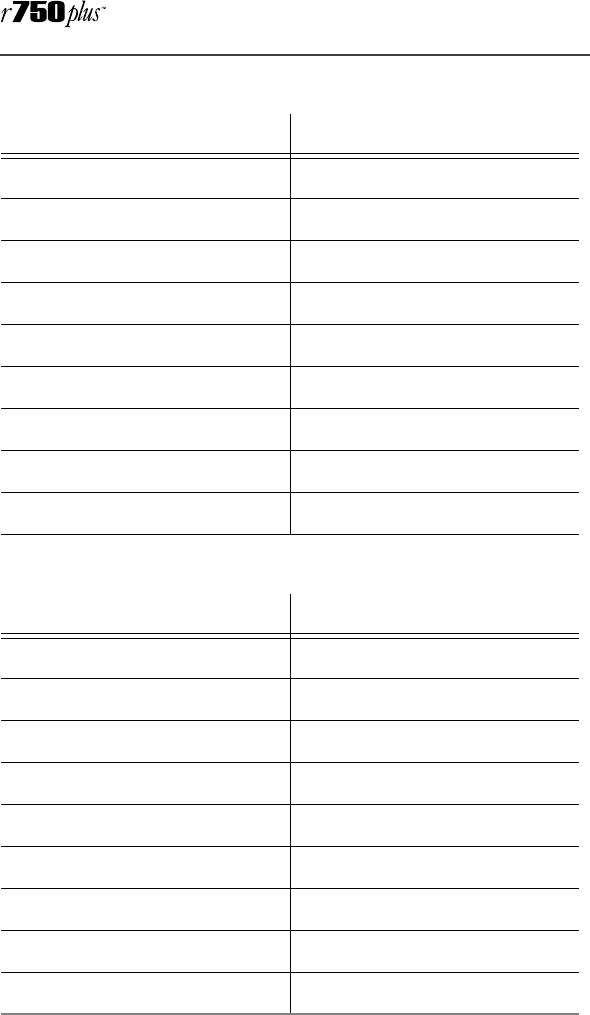
96
www.mot.com/iDEN
Private Number Directory
Talkgroup Directory
Private Number Name
1
2
3
4
5
6
7
8
9
Talkgroup Number Name
1
2
3
4
5
6
7
8
9